

















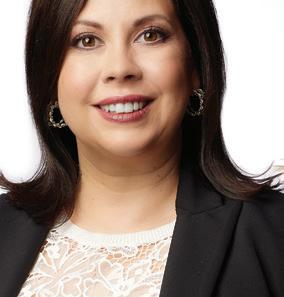





















































The 2024 Powered by Women honorees reflect on the challenges of leadership, and the lessons learned from their mentors.




$5.95 July/August 2024 dbusiness.com




PROVIDING EXPERTISE AND MANAGEMENT FOR EACH PHASE OF YOUR CONSTRUCTION PROJECT FOR 100 YEARS We proudly announce and launch our 100th year in business, representing the 4th generation within the family. Our success has been shaped by the dedication of our team, the support of our partners, and the trust of our valued clients. We are a general contractor and construction management firm,with specialties in commercial, multi-family, industrial, and institutional markets. Our exemplary work, and commitment to budgets and timelines, has resulted in long-standing relationships and a high degree of confidence with our clients. gleesonconstructors.com















































586-739-7900 | ROZAFATRANSPORT.COM SPRINTER VANS & STRAIGHT TRUCKS A BROKERAGE DIVISION HELPING CUSTOMERS TAKE ADVANTAGE OF OUR ADDITIONAL CAPACITY THROUGHT THE COUNTRY. OVERSIZED LOADS Specialized Transportation & Logistics Solutions



07- 08.24 28 Digital Unicorn 32 Watershed Moment 45 Powered by Women
As a developer of productivity software and video games in Plymouth
is no longer
most
company you’ve never heard
PERSPECTIVES: From a Lake Erie marsh to the Keweenaw Peninsula, The Nature Conservancy preserves land and undertakes conservation projects across Michigan. Sound business practices help the nonprofit share the land with the general public. By Ronald Ahrens Please join us in celebrating — and learning from — the 2024 class of Powered by Women, as selected from reader nominations. By Dale Buss, Tim Keenan, and Tom Murray CONTENTS 55 What’s on Tap? The NFL Draft gave Detroit a chance to shine on a global stage. Now, the challenge is to capitalize on that success. By Dan
and Michelle
8 DBUSINESS || July - August 2024 55 TRAVIS CLEVELAND
FOCUS:
Township, Stardock
“the
famous
of.” By Ronald
Ahrens
Calabrese
Cohl
Tomorrow is an open road full of possibilities.
Tomorrow is on.SM
You never forget a good road trip: the wind between your fingers, the sun against your cheeks. And just as you remembered it then, the great, epic road trip will live on to be experienced again tomorrow. At Enbridge, we’re investing more than $1 billion a year in renewables and lower-carbon solutions, so you can look forward to your next big adventure.
Learn more at tomorrowison.com








With the largest concentration of electrical, industrial, and mechanical engineers in the country, Michigan is tapping that technical expertise to be at the forefront of the aerospace sector.
16 FIX WHAT’S BROKEN
Few business owners would borrow money from lending organizations that dictate how the loan would be spent. But Democrats in the Michigan Legislature are moving a series of bills that would attach plenty of strings to funds borrowed by companies seeking to tap into the proposed Michigan 360 program.
16 PROMISING BENEFITS
A new report highlights the potential for a vast domestic source of lithium that could be used in batteries for electric vehicles and electronic devices.
18
How outsiders view Detroit.
21 COCOA QUIX
David Ogloza, a native of Belgium, is expanding his Ferndale-based artisanal chocolate shop. By R.J. King
23 TAIL RUNNER
Little Bay Boards in Petoskey crafts ornate wood paddleboards free of toxic materials. By Seth Schwartz
23 WORKING WITH WEED
Michigan and Missouri led the nation by adding more than 10,000 cannabis industry jobs each in 2023, according to Denver-based Vangst. By Jim Stickford
24 POWERED BY YOUTH
Detroit Catholic Central High School 2024 graduate Angelo Boukouris brings in $25,000 with a website and app design business he started prior to his senior year. By Tim Keenan
24 PDA Q&A
Tammy Carnrike, COO, Detroit Regional Chamber. By R.J. King
26 SEAM LINE
If James Bond ever needs a master tailor, Aaron John would be up for the job. By R.J. King

26 GREEN SCENE
Michigan Central Station in Detroit has unveiled the first renderings of a new 8-acre public park that’s under development on a former rail yard located behind the building. By R.J. King
Exec Life
76 THE YOUNG CLASSICS
Against significant odds, three high school sophomores from Northville managed to plan and host an annual Concours d’Elegance. By Dan Calabrese
79 RETURN ON INVESTMENT
Native App: Detroit native Tiffany Moore, who was raised by a single mother, along with a group called the “godmothers,” today helps lead the Consumer Technology Association. By Tom Murray
82 PRODUCTION RUN
Full Body: Great Lakes Malting Co. in northern Michigan gives a whole new meaning to farm-to-glass. By Seth Schwartz
84 PATENTS AND INVENTIONS
Mix of Fate: Mabel White Holmes, of Chelsea, built Jiffy ready-mix biscuits into a global brand. By Norm Sinclair
87 OPINION
Legacy of Women Leaders: The Downtown Detroit Partnership and its predecessors have long been led by women who have embraced the goal of making the city a world-class destination. By Lila Asante-Appiah
88 THE CIRCUIT
Our party pics from exclusive events.
Et Cetera
92 FROM THE TOP Largest Accounting Firms in Metro Detroit, Largest Banks and Thrifts in Metro Detroit, Largest Credit Unions in Metro Detroit, Corporate Aviation.
98 CLOSING BELL
Damsels of Design: In the 1950s, market trends and a spirit of innovation prompted General Motors’ styling boss, Harley Earl, to hire the first coterie of women designers. By Ronald Ahrens
ON THE COVER
Photography by Matthew LaVere, with Rebecca Simonov and Bryan Esler
Compositing by Stephanie Daniel
16 AERIAL NETWORK
COMPENDIUM
12 LETTER FROM THE EDITOR 12 READERS' LETTERS 14 CONTRIBUTORS
Commentary Foreword The
07- 08.24 CONTENTS
Ticker
82 BETH PRICE 10 DBUSINESS || July - August 2024

Strategic corporate solutions are our business.
No matter what your industry, from healthcare to oil and gas, public sector and expertise to ensure their success.
We offer commercial payments and investment banking as well as employer from our industry experts. For business executives and owners, we are truly your full-service bank
Securities products and services such as investment banking and capital raising are offered by KeyB anc Capital Markets Inc., Member FINRA /SI PC. KeyB anc Capital Markets Inc. and KeyB ank National Association are separate but affiliated companies. Securities products and services: Not F DI C Insured • No Bank Guarantee • May Lose Value All merchant services, credit, loan and leasing products are subject to collateral and/or credit approval, and terms of service. SBA Preferred Lender. Banking products and services are offered by Key B ank National Association. Key.com is a federally registered service mark of KeyCorp. ©2024 KeyCorp. KeyBank is Member FDIC. 210827-1217128
key.com/commercialbanking
Davi d Mannarino 400 0 Town Center, Suite 1260 • Southfield, MI 48075 David_Mannarino@keybank.com 248-204-6550

Detroit United
Never underestimate the ability of sports and entertainment to unify people.
district, to the tune of some $10 billion. In 2017, Little Caesars Arena arrived.






Now comes Michigan Central, the former train station that was Detroit’s last poster child of decline. When the nal train left the station in 1988, prospects for the city’s rebound included tearing down the historic structure.



BUSINESS LAW SYMPOSIUM






No matter the city’s condition in recent decades, witness the grandeur of Opening Day for the Detroit Tigers, or the electric atmosphere when one of our sports teams is in the hunt for a championship title.



On those rare occasions when sports and entertainment meld into an even larger event like the NFL Draft, held in downtown Detroit from April 25-27, a record crowd of more than 775,000 people showed the world the Motor City had nally been transformed into a Midwest metropolis from a 60-year disaster zone.
But all that changed six years ago when Bill Ford, executive chair of Ford Motor Co., acquired Michigan Central and several neighboring properties. e goal, $1 billion in the making, is to attract businesses and organizations to the burgeoning 30-acre mobility innovation campus.



e city’s comeback began in the mid-1980s, when the late Chuck Forbes began buying Detroit’s once grand theaters, including the Fox, State, Gem, and Century. In 1987, he sold the Fox to Mike and Marian Ilitch, and what followed was the arrival of Little Caesars and new side-by-side stadiums for the Tigers and the Detroit Lions.
Along the way, in 1996, General Motors acquired the Renaissance Center for its global headquarters. While next year the automaker will vacate the RenCen for new space in Dan Gilbert’s Hudson’s development, the riverfront landmark o ers plenty of opportunity for added hotel rooms, residences, and commercial spaces.
In 2003, Peter Karmanos Jr. led the drive to build Compuware’s headquarters at the north end of the newly installed Campus Martius Park. at brought 4,000 workers to the city center, which helped attract Gilbert and his Rocket Family of Cos.
From there, Gilbert invested in restoring dozens of historic structures in the central business
at momentum helped draw in the owners of the Detroit City Football Club. In May, the organization acquired the former Southwest Detroit Hospital at Michigan Avenue and 20th Street. It plans to raze the building and replace it with a soccer-speci c stadium in time for the club’s 2027 season.
e venue will likely be open-air with natural grass, o er around 14,000 seats, and be used by both men’s and women’s teams. It also could attract a Major League Soccer team, as well as host concerts and other activities.
To expand outward from the stadium’s potential, the city will likely move a neighboring public works yard at 19th Street to the former Michigan State Fairgrounds site. en, to stitch everything together from the convergence of Corktown, Mexicantown, and southwest Detroit to the rest of the region, look for a potential new Amtrak station to be built just west of Michigan Central.
With all that’s happening, Detroit has shown that sports and entertainment are a foundation for economic growth — attracting businesses, residents, and visitors alike. e trick for moving it all forward is to keep working hard and follow our aspirations as we “rise from the ashes” and “hope for better things.”
R.J. King rjking@dbusiness.com
Thank you very much for your continued support and sponsorship of the Business Law Symposium. (It’s) much appreciated. And thank you for the wonderful photo spread.
Mark C. Rossman Troy
KMART HQ TRANSFORMATION
I thought the article in DBusiness Daily News about the University of Michigan-Health was the “final chapter” on Kmart. Nicely done and a good memory. Several things hit home, and hit home again reading Norm Sinclair’s “Polyester Palace” (May/ June 2010). It magnified “what could have been” and was just fumbled away. I sent the article to several folks from out of town who don’t get the magazine. This was my introduction to Norm, and this article is another outstanding example of his talents.
Jim Carlson Clarkston
ROOSEVELT PARK
I wanted to send a quick note of thanks for the Roosevelt Park/Michigan Central Station piece in the May/June issue. Jon (Kramer) really enjoyed his chat with you and the story looks great. Thanks again so much and (we) hope to work with you again soon.
Jamie Rothfeld Chicago
EMAIL US AT: editorial@dbusiness.com SEND MAIL TO: Letters, DBusiness magazine, 5750 New King Drive, Ste. 100, Troy, MI 48098 Please include your city of residence and daytime phone number. We reserve the right to edit letters for length and content.
Letters 12 DBUSINESS || JULY - AUGUST 2024
ness the grandeur of Opening
R.J. KING

Business leaders say they trust the attorneys of Plunkett Cooney to anticipate legal pitfalls, to resolve high-stakes litigation and to craft contracts they can sign... with confidence. See your business differently. Get the Plunkett Cooney perspective.
n Appellate Law n Banking, Bankruptcy & Creditors’ Rights n Business Transactions n Cannabis Law n Commercial Litigation n Estate Planning & Business Succession n Foodservice & Hospitality Law n Government Relations & Public Policy n Health Care Law n Labor & Employment Law n Mergers & Acquisitions n Nonprofit Law n Real Estate Law n Tax Law n Zoning, Planning & Permitting
Michigan | Ohio | Indiana | Illinois | www.plunkettcooney.com ® Get the Plunkett Cooney Perspective™
ATTORNEYS & COUNSELORS AT LAW Jeffrey C. Gerish President & CEO 248.901.4000 | jgerish@plunkettcooney.com

CONTRIBUTORS SETH SCHWARTZ
Seth Schwartz is a new contributing writer for DBusiness. He covered high school sports for the Chicago Sun-Times, and contributes to The Wall Street Journal real estate section. Schwartz also writes for The Local Palate, Block Club Chicago, and Sailing Anarchy. He covers food, spirits, small businesses, and real estate. He also was the executive producer for documentaries on former Jackson State quarterback Roy Curry, former Cleveland Browns and Dallas Cowboy scout John Wooten, and Tampa’s Oliva cigar family. In this issue, Schwartz explores Little Bay Boards, a custom wood paddleboard company in Petoskey, and Great Lakes Malting Co., located south of Traverse City.
BETH PRICE
Beth Price is an editorial and commercial photographer based in northern Michigan. She’s a visual storyteller who advocates for people, businesses, and causes that deserve attention. Her images, which have appeared in Traverse Magazine, Michigan Runner Girl, Grand Traverse Woman Magazine, Boarder’s Magazine, Men’s Journal, and Northwest Michigan Second Wave Magazine, are purposeful, thoughtful, and connecting. She also has several corporate clients. Price says she’s passionate about the Great Lakes region and is dedicated to ensuring its protection for generations to come. In this issue, Price photographed Great Lakes Malting Co., south of Traverse City, for Production Run.


Paige Tushman is working as an intern at Hour Media for the summer of 2024. She’s entering her junior year at the University of Michigan in Ann Arbor, majoring in art and design. As part of her internship, Tushman has been actively collaborating with the marketing, digital, and editorial teams. She helped conceptualize marketing and event plans for key events such as the DBusiness 30 in Their Thirties Breakfast Series and the Detroit Design Awards, both in May, and the Best of Detroit Party in late June. She also has been helping out on photo shoots. For this issue, Tushman assisted during the Powered by Women studio portraits. Her experience at Hour Media, she says, has been decidedly cross-functional.
Matt Cappo
SR. DIGITAL DEVELOPMENT SPECIALIST Luanne Lim DIGITAL DEVELOPMENT SPECIALIST Connor McDonald IT IT DIRECTOR Jeremy Leland
CIRCULATION
CIRCULATION MANAGER Riley Meyers
CIRCULATION COORDINATORS David Benvenuto, Susan Combs, Cathy Krajenke, Rachel Moulden, Michele Wold
MARKETING AND EVENTS
MARKETING AND EVENTS MANAGER Jodie Svagr
MARKETING AND EVENTS COORDINATOR Jaime Presnail
COMMUNICATIONS AND PR Regan Blissett
MARKETING AND EVENTS ASSISTANT Crystal Baker
WEDDINGS ACCOUNT MANAGER Karen Wilkie
MARKETING AND EVENTS INTERNS: Samantha Boeskool, Anna Forberg, Erin Timmis
EVENT DESIGN INTERN: Paige Tushman
MARKET RESEARCH
MARKETING RESEARCH DIRECTOR Sofia Shevin
MARKETING RESEARCH COORDINATORS Alyssa Fueri, Kristin Mingo
MARKETING RESEARCH SALES COORDINATOR Alex Thompson
MARKETING RESEARCH SALES ASSISTANT Theresa Lowery
GRAPHIC DESIGNER Kendra Okamoto
MARKETING RESEARCH INTERNS Grace Grandelius, Sarah Helling, Natasha Samsonov
BUSINESS
CEO Stefan Wanczyk
PRESIDENT John Balardo
DIRECTOR OF BUSINESS OPERATIONS Kathie Gorecki
SENIOR ACCOUNTING ASSOCIATE Andrew Kotzian
ACCOUNTING ASSOCIATES Dian Mauro, Austin Schmelzle
DISTRIBUTION Target Distribution, Troy
CONTRIBUTING WRITERS
Ronald Ahrens, Lila Asante-Appiah, Dale Buss, Dan Calabrese, Tom Murray, Seth Schwartz, Norm Sinclair
CONTRIBUTING ARTISTS
Rebecca Di
Cleveland, Patrick Gloria, Christine MJ Hathaway, Ryan Hermes, Matthew LaVere, Drew Lenhert,
VannoJason Whalen, James
Ziegler CONTRIBUTION: Writer, Ticker, Production Run | SEE IT HERE: Page 23, 82 CONTRIBUTION: Intern, Powered by Women | SEE IT HERE: Cover and Page 45 CONTRIBUTION: Photographer, Production Run | SEE IT HERE: Page 82
Angelo, Ami Nicole ‘Acronym’, Travis Cleveland, Bryan Esler, Fauna Creative, Travis
Devin Leonarduzzi, Nassereen Mirza, Beth Price, Lindsay Schweickert, Becky Simonov, Scott Suriano, John Den
Uyl, randon
Yang, Chase
PAIGE TUSHMAN
Postmaster: Send address changes to DBusiness, 5750 New King Drive, Ste. 100, Troy, MI 48098 For advertising inquiries: 248-691-1800, ext. 126 To sell DBusiness magazine or for subscription inquiries: 248-588-1851 DBusiness is published by Hour Media. Copyright © 2024 Hour Media. All rights reserved. Reproduction in whole or in part without permission is prohibited. DBusiness is a registered trademark of Hour Media. DETROIT’S PREMIER BUSINESS JOURNAL VOLUME 19 • ISSUE 4 PUBLISHER Jason Hosko EDITORIAL EDITOR R.J. King MANAGING EDITOR Tim Keenan COPY EDITOR Anne Berry Daugherty DESIGN CREATIVE DIRECTOR Lindsay Richards ART DIRECTOR Justin Stenson SENIOR PRODUCTION ARTIST Stephanie Daniel JUNIOR ART DIRECTOR Steven Prokuda ADVERTISING SALES ACCOUNT EXECUTIVES Cynthia Barnhart, Hannah Brown, Karli Brown, Cathleen Francois, Aubrey Kapala, Donna Kassab, Lisa LaBelle, Carol Lawrence, Andrew Nolan, Mary Pantely & Associates PUBLISHING & SALES INTERN: Eden Amcheslavsky PRODUCTION PRODUCTION DIRECTOR Jenine Knox SENIOR PRODUCTION COORDINATOR Jill Berry PRODUCTION COORDINATOR Amanda Kozlowski ACCOUNT MANAGER Elizabeth Kowalik HOUR CITY STUDIOS VIDEO PRODUCER Nicole Toporowski DIGITAL DIRECTOR OF DIGITAL STRATEGY Travis Cleveland DIGITAL DEVELOPMENT MANAGER
Contributors 14 DBUSINESS || July - August 2024

07- 08.24 COMMENTARY 16 I LOOK FORWARD TO A FEW YEARS FROM NOW, WHEN DETROIT ONCE AGAIN HAS A TRULY STATE-OF-THE-ART AIRPORT WITHIN OUR CITY LIMITS.” —BRAD DICK, COO, CITY OF DETROIT p. 16 p. 18 Aerial Network Fix What’s Broken Promising Benefits Compendium
YANG July - August 2024 || DBUSINESS.COM 15
JAMES
AEROSPACE
Aerial Network
With the largest concentration of electrical, industrial, and mechanical engineers in the country, Michigan has long been a leader in automotive and ground transportation. Now it’s tapping that technical expertise to be at the forefront of the aerospace sector.
In April, the Michigan Department of Transportation Office of Aeronautics announced it had selected two companies to establish a ground-to-air communications mesh test deployment in the state. The effort will explore how best to utilize a communications platform to support beyond visual line of sight unmanned aircraft deployments.
INSIDE THE NUMBERS
Aerospace-related companies in Michigan
Airspace Experience Technologies (ASX) in Detroit, working with WSP, a professional services firm, is now developing and testing a unique traffic management system leveraging automotive electric vehicle technologies and V2V2I (vehicle-to-vehicle-to-infrastructure) short-range wireless communication systems.
“We believe connected vehicle technology developed for terrestrial vehicles can be deployed to manage aerial vehicles, as well, and our preliminary testing results have been very favorable,” says Walton Fehr, AeroNet architect for ASX. The company began researching and developing the approach in 2015, and has applied for various patents on back office command and control criteria.
If successful, ASX’s AeroNet aerial intelligent transportation system architecture would equip all aircraft and airports in Michigan with new sensors. The goal is to use the technology to establish a safe and reliable national standard for communicating between aircraft, airports, and ground transportation systems.
In essence, the operational system would provide air traffic controllers with a clear picture of what’s in the sky, including large aircraft, corporate jets, planes, helicopters, and drones. In this way, all aircraft would have dedicated flight paths — so, for example, helicopters and small drones would be safer to operate.
ASX designs and builds electric vertical take-off and landing aircraft, along with related technologies, to enable autonomous air mobility between cities, airports, and suburbs. The company’s eVTOL — the SIGMA-6 — offers the capability to connect national and international logistics, as well as take commuters out of traffic and into the air.
The company designs and builds eco-friendly, quiet, and fully connected aircraft that offer vertical take-off and landing capabilities. Applications include cargo logistics, defense, first response, and future air taxi operations. Given the nation’s congested roads, along with the advancing age of truck drivers, moving more cargo by air would help extend the life cycle of roads, bridges, and ramps.
Much of the initial work on AeroNet is being tested at the Coleman A. Young International Airport in Detroit. That makes sense, given in May city officials announced that Detroit City Airport had received FAA approval to institute a 20-year airport development and strategy design plan to support future noncommercial aviation operations.
GOVERNMENT
FIX WHAT’S BROKEN
FEW BUSINESS OWNERS would borrow money from lending organizations that dictate how the loan would be spent. But Democrats in the Michigan Legislature are moving a series of bills that would attach plenty of strings to funds borrowed by companies seeking to tap into the proposed Michigan 360 program.
Hoping to draw some $250 million annually from the Strategic Outreach and Reserve Fund, or SOAR, the money for Michigan 360 would be used to subsidize community investment. One of the biggest issues with the proposal, and there are many, is it would direct what are business attraction tools to pay for existing subsidized programs like internet lines, child care, affordable housing, and workforce training.
One major issue with the proposal, sponsored by Sen. Mallory McMorrow, D-Royal Oak, is the state would be in the business of picking winners and losers. State officials could dictate that recipients of the funds have a unionized workforce, work only with other businesses that belong to a labor union, or support radical green initiatives.
With the state falling further behind since Gov. Gretchen Whitmer took office in 2019, as witnessed by a steady decline in state rankings for businesses on multiple metrics (public education, population loss, Right to Work, and more), citizens would be much better off if the state actually fixed its programs that aren’t working.
PROMISING BENEFITS
A NEW REPORT HIGHLIGHTS the potential for a vast domestic source of lithium that could be used in batteries for electric vehicles and electronic devices. By processing byproducts from natural gas production, a University of Pittsburgh study shows thousands of tons of lithium could be produced annually from wastewater generated via fracking.
The process, which shows immense promise, would boost the American labor force and, at the same time, lessen the country’s dependence on rare earth metals from Africa and China, both of which use forced labor, including children. An EV battery today requires around 18 pounds of lithium to produce energy.
One estimate shows 40 percent of lithium demand in the United States could be generated by vast natural gas supplies in the Marcellus Shale basin, which spans Pennsylvania, New York, Ohio, and West Virginia. Rather than mine for lithium, an expensive process, study researchers state the mineral could be more easily extracted by processing wastewater from fracking.
With the news, America now has an opportunity to satisfy rising demand for rare earth metals. In addition to lowering costs, extracting more minerals closer to home would offer another buffer against the country’s growing reliance on imported energy elements, which is being pushed by the Biden administration.
TOP
ENERGY
Workers in Michigan employed in advanced manufacturing industries
attractiveness Source: Michigan Economic Development Corp.
Michigan
ranks within
the top 10 states for aerospace manufacturing
COMPANIES 63 THOUSAND STATES 10 Commentary 16 DBUSINESS || July - August 2024
600
Delta Dental supports women’s health through our exceptional dental and vision benefit plans.
Congratulations to the honorees of DBusiness’ Powered By Women.
Empowering women... One smile at a time. DeltaVision®
Delta Dental of Michigan
COMPENDIUM: HOW OUTSIDERS VIEW DETROIT
NFL
DRAFT: FOOTBALL’S BOOMTOWN IS DETROIT
YAHOO SPORTS
APRIL 25, 2024
BY DAN WETZEL
The 2024 NFL Draft is set up downtown, serving as the glitzy center of the football universe this weekend. Just blocks away sits Ford Field, where the Detroit Lions won two playoff games in January.
And yet, if you really want to know why Detroit, long marketed as “Hockeytown” and historically an incubator for churning out elite basketball talent, is currently America’s football boomtown, you need to head out to the neighborhood fields and high school stadiums across this sprawling city.
It’s there, far from the spotlight and celebrities, where the NFL comes from — and they are coming in quantities that not just outpace the rest of the country and exceed historical norms but, per local coaches, are likely to increase.
“It’s completely different from even 20 years ago, Detroit is transitioning from a basketball town to a football town,” said Terel Patrick, head coach at King High School, which has produced a slew of college and NFL stars, including New York Jets All-Pro cornerback Sauce Gardner.
“I see so much growth right now,” said Marvin Rushing, the head football coach at Cass Tech, which had five alums play in the NFL last season, including New England OL Michael Onwenu and Lions WR Donovan Peoples-Jones. “There is more talent and a real hunger for the game at the youth level.”
It’s already started bubbling up. On opening day of the 2023 NFL season, Detroit, the 27th-most populous city in America, had more players (19) from its high schools on league rosters than anywhere else. The closest comparable was Houston, with 16. It also has a population (2.3 million) that is nearly four times that of Detroit’s 640,000. …
DETROIT’S POPULATION REBOUNDS SLIGHTLY, CENSUS BUREAU ESTIMATES
16, 2024
America’s Northeast and Midwest cities are rebounding slightly from years of population drops — especially Detroit, which grew for the first time in decades — though the South still dominates the nation’s growth, according to U.S. Census Bureau estimates released Thursday.
in pure numbers last year, adding about 22,000 residents. It was followed by other Southern cities, including Fort Worth, Texas; Charlotte, North Carolina; Jacksonville, Florida; and Port St. Lucie, Florida.
Three of the largest cities in the U.S. that had been bleeding residents this decade staunched those departures somewhat. New York City, which has lost almost 550,000 residents this decade so far, saw a drop of only 77,000 residents last year. …
Detroit, Michigan’s largest city, had seen an exodus of people since the 1950s. Yet the estimates show the population of Michigan’s largest city rose by just 1,852 people, from 631,366 in 2022 to 633,218 last year.
It’s a milestone for Detroit, which had 1.8 million residents in the 1950s, only to see its population dwindle and then plummet through suburban white flight, a 1967 race riot, the migration to the suburbs by many of the Black middle class and the national economic downturn that foreshadowed the city’s 2013 bankruptcy filing.
“It’s a great day. It’s a day we’ve been waiting for for 10 years,” Mayor Mike Duggan told The Associated Press. “The city of Detroit has joined the communities in America that are growing in population according to the Census Bureau. For our national brand, it was critically important for the Census Bureau to certify us as growing.”
Modest reversals of population declines also were seen last year in other large cities in the nation’s Northeast and Midwest, while the census estimates showed 13 of the 15 fastest-growing cities in the U.S. were in the South — eight in Texas alone.
San Antonio, Texas, had the biggest growth spurt
MORE TO DOWNTOWN REVIVAL THAN A STADIUM, LOOK AT DETROIT AND ITS RIVERFRONT
THE FLORIDA TIMES-UNION • JUNE 5, 2024 • BY MARK WOODS
A follow-up to my last column, about how it would be a shame if we can find money for renovating a stadium but not for finishing our riverfront parks.
I recently went to Detroit. My sister, an engineer for GM, lives and works north of the city. Her son was graduating from college and she knew how to further entice me to make the trip: The Tigers, the baseball team my childhood revolved around, were in town.
It had been years since I went to a game in Detroit. It was a beautiful April night, with a lot for people there to cheer about. And not just because the Tigers rallied to beat the Kansas City Royals at Comerica Park.
At one point, the fans began a chant of “Jared Goff, Jared Goff” — the Lions quarterback who plays his home games in nearby Ford Field — that wasn’t as random as it sounded.
It was the weekend of the NFL Draft. The league estimated that nearly 800,000 fans filled downtown over the three days, setting the attendance record for the event. The streets were packed with people eating, drinking and checking out shops brimming with Detroit pride. Shinola watches and bikes. “Made in Detroit” T-shirts. Merchandise that said both “Detroit Welcomes Everybody” and “313 vs. Everybody.”
The 904 isn’t the only place that can lean into its area code and a sense of being the underdog.
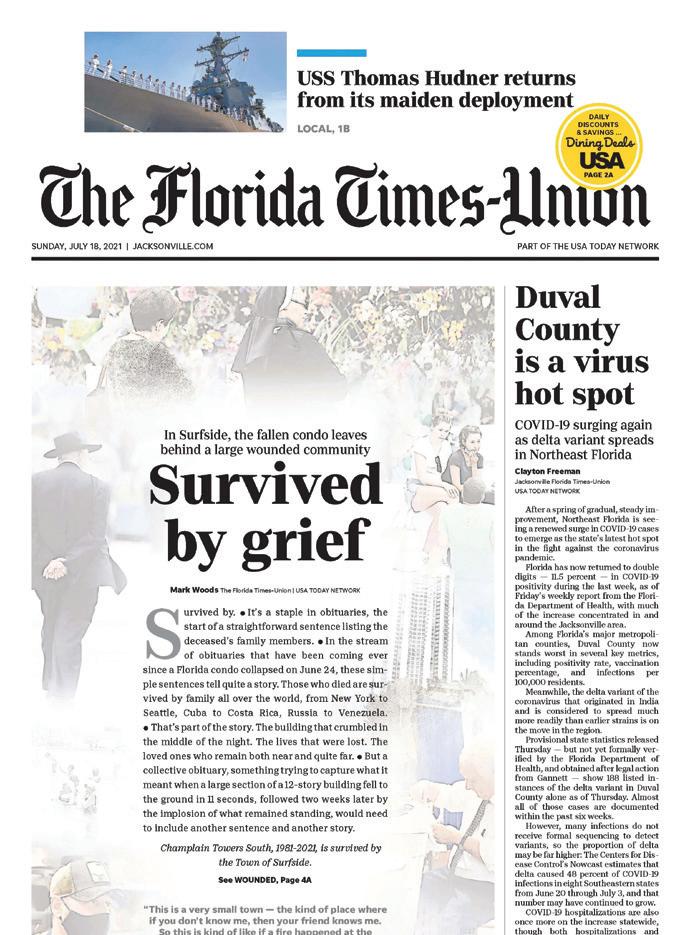
Downtown Detroit on the rise
It reminded me of when we had the Super Bowl in Jacksonville, how during that one week our streets and riverfronts were full of people and activity. I couldn’t help but wonder what downtown Detroit would be like once the big event left.
There’s reason to believe it wasn’t just a one-weekend thing.
Detroit, for all of its problems, has experienced a rebirth. Downtown is a different place than what I remember, and what many Americans still picture: a hollowed-out, crime-ridden, decaying shell of a once-vibrant city. That’s not to say Detroit doesn’t still have plenty of issues. But it also has reason for hope — and reasons for people to be living, working and playing downtown.
In the 1990s, when I covered the Tampa Bay Buccaneers, I made a trip to Detroit every fall for a Bucs-Lions game. Well, sort of. I flew into Detroit, got a rental car and drove about an hour north to Pontiac and the Silverdome. At the time, the NBA’s Pistons played even farther from downtown, in the Palace of Auburn Hills.
Now four major pro franchises play downtown: the Tigers at Comerica (opened in 2000), the Lions at Ford Field (2002), and the Pistons and NHL’s Red Wings at Little Caesars Arena (2017). Also, soccer club Detroit City FC is planning to build a new stadium in Corktown, an old neighborhood described in a recent Detroit Free Press story as the “front porch to downtown.” …
PBS MAY
BY THE ASSOCIATED PRESS
Commentary 18 DBUSINESS || July - August 2024

PRUETT’S COOLDOWN LAP: DETROIT
RACER • JUNE 3, 2024 • BY MARSHALL PRUETT
Well, that was embarrassing. It’s time for Penske Entertainment, the promoter of the Chevrolet Detroit Grand Prix, to accept the fact that it has a terrible race on its hands.
And there’s no need to beat them up over it. They tried to do something bigger and better than where the race was previously held just down the road at Belle Isle, and it just hasn’t worked on the competition side.
I’m sure there are marketing and promotional benefits to running it in its new downtown location, but do those things matter if the main purpose for the event — the racing itself — is mostly terrible?
If Penske Entertainment is set on staying where it is, reconfigure the track to create more passing opportunities so Turn 3 isn’t the world’s longest fun-time alley where half of the cars serve as bowling balls and the other half play the role of pins. Or go back to Belle Isle at the earliest opportunity, which most drivers love and miss.
The first IndyCar race on the new layout in 2023 generated seven cautions and 32 laps behind the pace car, or 32 percent of the 100-lap race. On its return, the cautions were just upped to eight and 47 percent of the race was spent trailing the Corvette pace car — 47 of the 100 laps — and, no joke, the hot rod kept so busy, it required a pit stop of its own for refueling.
IMSA’s WeatherTech SportsCar Championship race on (June 1) had five cautions as 21 of its 75 laps were run under yellow; that’s a measly 28 percent. Its first appearance in 2023, albeit with the second-tier Michelin Pilot Challenge series, was downright clean as only 12 of its 71 laps were spent behind a pace car, all from the lone caution after one sedan vaulted another in Turn 3 and made headlines for the incident that consumed 17 percent of the race.
On average across its Saturday-Sunday headliners with IndyCar and IMSA over the last two downtown Detroit events, 31 percent of the racing has been held under
caution. For IndyCar alone, its average is 39.5 percent.
For the sake of comparison, the season-opening street race at St. Petersburg had three cautions and nine of its 100 laps (9 percent) were under yellow. Long Beach’s street race had one caution for four of the 85 laps (4.7 percent).
Barber was busier with four cautions across 15 of the 90 laps (16.6 percent) and the Indy GP featured one caution for two of its 85 laps (2.4 percent).
Even the Indy 500, which can be a yellow-fest at times, was tame when positioned next to Detroit. It matched the number of cautions with eight, and put up 47 laps behind the pace car, but that only equated to 23.5 percent of the 200-lap race.
Detroit is the new Nashville Grand Prix, “Crashville,” as it was dubbed, since its street race has been shifted to Nashville Speedway, and that’s not a good thing.
FORD RESCUES DETROIT TRAIN STATION AS IT PLOTS ITS OWN FUTURE
THE NEW YORK TIMES JUNE 3, 2024 BY
ALLAN LENGEL
When he was growing up in southwest Detroit, Cristian Rubio was never all that curious about the shuttered train station that loomed over his neighborhood. The building, a couple of miles west of downtown, was among the city’s most visible symbols of urban decay and a go-to for photographers who wanted to capture its decline.
Mr. Rubio’s interest intensified in high school,
after he watched the 2009 music video “Beautiful,” which showed the hometown rapper Eminem walking through the ravaged Beaux-Arts building with its vaulted ceilings and tall columns, broken windows, rainbow gra ti and smashed fixtures.
Ever since, “I wanted to go in whether it was abandoned or not,” said Mr. Rubio, 29, the manager of a Mexican restaurant, who moved to southwest Detroit from Jalisco, in west central Mexico, 20 years ago. “Now we have a chance to do it.”
The Ford Motor Co. bought Michigan Central Station in 2018 from the wealthy Moroun family for $90 million and has since spent hundreds of millions of dollars to restore it to its original beauty. Ford’s plan is to create a hub of collaboration and innovation with its workers and independent startups and businesses involved in mobility and transportation issues. Additionally, it hopes to make the station a community gathering place with retail shops, a destination restaurant, an event space, a hotel and possibly Amtrak service nearby in the future.
On June 6, Mr. Rubio intended to be among the 15,000 people attending an outdoor concert, with Eminem and others appearing, to celebrate the o cial reopening.
The station, which was completed in 1913, saw more than 4,000 passengers daily at its peak in the 1940s. It closed in 1988, eventually becoming a magnet for scrappers, vandals, gra ti artists, urban explorers and the homeless.
William Ford, the executive chairman of Ford Motor Company, now runs
the company his great-grandfather started in 1903. “Our industry is about to change radically, and that change ought to be invented here,” Mr. Ford said. “It clicked for me that was the perfect purpose for Michigan Central Station.” …
UNIVERSITY OF MICHIGAN ISSUES WARNING AFTER ‘DANGEROUS ESCALATION’ OF STUDENT PROTESTS
NEWSWEEK • MAY 16, 2024 • BY
MATTHEW IMPELLI
The University of Michigan issued a warning in May after what it called a “dangerous escalation” of student protests on the campus.
On May 15, the University of Michigan shared a statement saying that a group of approximately 30 student protesters “staged demonstrations at the private residence of at least one U-M Board of Regents member and went to several others’ residences.”
“Activities included placing tents and fake corpses wrapped in bloodied sheets on the lawn, marching and chanting, and posting demands on doors,” the statement said.
According to the statement, some student protesters hid their faces by wearing masks and the school said: “The tactics used today represent a significant and dangerous escalation in the protests that have been occurring on campus.”
The incident at the University of Michigan comes amid ongoing pro-Palestinian protests across di erent college campuses in recent months, with many calling for their schools to divest from Israel in response to their ongoing war with Hamas militants.
Tensions have remained high across college campuses since the October 7, 2023, attack by Hamas militants on Israel. The Palestinian militant group attacked southern Israel, killing over 1,200 people and taking over 200 more hostages. Israel followed by launching strikes against Hamas in Gaza that have left over 34,000 people dead, The Associated Press reported, citing Gaza health o cials. …



Commentary JULY - AUGUST 2024 || DBUSINESS.COM 19





















THE TICKER

R EBECCA SIMONOV SWEET PROCESS Quix Chocolate in downtown Ferndale is expanding this summer to Detroit Metropolitan Airport in Romulus. The company produces some 150 different confections at its Ferndale location. 07- 08.24
22 p. 22 p. 24 p. 26 Cocoa Quix Tail Runner Weed Works Young CEO PDA Q&A Seam Line Green Scene July - August 2024 || DBUSINESS.COM 21


Cocoa Quix
David Ogloza, a native of Belgium, is expanding his Ferndale-based artisanal chocolate shop across metro Detroit.
BY R.J. KING | REBECCA SIMONOV
After working abroad for 15 years, including as a senior manager at Deloitte in Hong Kong, David Ogloza wanted to recreate his family’s former chocolate shop in Belgium.
After settling in metro Detroit in 2018, he selected a 1,500-square-foot space in downtown Ferndale, where he established Quix Chocolate at 221 W. Troy St. The store’s opening on July 21, 2021, coincided with Belgian National Day, a holiday that commemorates the investiture of Leopold I, the first king of the Belgians, in 1831.
Sales took off almost immediately, and today Ogloza is planning to open a location at Detroit Metro Airport in Romulus in August, and is eyeing other potential sites in downtown Birmingham and downtown Northville.
“Along with creating our chocolates and other confections, we consider ourselves more of a gift shop,”
DBUSINESS DIRECT
UWM in Pontiac Debuts 0% Down Program
United Wholesale Mortgage announced a 0% Down Purchase to help more borrowers become homeowners. It allows qualified borrowers to receive a 3 percent down payment assistance loan of up to $15,000 from UWM.
SUGAR BLOOM
David Ogloza, president and owner of Quix Chocolate in downtown Ferndale, is following in his family’s footsteps. His aunt and uncle operated a chocolate shop in Belgium for several decades.
Detroit City FC Buys Land For Soccer-specific Stadium
The Detroit City Football Club has acquired the 5.7-acre site of the former Southwest Detroit Hospital at the corner of Michigan Avenue and 20th Street to build a new soccer-specific stadium by 2027.
says Ogloza, president and owner of Quix Chocolate. “Christmas is our busiest time of year, followed by Valentine’s Day, Easter, Mother’s Day, and Thanksgiving.
“For Easter, (our biggest) sellers are chocolate-shaped hens; for Thanksgiving, chocolate-shaped turkeys are very popular. People like to use them as centerpieces, and then share them as part of dessert.”
Belgium is home to some of the top chocolate brands in the world, including Côte d’Or, Godiva, Leonidas, and Neuhaus. Ogloza says his uncle and aunt, Marcel Jeandarme and Mariette Quix (pronounced Kwix), started experimenting with making chocolate in 1946 in the basement of their home in the Dutch-speaking province of Limburg. Three years later, they opened Chocoladehuis Quix in Lanklaar, where they made chocolate from imported cocoa beans.
The couple built up early accounts with bakers and shops in some of Belgium’s largest cities, including Antwerp, Brussels, Gent, and Liege. The confections also were sold in France, Germany, and Dutch provinces.
“By the late 1980s, my aunt and uncle were looking to modernize and expand the business, but there were no heirs so they closed the company,” Ogloza says. “But in the back of my mind, I always wanted to open a chocolate shop.”
Sourcing white and dark chocolate from Europe — including Callebaut, which was founded in Belgium in 1911 — the entrepreneur has a team of 11 employees, one of whom works full time. “We have people who have retired from their professional careers and want to make chocolate, as well as high school students,” Ogloza says.
Along with fulfilling mail orders that come in from across the continental United States and Hawaii, Quix Chocolate produces wholesale confections for retailers including Western Market and Holiday Market. In addition to making its own caramel, the shop produces a wide array of chocolate bars, cookies, candies, and specialty items. Overall, there are around 150 different selections priced from $3 to $100; average prices range from $4 to $15.
“We create everything on-site, and the coloring we use is edible ink,” Ogloza says. “We do specialty items for anniversaries or birthdays, and we supply bed and breakfast operations with chocolates. What’s a better way to start or end your day than with a piece of chocolate?”
City of Detroit Tallies First Population Growth Since ‘57
Detroit has gained population for the first time since 1957, according to new population estimates released by the U.S. Census Bureau. Detroit gained 1,852 residents between July 1, 2022, and July 1, 2023.
Tricia Keith Tapped to Lead
Blue Cross Blue Shield
Blue Cross Blue Shield of Michigan’s board of directors has appointed Tricia Keith as president and CEO-elect. Keith will be the company’s first female CEO when she succeeds Daniel J. Loepp following his retirement on Jan. 1, 2025.
Hansons in Troy Acquires
Virginia’s Paramount Builders Troy-based Hansons has acquired Paramount Builders in Virginia Beach, Va. Following the acquisition, Hansons will operate 23 branches across 14 states in the Midwest, Mountain West, Mid-Atlantic, and Southeast regions.
The Ticker 22 DBUSINESS || July - August 2024

WEED WORKS
MICHIGAN AND MISSOURI
LED THE NATION by adding more than 10,000 cannabis industry jobs each in 2023, according to research from Denver-based Vangst.
The 2024 Vangst Jobs Report, completed in partnership with Whitney Economics, examined each market’s specific regulatory environment, investment climate, cannabis license data, and past performance to document key changes within the legal cannabis industry and determine the number of full-time-equivalent jobs supported by the legal industry.
The report highlighted several positive trends within the legal cannabis industry, including job creation and sales growth. The legal cannabis industry added 22,952 new jobs in 2023 — a 5.4-percent year-over-year increase that brings the total number of full-time-equivalent jobs supported by the industry to 440,445.
The increase in full-time-equivalent jobs is due to the $28.8 billion worth of legal cannabis products sold in 2023 — an increase of $2.7 billion over the previous year.
“When we started Vangst, there were less than 50,000 full-time employees in the cannabis industry,” says Karson Humiston, founder and CEO of Vangst. “Less than a decade later, there are 440,445 full-time employees in cannabis; it’s a number that will continue growing.”
— By Jim Stickford
State Forms Office of Defense And Aerospace Innovation
The Michigan Economic Development Corp. has formed the Office of Defense and Aerospace Innovation (ODAI) to help grow the state’s defense and aerospace industry, building on the legacy of the Michigan Defense Center.
Tail Runner
Little Bay Boards in Petoskey crafts ornate wood paddleboards free of toxic materials.
BY SETH SCHWARTZ
Enjoying the afternoon at Good Harbor Beach in the Sleeping Bear Dunes National Lakeshore with his wife and two daughters, Jason Thelen borrowed his brother-in-law’s standup paddle board. After paddling out two miles on placid Lake Michigan waters, he sat down to quench a Corona.
“I really liked the simplicity of being by myself,” Thelen says of his summer 2011 memory. “I sat there for a half hour; it was super peaceful being on the water without hearing anything.”
A sixth-generation Petoskey native who’s related to Chief Ignatius Petoskey of the Odawa tribe, as well as a water enthusiast, Thelen says his brainwaves shifted into high gear.
“I knew I wanted to have a standup board myself, but the ones on the market were expensive, made out of toxic materials, and there were no used boards,” Thelen recalls.
A carpenter who’s worked with wood since age 8, he spent a year checking out a variety of boards. Following extensive conversations with Paul Jensen, inventor of the hollow-wood surfboard, he adapted concepts Jensen uses, and modified shapes and sizes for standup paddling.
After three months in his father’s garage woodshop, Thelen unveiled a standup board as a present for his 9-year-old daughter, Shawni, which coincided with the Fourth of July in 2012. Although he was satisfied with Shawni’s reaction, Thelen didn’t realize the ornate woodwork would pique public intrigue.
“If we were stopped at a light, people would roll down the window, and ask, ‘Hey, where’d you get that board?’ ” he says. “At Good Harbor Bay beach, over a dozen people would always come up, ‘Where’d you get that? Where can I buy one?’
“I was coming out of the grocery store and there were a handful of people at my truck. I thought, Uh-oh, someone must’ve hit me. But they wanted to ask about the board.”
Fast-forward to 2017, when Thelen founded Little Bay Boards. He rented a 2,500-square-foot room in a cabinet shop on the banks of the Bear River in Petoskey, and was making five boards a month.
Word spread and orders picked up. Customers could choose from a custom board or a standard model beginning at $1,900. The elaborate construction and shape exude a rare artistic flair.
Charthouse Holdings Buys Taylor’s Pronto Freight Ways
Charthouse Holdings in St. Clair Shores has purchased Pronto Freight Ways in Taylor. Pronto provides one-stop service for time-sensitive and mission-critical air freight, local cartage, drayage, and warehousing.
HDT Automotive in Livonia Acquires German Company
HDT Automotive Solutions in Livonia, a supplier of automotive tubular components, has agreed to acquire the majority of the business of Veritas AG, an automotive supplier headquartered in Gelnhausen, Germany.
“We have the ability to be as artistic as we want and can customize to the clients’ wants and needs, limited only by their imagination,” says Thelen, who now works in a 10,000-square-foot space with a handful of employees. “We use red and white cedar wood, Colorado aspen, and walnut, cherry, and mahogany. We use the best wood possible. We’re bringing sustainable wooden boards to a foam-dominated industry.
LIQUID VENTURE
Jason Thelen founded Little Bay Boards in Petoskey in 2017. Today, the company handcrafts paddleboards using natural materials sourced from Michigan and around the world.
“We have a lot of dialogue with our customers,” adds Thelen, who introduced surfboards last year. “We’ll go back-and-forth, sometimes for a couple months. We want to understand how they want to use it. They’ll send us pictures so we can be specific in the layout.”

Elia in Birmingham Buys Nashville Landmark
Elia, a Birmingham real estate and hospitality developer group, has acquired The Valentine, a Nashville institution in the heart of historic Lower Broadway. Terms of the deal were not disclosed.
Great Lakes Cruise Ships To Generate $200M in 2024
Cruise the Great Lakes estimates that ships operating on the Great Lakes will generate $200 million in economic impact in 2024.
The industry will get a boost from the return of Victory I and Victory II to the region. For full stories and more, visit dbusiness.com/daily-news to get daily news sent
directly to your email.
COURTESY OF LITTLE BAY BOARDS The Ticker July - August 2024 || DBUSINESS.COM 23
Powered By Youth
Detroit Catholic Central High School 2024 graduate Angelo Boukouris brings in $25,000 with a website and app design business he started prior to his senior year.
BY TIM KEENAN
Considering he already has a year of running a business under his belt, it should come as no surprise that 2024 Detroit Catholic Central High School graduate Angelo Boukouris already is enrolled in the Eli Broad College of Business at Michigan State University in East Lansing.
He launched Boukouris Brothers Design Studio following his junior year at the Novi parochial school. At first, he designed a website for the Jim Kelly Law firm in Farmington Hills, where he interned for three summers starting in 2020. Now, his company also builds apps.
“I really wasn’t into all the law stuff, but I enjoyed the business side of running a law firm and how to get new clients in,” says Boukouris, who mostly organized paperwork and transcribed depositions while at the firm. “One problem I saw was their client intake system was only referral-based. They didn’t have a website.”
He convinced the management team at the law firm to let him build them a website.
“I learned graphic design and Photoshop at CC,” Boukouris says, “and I used the Squarespace web design program. Once I had the site up and running, I figured I’d utilize the skills I’d just learned to start a business.”
At the end of his junior year, he started building a website and opened an Instagram account for Boukouris Brothers Design Studio.

COO
Detroit Regional Chamber, Detroit

APPLIED TECHNOLOGY
Angelo Boukouris, who recently graduated from Detroit Catholic Central High School in Novi, launched Boukouris Brothers Design Studio two years ago. The company designs websites and apps for a variety of clients, including law firms.
In its first year, the company brought in about $25,000 in revenue.
Among its clients are Jim Kelly Law, another law firm, and a travel-related client he can’t talk about. The travel company decided it needed an app rather than a website, so Boukouris accepted the challenge without knowing how to build an app.
PDA Q&A: THE E-INTERVIEW
DB: HOW DID THE 2024 MACKINAC POLICY CONFERENCE GO?
TC: From all reports, this was another amazing success. This is what (the Detroit Regional Chamber) strives for — how to make it better each year. What I heard this year (May 28-31) was the (1,500) attendees felt there were more discussions about choices and goals as we strive to keep improving our state.
DB: WHAT WERE THE GOALS?
TC: We focus, as we do every year, on how to make Michigan more competitive in the nation. We kicked the conference off (on Mackinac Island) with an exciting reboot of MichAuto ( a state-focused association for the auto industry that’s part of the chamber), where it’s going, and how do we focus on new technologies, electric vehicles, and attracting and retaining talent.
DB: WHAT WERE OTHER HIGHLIGHTS?
TC: Dan Gilbert (founder and chairman of Rocket Cos. and co-founder of the Gilbert Family Foundation), returned to the conference. He talked about the innovation that’s happening in Detroit and Michigan, and how we all need to stay focused on talent, transportation, education, and making our communities even better. We had many other
“One of the lawyers at Jim Kelly says never turn down new opportunities, so I found a program, watched some YouTube tutorials, and figured out how to build an app,” says Boukouris, who adds that having taken an AP computer science course helped.
He also forged an innovative way to accept compensation for his services: equity in a respective client company.
“I figure if I can build apps for a couple of companies, structure some equity deals, I have a personal stake in the company,” explains Boukouris, who says he plans on studying supply chain management and finance while a Spartan. “And I’ll keep going with the business while I’m in college.”
speakers from Michigan and across the country address talent, women in leadership, health care, and more.
DB: WHAT STOOD OUT?
TC: Detroit Mayor Mike Duggan and Detroit Police Chief James White talked about the city’s new mental health division, which started under White to train officers on how to handle mental health runs. It was an eye-opener on how important mental health is in
our communities. The training has really led to fewer incidents.
DB: WHAT’S COMING NEXT?
TC: Our 2025 chairman is Peter Quigley, CEO of Kelly Services (in Troy). We’re now accessing feedback from the conference and we will plan accordingly. We’ll continue to focus on many things to improve our state, especially talent attraction and retention.
— R.J. King
TAMMY CARNRIKE
COURTESY OF DETROIT CATHOLIC CENTRAL HIGH SCHOOL The Ticker 24 DBUSINESS || July - August 2024


Seam Line
If James Bond ever needs a master tailor, Aaron John would be up for the job.
BY R.J. KING
Whether it’s a certain style, fabric, lining, pocket, or button, as a master tailor Aaron John designs and fits a wide array of men and women’s garments suitable for execuive offices, cocktail parties, celebrations, and coronations.
John, co-owner of Cavalry & Co. in Birmingham, England, with his wife, Monique, has built up a business centered on designing bespoke suits, jackets, pants, skirts, and more for clients in the U.S., Europe, and the Middle East.
In America alone, John has more than 2,000 active accounts in Michigan, Texas, New York, and Illinois. A native of England, the entrepreneur says 40 percent of his company’s annual sales come from Michigan, especially metro Detroit.
“I’ve been fortunate to travel all over the world, and what I experienced is the people of Detroit are the nicest, kindest, (most) down-to-earth people you will ever find anywhere,” John says. “If they say they will do something, they will do it.”
Access to a closet often opens new opportunities. “We look for what a client has and fill in any gaps,” explains John, 40. “We have dozens of fabrics to fit any season. We mostly source our fabrics from Italy and England, where the craftsmanship is unparalleled.”
At a young age, John trained under a master tailor,
learning to cut, sew, stitch, and hem. He continued designing clothes through his undergraduate years at the University of Leeds in northern England, where he earned a degree in finance.
Calling on many of the world’s finest fashion districts, John learned the craft and trade. Over time, he focused on fabric mills that utilize raw materials that are sustainable, such as yarns or threads.
Through those connections, Cavalry & Co. sources fabrics from mills in England and Italy, including Ariston, Caccioppoli Napoli, Carnet, Dormeuil, Ferla, and Lora Piana.
A bespoke sports jacket starts at $2,500, while a men’s suit begins at $3,000 — although some can cost as much as $20,000. The general process of making a suit includes choosing a fabric, a lining, a lapel, pockets, buttons, and personalized embroidery.
John also carries a wide selection of custom-made shoes, from leather dress loafers to custom-printed tennis shoes and high tops; side lettering or symbols are 3-D printed.
“In 2015, I did an informal couture show at the Birmingham Country Club and my business took off from there,” John says. “I got my start in the United Kingdom in 2007. Today, my clients include business leaders, executives, actors, athletes, race car drivers, and anyone who appreciates fine garments that are well-tailored.”
GREEN SCENE
MICHIGAN CENTRAL STATION in Detroit has unveiled the first renderings of a new 8-acre public park that’s under development on a former rail yard located behind the building. In addition to offering a variety of amenities for residents, visitors, and people working at the former train station, the park will be a key connector along the 27.5-mile Joe Louis Greenway.
What is now referred to as “the south park” will have a mix of gardens, playscapes, and community gathering and event spaces, as well as tech-enabled zones where Detroiters will be able to innovate and collaborate. Work on the new park, which will feature native landscaping in the gardens, is scheduled to begin in 2025. Other components include children’s play areas, a patio, and room for food trucks and artwork.
Ford embarked on the overall Michigan Central Station preservation project after acquiring the abandoned train station in 2018, with the goal of making it the centerpiece of a 30-acre technology and cultural hub in Detroit’s Corktown neighborhood.
“Michigan Central means a great deal to us all. In many ways, this building tells the story of our city,” says Bill Ford, executive chair of Ford. “This station was our Ellis Island — a place where dreamers in search of new jobs and new opportunities first set foot in Detroit — but once the last train pulled out, it became a place where hope left. In 2018, I decided it was time to change that by reimagining this station as a place of possibility again.”
— By R.J. King
MADE TO ORDER
Aaron John, co-owner of Cavalry & Co. with his wife, Monique, is a master tailor whose clients include Ed Welburn, former vice president of global design at General Motors Co. in Detroit.
COURTESY OF AARON JOHN The Ticker 26 DBUSINESS || July - August 2024





corewellhealth.org Your commitment to drive innovation and reimagine the future of health for the people we serve sets you apart. You inspire us to make health care and coverage simple, affordable, equitable and exceptional.
Tina, congratulations on your DBusiness Powered by Women recognition.
Tina Freese Decker President & CEO



Digital Unicorn
As a developer of productivity software and video games in Plymouth Township, Stardock Systems Inc. is no longer ‘the most famous company you’ve never heard of.’
BY RONALD AHRENS
One day last spring, Brad Wardell found himself in suburban Baltimore for some meetings when he joked about videoconferencing being bad for his step count.
Wardell, founder, president, and CEO of Stardock Systems Inc. in Plymouth Township, was visiting Oxide Games, a Stardock subsidiary in Timonium, Md. Along with representatives of Microsoft, he was there to help nalize Oxide’s “new, big title” that Microsoft would publish in the fall. But it didn’t necessarily mean he would circulate within Oxide’s expansive headquarters.
“Unfortunately for my waistline, it’s actually easier to do a lot of these meetings as if remote, even when we’re in the same building,” Wardell says. At 53, he has an avuncular manner and likes to dress in layered monochromatic out ts. “Even when we’re trying to interact, instead of getting up with our legs and moving there, we just do it right from Teams.”
Stardock observed 30 years of incorporation last fall. e company develops Windows-based desktop productivity software and has a catalog of its own video games.
e relationship with then-new Oxide started in 2013, when the Stardock Strategic Investment Fund

put in seed capital. Besides the talent in Oxide’s studio, the cherry atop the cake in that deal was the startup’s proprietary Nitrous engine, a robust game-speci c software platform. Wardell issued a statement calling Nitrous “an amazing piece of technology that will push the strategy (game) genre forward” by delivering sharp, detailed scenes for gamers.
Oxide and another subsidiary, Mohawk Games — the producer of strategy games “Old World” and “Oworld Trading Company” — helped to propel Stardock across new thresholds. Wardell also co-founded Mothership Entertainment and EdgeRunner for role-playing games.
Nowadays, there’s less need to start new production studios, as broader technological advances are reshaping how work gets done and what’s possible in video game production. First among them, virtual communication and collaboration tools are transforming the company and the industry.
at leaves about 50 of Stardock’s 100 employees checking in daily at the 25,000-square-foot headquarters near Beck Road and M-14 in Plymouth Township. Stardock acquired the structure in 2006. e other sta ers work remotely from various corners of the globe.
“ e building is really important to the culture,” says Chris Kowal, 52, vice president for corporate and business development at Stardock, who started his career in nance in New York. “ ere’s a number of events going on. We celebrate birthdays here, have chili cooko s. Fundamentally, it’s about creating an environment where people are comfortable and can be themselves.”
At the company headquarters, teams work on software and entertainment development, general administrative services, and human resources operations. e other 50 employees are mainly creative talent, such as the lead user-interface artist, who lives in Brazil. Wardell lists others from Canada, Australia, and “quite a few” in England.
Credit for Stardock’s organizational elasticity goes not only to the improvements in communication tools — videoconferencing applications such as Microsoft Teams — but also the AI-assisted collaborative tools “that let us quickly get stu back and forth to each other,” Wardell says. “We can now keep hiring in Michigan and also bring on people who are working from (afar).”
Besides the reverse-brain-drain e ect fostered by these communication and collaboration tools,
COURTESY OF STARDOCK Focus 28 DBUSINESS || JULY - AUGUST 2024

Wardell refers to the increased processing power of computers and game consoles that make Stardock’s products appealing. In technical terms, Oxide’s Nitrous engine uses the “fully concurrent processing” of multicore hardware and 64-bit architecture to support the sharpness and complexity of, for example, Stardock’s “Sins of a Solar Empire II.”
“That allowed us to create a new type of simulation-level engine,” he explains. “AI needs to be able to ‘think’ about a lot of things at the same time, and then come back and make a decision.”
Another good example comes about through what he calls “new types of games” — “Galactic Civilizations IV,” for example.
“A player can enter a description for the alien civilization they want to create, and then the game would generate this alien civilization for them to play on the fly, in real time, including all the backstory, all their strengths and weaknesses,” he explains. “You can pick what your alien looks like and everything.”
Wardell keeps bees at his 15-acre Canton Township residence in what may be a case of nature inspiring art. The evidence is seen in how Stardock has grown around principles of flexibility and decentralization.
“The old model isn’t viable,” he says, suggesting that other game developers and publishers are looking backward to the days when a customer went to Best Buy or Walmart to buy a game on a DVD. “They
(competitors) have not yet fully transitioned to this new way, where everything is digital.”
In 2003, on the verge of digital distribution via the internet, Wardell created Stardock Central as an arm that would encompass the distribution platform Impulse. But Impulse was sold to GameStop Corp. in 2011, and today Stardock’s titles are available through Steam, which serves independent developers.
Stardock was launched in 1991 from Wardell’s dorm room at Western Michigan University in Kalamazoo as Stardock Systems, a fictitious DBA entity. Ordering from a wholesale catalog of computer parts over the phone, he answered the question about his company’s name by glancing at a chapter heading, “Stardock,” in a science-fiction novel by Raymond E. Feist. The corporate charter came about in 1993 after the Gibraltar native earned a Bachelor of Science in electrical engineering.
“My mom, Becky, said I had to incorporate because what happened if I got sued?” In fact, there has been litigation such as an intellectual property case, Stardock Systems Inc. v. Paul Reiche III and Robert Frederick Ford, in 2017-2019. The game industry blog Rock Paper Shotgun reported an amicable settlement to the case.
The two parties reached an agreement over disputed rights to a game, “Star Control: Origins,” which Stardock acquired from the Atari bankruptcy in 2013.
GAME DEVELOPMENT
CREATIVE STUDIOS. Original music. Multimillion-dollar budgets. Multi-chapter franchises.
It may sound like Hollywood, but it’s not.
At the high end, the video game industry moves with just as much care as the big movie studios, and generates massive sales based on few physical assets. For example, “Call of Duty” has earned more than $30 billion since its introduction in 2003.
In a deal announced in 2022 that closed last October, Microsoft Gaming acquired “CoD” publisher Activision Blizzard for $75 billion. Meanwhile, Take-Two Interactive Software is sitting on what The Wall Street Journal says is “likely to be the biggest video game launch in history” when it releases “Grand Theft Auto VI” in 2025.
Take-Two and Electronic Arts, the latter known for “Madden NFL” and others, are the two largest independents in the United States after the Activision Blizzard deal, yet the video game industry also has aspects that may be compared to craft brewing. In Michigan, there are about 20 independent studios, including locations in Farmington, Ann Arbor, Ypsilanti, Kalamazoo, Lansing, Grand Rapids, and elsewhere. Some are shooting right at the heart of the industry with role-playing, survival, empire-building, or puzzle games. Others work in niche areas. Still others devote themselves, in part or fully, to client projects. Arbor Interactive is a small game-development company located on East Liberty Street in Ann Arbor. Founded by Clarkston native Austin Yarger, it has five employees and contracts with artists and composers to develop such products as “Bunches of Lunches,” a puzzle game; “Greek Tragedy,” a fraternity horror-survival drama; and “Goodbye Groundhog,” a tower-defense role-play.
In 2017, the same year he earned a master’s degree in computer science from the University of Michigan, Yarger launched Arbor Interactive. Today, he’s a lecturer in the U-M College of Engineering and has advised WolverineSoft, the students’ game-development organization and studio. He also teaches a game-design camp in Shanghai during the summer.
Yarger orients Arbor Interactive toward educational products. In 2018, the company entered the competition to produce a game for the United States Fish & Wildlife Service through the agency’s WNS Small Grants Award program. The service wanted to raise awareness about white-nose syndrome, a fungal infection that spreads by human activity and is detrimental to the health of hibernating bats.
“We won that grant and created the game in a couple of months,” he says. “White-Nose Syndrome” spans the strategy, survival, and puzzle genres. The player takes the role of a biologist and tries to balance research funding against the income generated by cave tourism; the longevity of bat populations hangs in the balance. Occasionally comic images like a bat wearing a top hat “bring in some humor to a pretty devastating game concept,” according to a blog post by the Wildlife Management Institute.
As for the plight of the indie game developer, Yarger sounds a discouraging note because there’s so much competition. “It’s very hard to get any visibility,” he says.
— Ronald Ahrens
BONUS STAGE
COURTESY OF STARDOCK Focus July - August 2024 || DBUSINESS.COM 29
Brad Wardell, founder, president, and CEO of Stardock Systems Inc. in Plymouth Township (left), leads a team that develops Windows-based desktop productivity software. The company also has a catalog of its own video games.
Q&A: STEPHEN MALLORY
STEPHEN MALLORY is assistant professor in game design in the Department of Design at Lawrence Technological University in Southfield. He worked for more than a decade making digital games before earning a Ph.D. in game studies from the University of Texas at Dallas. He’s a game historian who studies how interactive technologies meet with American history and create distorted versions of historical fact.
Q. Within the video game industry, where does Stardock fit in?
A. They’ve managed to successfully diversify themselves. Typically, independent game studios get contracts from publishers to make a game, and that’s how they’re funded. If they don’t get another contract, then the studio shuts down. I think the fact that Stardock has been almost exclusively internally funded and does more than just games helps keep them insulated from market variations, compared to a lot of other independent studios.
Q. With upheaval in the industry, is Stardock sitting pretty because of its organizational fluidity?
A. There was a time, in the 1970s and 1980s with Atari, where the industry was almost 100 percent vertically integrated. Through the 1990s and early 2000s, independent developers began to break in. Then, starting around 2008 and 2009, they began vertically integrating again. You saw around the early (2000s) a lot of the major independent studios getting either shut down, because they couldn’t get another contract, or (being) bought up by large publishers to become in-house studios.
With Stardock — in the games they put out, as well the office-productivity side of the industry — you see this almost gentle insulation where, because they’re not dealing directly with publishers at the degree of a lot of other independent game studios, they didn’t have to worry about the shocks of vertical integration and the failure to get another publishing deal, which meant they would have to shut down or radically change the size and scope of their organization. Combined with the fact that they’re self-funded, they’re very careful about where they go, what they do, and who they work with. It has given them a resilience that a lot of other independent studios just don’t have. They can work in a variety of different areas to prevent that sort of myopic tunnel vision.
Q. Why have they been successful with strategy games like “The Political Machine”?
A. They’ve gotten really good at doing what they like to do. They unapologetically focus on that. There’s a lot of risk in attempting to shift studio development away from what they know. They already have the technological base to work on. If you look at the collection of games they offer, they’re mainly strategy games, but they’re all strategy games of different genres. So you have “The Political Machine,” you have science fiction, 4X games, and real-time strategy games. All have a very similar engineering base that they can then build new titles off of.
— Ronald Ahrens
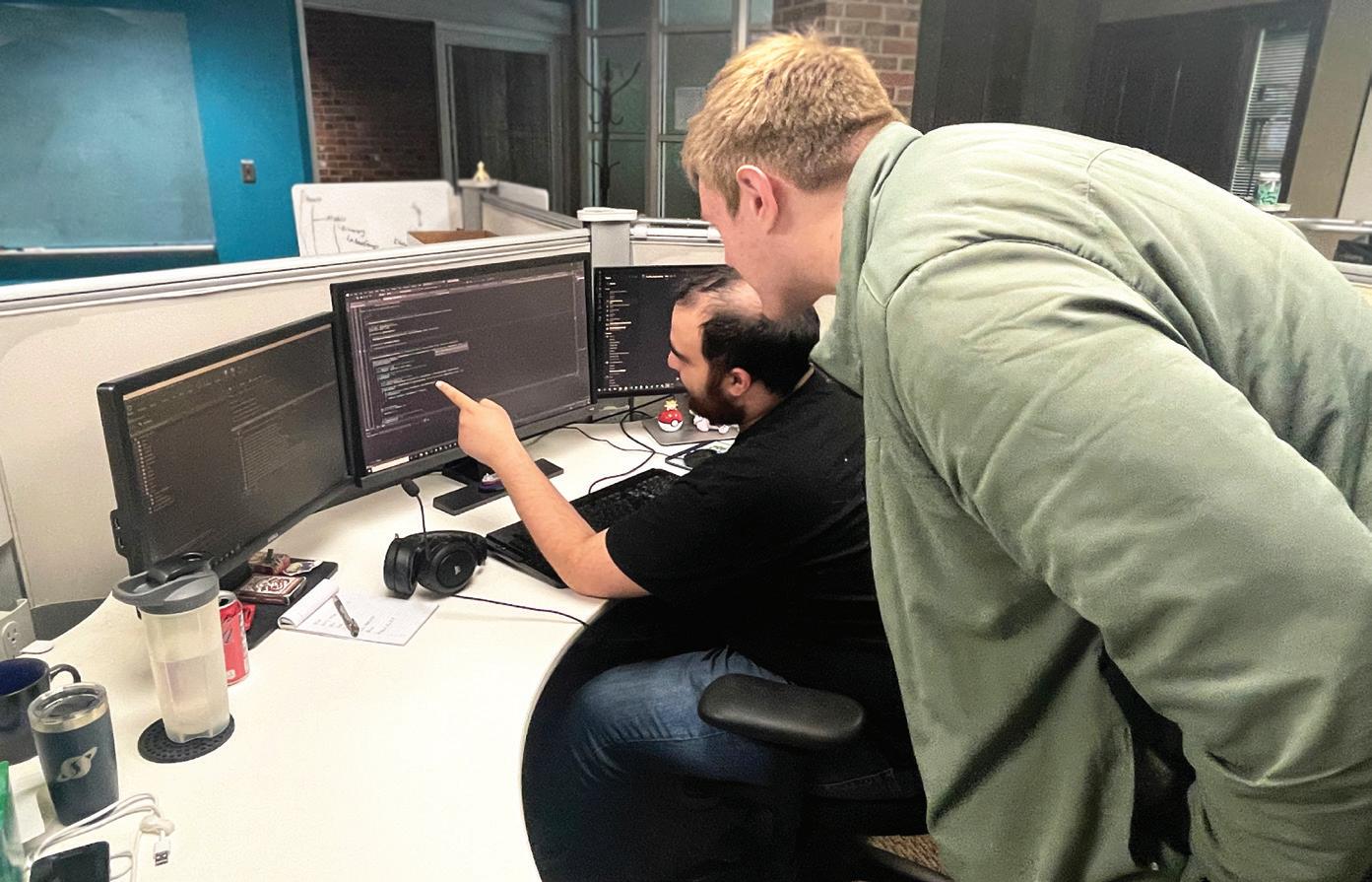
CODE ENFORCEMENT
Stardock is named after a major city in Raymond E. Feist’s “Riftwar Cycle.” As a game developer, the company’s first title was “Galactic Civilizations.”
The settlement involved Wardell supplying “honey from his hives … while Reiche gives Wardell some of his mead.”
Stardock Systems was the holding company for Stardock Software, with early products based on the Microsoft and IBM OS/2 joint-venture operating system. Wardell claimed an industry first in 1995 with the Object Desktop productivity program. Stardock Entertainment made games starting with “Galactic Civilizations,” which was written out of “zealotry” to prove OS/2 “could be a good game platform,” as he explained in a post.
Remaining a true believer, Wardell insists OS/2 was “a great operating system,” but it didn’t last.
As he explained in the post, “Stardock’s history could really be divided into two parts — the OS/2 Stardock and the Windows Stardock.” Reorienting the company to Windows after the 1997 collapse of the OS/2 market took some time, and in addition to the new coding, there was also a process of organizational restructuring.
“Over time, what I’ve done as I got older and a little bit smarter, I stopped naming new ventures ‘Stardock something’ because that made it confusing,” he says. People were increasingly aware of the Windows utilities, video games, or other products. Stardock even produced early and “horrendously insecure” software for credit card purchases. “You would never do it like that now. It was a much more innocent time.”
Wardell increased the emphasis on helping people modify or extend their graphical user interfaces with the Windows desktop. To that end, there are now nine
programs available. Among them, Start11 ($9.99 to $39.99) allows for customization of startup screens. PCWorld reported, “Start11 solves Windows 11’s worst Start menu and taskbar sins.”
WindowBlinds 11 ($29.99 to $39.99) is a program that lets the user apply a variety of customizable design themes on a PC, adding colors and textures for the Start menu, and even window “frames.” One reviewer wrote: “There’s so much choice with some truly cool designs (and many not-so-great ones) from the community, so you can explore to your heart’s content and make Windows as hideous or beautiful as you want.”
Object Desktop ($29.99 to $39.99) soldiers on as a productivity tool with a dozen applications, including DesktopGPT. Introduced in April, this AI app contributes efficiencies to tasks such as writing email subject lines or translating text in multiple languages. “DesktopGPT is the evolution of a tool that we were using internally at Stardock to help us be more effective with our AI interactions,” Stardock Software general manager Brad Sams said in a statement.
“Within our ecosystem, we’ve been working really hard and raised our stature on a global basis,” Kowal says. “Some of the work we’ve done engineering-wise created strong relationships with the biggest names in the tech industry: Microsoft, Intel, ANV, Nvidia — all the large players — (as well as) Sony and others.”
Yet the primary motivation, Kowal says, isn’t about profits or stature; instead, it’s “wanting to do interesting work by solving technological problems.” The result is that millions of people follow the company

COURTESY OF STARDOCK Focus 30 DBUSINESS || July - August 2024
online and hundreds of thousands play the games.
Besides creating a new civilization in “Galactic Civilizations IV” ($49.99) or battling for dominance amid the stars in “Sins of a Solar Empire Ultimate Edition” ($69.99), Stardock’s big catalog of games includes version 6 of “The Political Machine” ($19.99).
The game fields real or imagined presidential candidates against one another in primaries and a general election. The player can compete solo against the computer, or partake in multiplayer campaigning.
After the budgeting, strategizing, speechmaking, and debates are finished, and breaking scandals or natural disasters intervene, demographic data underlies the simulation results. “The Political Machine” comes with charming caricatures of the established candidates and grandiose, election-night orchestral music by composer Sean Beeson.
Early testers of the 2024 version posted observations on the chat site Discord.com as the primary season started. For example, “Divinity” wrote: “Love the new graphics and overall presentation. The characters feel much more like their IRL (in-real-life) counterparts.” To which “Vielle” responded: “Yeah, unless you’re talking about Nikki Haley’s dress or (third-party candidate) Andrew Yang’s face, then I think it’s pretty good.”
The appreciation for the graphics and presentation is an endorsement for art director Laika Laursen, who’s in the second year of a four-year contract.
“For Stardock, it has been more focused on engineering,” Laursen says in a videoconference from her home studio on Denmark’s Helgenaes Peninsula, a resort area with a seacoast, national parklands, and summer houses. “I come with some different eyes. It can help in any production to have somebody come in who doesn’t really have the same view of things and the same background, (who) just sees things a little bit differently.”
Just how different is her vision? A graduate of The Animation Workshop in Viborg, Denmark, Laursen has never been to Michigan — it’s all virtual. In accepting the job with Stardock, she committed her availability to correspond across a six-hour divide and match the Eastern Time Zone workday. She calls the difference her “Goldilocks hours.”
As art director, Laursen wants to go beyond staff supervision. She adds illustrations in two dimensions, but will also “go in and craft parts of the game in 3-D on the computer.” It’s a bit different from the same role at most indie producers, but why not be a triple-threat? “I like to keep sharp on the tools I use,” she relays.

GAME EFFECT
Stardock has made a name for itself by developing strategy games such as “Off World Trading Company” with Mohawk Games and “Star Control Origins.” The company got its start in 1991.

Increasing the quality of game art and design makes sense for Stardock, especially with mighty multicore computers being supplemented by the AI boost that allows gamers to set their own parameters.
“I would describe Stardock, first and foremost, as a software-engineering company. That’s what they do,” says Stephen Mallory, assistant professor of game design at Lawrence Technological University in Southfield. “If you look through the history of their titles, the strongest aspect is the engineering, the stability, and the depth of play around it.”
Within the video game industry, Stardock “is a bit of a unicorn,” Mallory says. The company’s diversification and sound financial underpinnings lead to resistance against the “shocks and pressures” other studios succumb to.
“You know when you see the Stardock label, the fact they’re publishing it, they developed it, that it’s going to be a pretty complete, well-made, compelling video game experience,” he says.
Thinking in terms of the widespread continuous-improvement principles of the 1990s, Mallory sees Stardock weighing its strengths and weaknesses and deciding, “OK, we know we need to elevate this now. We have a strong engineering base; let’s start bringing the art up with it.”
As Stardock pursues industry leadership, Wardell has another point to make — namely, gamers are decent people and the media should stop vilifying them. He isn’t thinking of reviews that are critical of products on merit, such as the 2016 take on “Ashes of the Singularity,” which GameSpot said “feels like little more than a tech demo of Stardock’s new Oxide engine.”
The more objectionable criticism arrives via what he calls “excessively politicized” game journalism. As a 2023 headline in The Federalist put it, “The Gaming Press is a Sorry Tool for Wokescolds.”
A decade ago, a scandal known as Gamergate arose through collusion between a game developer and a reviewer, which opened the door to a toxic atmosphere. The Federalist’s article by Douglas Blair says, “What really matters here is what happened after Gamergate; the massive uptick in politics posing as game journalism.”
Well before the scandal, Wardell had already written his 10-point “Gamers Bill of Rights,” stating basic tenets of customer service such as the right to a refund and the right to sell or transfer ownership of physical copies of games. With the more recent campaign against elitist cultural journalism, he thrusts into a new arena with his moral imperative.
That’s why he spent the past New Year’s Eve chatting with, and affirming, Stardock fans on Discord. It may have been another sedentary moment and more trouble for his waistline, but the session personalized Stardock’s storylines and bolstered its bottom line.
“I like our customers — it’s really what it boils down to,” Wardell says. “I like to make things for our customers. I don’t like it when our customers are made to feel bad about what they enjoy. My games aren’t violent, but ‘Galactic Civilizations’ has space battles. Is that bad?”
COURTESY OF STARDOCK Focus July - August 2024 || DBUSINESS.COM 31

Watershed Moment
From a Lake Erie marsh to the Keweenaw Peninsula, The Nature Conservancy preserves land and undertakes conservation projects across Michigan. Sound business practices help the nonprofit share the land with the general public.
BY RONALD AHRENS
Once, after an early May snowstorm in the Upper Peninsula, Emily Clegg was checking out a riparian planting project in the Ottawa National Forest. She found the way along a two-track road blocked by a fallen tree.
Clegg, who was on the job for The Nature Conservancy, had no chainsaw in her truck, so she hopped over the tree. Continuing on foot, she discovered wolf tracks in the snow, then saw a blur up ahead. Continuing a bit farther, she found two more sets of tracks.
“Then all the hairs on my neck started standing up, and I hightailed it out of there as fast as I could,” Clegg says during a recent call from Marquette. “I wasn’t worried about one wolf. But three wolves? I’m not going to take on three wolves, especially in May when they’re hungry.”
As occupational hazards go, wolf attacks are an order of magnitude more serious than paper cuts or welding sparks. Yet Clegg, who has worked 13 years for TNC, is a perfect example of the passionate kind of employee that’s found throughout the organization; there are about 60 professionals in Michigan and 3,000 worldwide, including 400 scientists. She first worked for TNC Michigan as a seasonal employee during her undergraduate years at Northern Michigan University.
“I came up through land and water management, starting out as a field technician, just out driving roads and mapping where things were,” she says. Two years ago, she became director of land and water management for TNC’s Michigan chapter, which was chartered in 1984. “Our day-to-day job is
NATURE-BOUND
In 2022, The Nature Convervancy Michigan acquired 23,000 acres of biodiverse Keweenaw County wilderness, known as Keweenaw Heartlands.
to make sure the lands and waters that we own are being protected and (are) in good (shape), and/or are being restored to a better quality than maybe when we acquired the property.”
There’s also the responsibility of making sure “people are interacting with nature in a responsible way.” And collaborations with government agencies must be administered. “In our partnerships with state and federal agencies, it’s very much a mutually beneficial relationship,” Clegg says.
TNC Michigan owns 103,000 acres comprising 36 preserves, which are wilderness, and reserves, defined in organizational literature as “sustainably managed forests that provide timber to Michigan’s forest products markets when harvests are beneficial to forest health.”
Marked by friendly white-and-green signs on wooden posts, these lands extend from the Helmut and Candis Stern Preserve at Mount Baldy, near Eagle Harbor in the northwest, to Erie Marsh Preserve on Lake Erie in the southeast. Two-thirds of the total number of parcels — including all the reserves — are in the U.P.
While TNC has its own preservation agenda, sometimes, according to Clegg, conservation goals match, enabling TNC and the government agencies to accomplish more restoration work in partnership rather than working alone. Contracts and agreements come into play so that, beyond the proprietary lands, TNC Michigan and its 32,000 supporters protect even more land through partnerships and easements — which raises the question of complexity.
“It’s not that bad. We’ve been doing it long enough, we know the ins and outs of the contracts and agreements, and what might hold something up,” Clegg says.
Founded in 1950, The Nature Conservancy is a 501(c)(3) nonprofit, tax-exempt charitable organization that’s active in every state and in 79 countries. It has preserved some 125 million acres of land and has undertaken more than 100 marine conservation projects. From the start, as a big idea, it took some years to find its métier as a well-functioning organization.
After the early days of an all-volunteer staff and a somewhat random approach to preservation, it became a story of scientific management and creative financing, all in service to biodiversity and the climate. From its headquarters in Arlington, Va., TNC practices a nonpartisan approach, and leaders preach an optimistic view.
DEVIN LEONARDUZZI / TNC Perspectives 32 DBUSINESS || JuLy - AuguST 2024


“The whole organization is being driven by our 2030 goals across the globe,” says Helen Taylor, director of TNC Michigan, whose office is located just north of downtown Lansing. “Those goals are focused on addressing the two biggest threats to nature and people: climate change and biodiversity loss.”
Taylor had earlier elaborated on the goals in a 2022 newsletter message saying the Michigan chapter’s work would “contribute in a big way” not only with research and practices directed at forest restoration, but also by partnering with businesses in “climate-smart decision-making.” TNC Michigan works closely with the Michigan Agri-Business Association and its members, including Star of the West Milling Co., Michigan Sugar Co., and the Michigan Milk Producers Association. It also has key relationships with businesses in the forest-products industry as well as DTE Energy, ITC Michigan, PVS Chemicals, and Dow Chemical.
Taylor echoes the thoughts of former TNC national President and CEO Mark Tercek, co-author of “Nature’s Fortune: How Business and Society Thrive by Investing in Nature.” Tercek argues that more and more companies are conscientious about their behavior and are showing the willingness to do the right thing.
“They also increasingly understand that investments in nature can produce big financial returns,” Tercek writes. Collaborations with government agencies and businesses can multiply the effect of TNC Michigan’s own preservation efforts and even engage in community development.
“We’ve protected over 480,000 acres across the state,” Taylor says, “but we own less than a quarter of that (acreage) because we don’t aspire to grow in ownership. What we want to do, if these places can be protected and managed, is provide for communities.”
A big win in 2022 was TNC Michigan’s $27.2 million acquisition of 23,000 acres of biodiverse Keweenaw County wilderness known as Keweenaw Heartlands from the Rohatyn Group, a firm that invests in timber and agricultural lands. Another 9,769 acres nearby was acquired through a third-party benefactor for $1.9 million.
The deal was lauded for keeping the land open to the public. Most of TNC Michigan’s preserves aren’t on local tax rolls, but the Keweenaw Heartlands is enrolled in the Commercial Forest Program, and property taxes continue to be paid.
Taylor says mining and forestry have climaxed on the Keweenaw, and the future of the area lies in outdoor recreation. “We took out pretty significant financial loans and jumped in and bought it because, if we hadn’t done that, the risk to the community was so significant for its future economy. There are snowmobile and off-road vehicle trails, and hiking and mountain-biking trails, all of which, if that land had been fragmented and sold, would have risked privatization in such a way that those trails would be cut off — and that’s the basis of their local economy.”
The acquisition was more than just a matter of coming up with the money. TNC Michigan conducted polling and listened to local voices. Consultation with rural economic development and planning experts is ongoing regarding issues such as infrastructure and housing.
GROUND LEVEL
Above: Workers replant trees in Ottawa National Forest in Michigan’s Upper Peninsula. Below: Whitefish are being replenished in the Jordan River, a nearly 25-mile stream that’s the largest tributary of Lake Charlevoix, located in the northwestern part of the state.
“Our intention is we don’t think we should be the future owner and we don’t intend to be the future owner. What I think is the most compelling part of the story is the work we’re doing with the local community and stakeholders, from those user groups as well as local officials, to create a blueprint and a governing structure that we will then transfer to public hands.” Ultimately, Keweenaw Heartlands could be an inspirational model of rural redevelopment. “We have many rural communities in Michigan whose factory has closed or whose primary employer is gone,” Taylor adds. “The greatest assets they have are their natural resources, and that’s the Pure Michigan that we all love.”
Enlisting partners in the preservation of lands allows TNC Michigan to turn more of its attention, as well as a larger part of its $15-million annual operating budget, to scientific efforts in the cause of biodiversity. (One-time capital projects have separate budgets.)
For example, one experiment got underway in November of 2022 when TNC Michigan partnered with Native American groups and the Michigan Department of Natural Resources to incubate 100,000 fertilized whitefish eggs in the Carp River, in

JOHN DEN UYL / RYAN HERMES / TNC Perspectives July - August 2024 || DBUSINESS.COM 33

AQUA
THREATS
Cyanobacteria, which developed in western Lake Erie due to nutrient pollution, kills wildlife and fouls drinking water.
REPEATED OUTBREAKS OF ALGAE BLOOMS in Lake Erie have affected the ecological balance of the smallest — by volume — of the Great Lakes, while also being a drag on shoreside commerce.
A massive 2011 bloom caused $71 million in losses to Ohio businesses and affected Toledo’s drinking water, according to “The Impacts of Lake Erie’s Harmful Blooms on Great Lakes Businesses,” a 2021 report issued by the Great Lakes Business Network (GLBN).
Cyanobacteria that flourish in the western basin of Lake Erie cause blooms of blue-green algae that can kill birds and fish, and sicken humans. Nutrients such as nitrogen and phosphorus from upstream farms contribute a concentrated source of pollution where the River Raisin flows into the lake at Monroe; the Maumee River contributes to blooms in the lake’s western basin.
The blooms affect tourism, fishing, and outdoor recreation. Marinas, motels, and bait shops feel the economic pinch while onshore visitors notice the stench. There are also higher operating costs at water treatment facilities. In Michigan’s Lake Erie watershed, wildlife recreation creates more than 55,000 jobs and adds more than $2.4 billion annually to the regional economy.
A variety of solutions has been identified. Banning manure applications to frozen or saturated farm fields is a key step, and funding for education on best practices is ongoing. In addition, regional collaborations are important in estimating and implementing programs. The GLBN has called on authorities in Ontario, Michigan, and Ohio to implement a coordinated strategy to reduce nutrient flow into Lake Erie by 40 percent by 2025.

Michigan on a restoration project at one of three spawning reefs near Elk Rapids, which sits on the east arm of Grand Traverse Bay.
Deploying the tugboat Wendy Anne from the Charlevoix harbor — along with 450 tons of cobbles transported on a barge whose deck also carried an excavator and front loader — Herbert dumped the rubble with the idea of rebuilding this spawning reef for lake trout, cisco (also known as lake herring), and whitefish.
the Upper Peninsula’s Mackinac County. The population of lake whitefish has been in decline for more than a decade, with some of the blame falling on invasive quagga mussels, which filter nutrients from the lake water and reduce the density of the zooplankton that sustain young whitefish.
“Everyone loves a good comeback story, and this experimental river stocking might just be the ticket to jump-start the lake whitefish comeback in the Great Lakes,” Matt Herbert, senior conservation scientist for TNC Michigan, says in a statement. “Lake whitefish are the most important commercial fishery in the Great Lakes, and are such an important part of the fabric of our state.”
Timber harvesting and lumber mills also impacted whitefish, as debris began to clog rivers, especially those flowing into Lake Michigan. “Back in the day when so much of Michigan was cut down, the river runs of whitefish were wiped out because there was so much activity — sawdust, logs — that blocked the rivers,” Taylor explains. Restoration of spawning grounds also extends to these sites, and the goal is that hatchlings will “bond with the chemistry of that river so they’ll come back to spawn.”
The aquatic habitat restoration extends to reefs in Lake Michigan. Little had been known about these glacial deposits of rock and gravel, and exploration and mapping remain in the early stages. Although less exotic than coral reefs in seas around the globe, they’re critical in providing protection for fish eggs and hatchlings.
Starting in 2015, Randy Claramunt, of the Department of Natural Resources, and Tracy Galarowicz, of Central Michigan University, began working with TNC
REVERSE EFFECT
The reconstruction of the western portion of Lake Erie is ongoing. The plan includes reducing pollution in the lake as well as limiting the spread of fertilizer and manure runoff.
“In general, The Nature Conservancy’s work is proactive,” Herbert says in a documentary video after divers descended to inspect the replenished reef. “We’re usually out ahead of things and trying new things, and this project is exactly that.” After TNC Michigan claimed success at Elk Rapids, a scaled-up approach to reef restoration across the Great Lakes was conceived to combat algae, sediment, and invasive species such as the alewives, gobies, and rusty crayfish that prey upon cisco eggs and larvae.
On the other hand, at the “micro” end of the spectrum in Detroit, TNC worked with members of Sacred Heart Catholic Church, in the Eastern Market district, to retrofit the church’s parking lot to control stormwater runoff. The makeover was finished in June of 2022.
At its start, Sacred Heart’s then pastor, the late Rev. Norman Thomas, said, “It isn’t just about a parking lot, it’s going to be something that enhances this whole area.” The old parking lot was a wasteland of asphalt that sent runoff unabated into the city’s drainage system and, in the case of a deluge, into the Detroit River. The new 1.3-acre lot has a porous surface and engineered “rain gardens” that reduce runoff by about 1.5 million gallons per year. The church’s 18-member garden club helped to select the plants, shrubs, and trees, and now cares for the plant beds.
TNC Michigan’s Green Stormwater Infrastructure initiative is an example of the organization’s uncanny way of engaging people on many levels. Just ask the winners of its 2023 photo contest.
— Ronald Ahrens
Perspectives 34 DBUSINESS || July - August 2024 FAUNA CREATIVE / JASON WHALEN / TNC

Grand-prize winner Chong Q. Wu captured a breathtaking daybreak scene at fogshrouded Lake of the Clouds in Porcupine Mountain State Park in the U.P. “I could look at this all day,” contest judge Jason Whalen said. ere were also winners in four other categories: people and nature, ora and fauna, landscape, and water.
Additionally, there are apps such as iNaturalist, which allows the user to collaborate with other enthusiasts and experts in species identi cation or reporting invasive species. Guided audio tours also are available for seven TNC Michigan preserves via the Travelstorys app. ( ree of these tours are also conducted in Spanish.)
Events, webinars, and volunteering opportunities present other levels of engagement. Perhaps the most intriguing opportunity is geocaching — a kind of treasure hunt over TNC Michigan lands, with the treasure being contained in caches of different sizes and shapes. Each cache includes a logbook to be signed by the adventurers, who can also trade knick-knacks in the cache and enter a report of the ndings online.
Educational partnerships and fellowships add another component. Last September, high school students from Brimley, a tiny town 15 miles from Sault Ste. Marie, participated in a winter-habitat-building program for small animals on the Two-Hearted River Forest Reserve.
e undertaking came about through a TNC Michigan partnership with Lake Superior State University’s Career and Technical Education program and the Michigan United Conservation Clubs’ On the Ground program. Besides the habitats, trail cameras were installed; these will be maintained by TNC sta members.
As multifarious as TNC Michigan’s activities are, none of them goes unnoticed by Terry Barclay, vice chair of TNC Michigan’s 25-member board of trustees. Barclay is also president and CEO of Inforum, a professional-development organization in Detroit that boosts women’s careers. In eight years as a board member, she says she has no pet projects, nor is it easy for her to name a favorite preserve.
“I really am supportive of all of the work that e Nature Conservancy is doing — northwoods work, sheries in the Great Lakes, water issues,” she says in an interview.
e GSI program in Detroit also intrigues her, and the importance of the overall mission grows as the environmental clock ticks against species extinction and biodiversity loss. “We’ve got to create an environment where people understand and care and have a sense of urgency about the work.”
Barclay nds that trustees are well-engaged in their areas of expertise and put their resources into play on “projects that make the most sense to them.” In her own case, she often works with elected o cials and business leaders.
“So many times, the environmental movement is typecast,” Barclay says, citing the advantage of what she calls a “ rmly nonpartisan” organization. “ e Nature Conservancy is always there with a data-based, data-driven set of information that’s available as policymakers dig into some thorny questions. I’ve seen that in meetings I’ve had with elected o cials who are interested in seeing what TNC knows about an issue.”
In the 1990s, from its Virginia headquarters, e Nature Conservancy supersized its fundraising e orts, adding well-known gures like Gen. Norman Schwarzkopf and corporate CEOs to its governing board. General Motors pledged $5 million then, and donated a 4-wheel-drive truck to TNC in each state. Within her own sphere, Barclay counts it as a “privilege” to introduce the topic of philanthropy.
“I don’t think you should be on a board of a nonpro t organization unless you’re going to make giving to this organization a priority,” she says. “Whenever I think there’s an opportunity, whether business or personal philanthropic interests, it’s wonderful to introduce them to the organization. It’s their choice. I think it’s just a matter of raising awareness.”
Shining the light on TNC’s work became a focal point after Barclay lost her parents, who had made an e ort to expose her to the natural world throughout her childhood. She was introduced to the organization when attending a photography exhibit sponsored by GM around the same time she was “starting to re ect on where I wanted to make an impact — an important and lasting impact for multiple generations.” e scale and scope of TNC’s activities impressed her, along with the signi cance of the scienti c work.
“ e citizens of the world are looking for leaders with a broader vision of how to create value,” Barclay says. Instead of “either/or” thinking, she says, the quest is for “both/and” thinking. “We’ve got to learn how to make this work for everyone.”





PRIMARY TREATMENT


The Nature Conservancy uses lavish online posts to promote its Michigan and global initiatives.
THE NATURE CONSERVANCY MICHIGAN is part of a sophisticated internet-based e ort that entails a dynamic, evolving website embedded with exquisitely crafted videos. Beyond the web engagement, the nonprofit conservation organization makes use of compelling social media posts.
For example, a recent Instagram video report summarizes progress at the United Nations Climate Change Conference, a.k.a. COP28, which was held late in 2023 in Dubai.
“For those of us in the Midwest, there was a recognition of the role that natural systems like forests and wetlands play in helping with climate mitigation and adaptation,” says Emily Mills, media and public relations manager of TNC Wisconsin. “We’re also happy to hear that attention is finally being paid to the role that agriculture and food systems play in the fight against climate change.”
The Instagram page o ers an expansive selection of nature photography, but there are also maps, images depicting scientific work such as reef restoration, and even more videos. In one of the latter, TNC Michigan trustee Mary Draves leads an “Advocacy Day” assault on Washington, D.C., to confer with Congressional representatives.
She appears in the video with chair emeritus Jim Nicholson, chairman David Barfield, and fellow trustee Tom Cook. “What struck me in every single o ce is that our message was well-received,” Draves says. “People understood the topics we were talking about and are committed to helping us.”
— Ronald Ahrens
Perspectives JULY - AUGUST 2024 || DBUSINESS.COM 35 SCOTT SURIANO / TNC




Breakfast Series
One-of-a-kind networking opportunities and compelling business content across a wide range of industries and topics await you at the DBusiness Breakfast Series.
DBusiness magazine’s event series are bi-monthly panel discussions and award shows.
2024 topics presented have included: Top Corporate Culture Awards, Commercial Real Estate Awards, 30 in Their Thirties Award Show and Powered by Women.









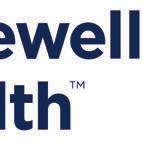


UPCOMING EVENTS For more information and event tickets: August 1st, 2024 Powered by Women Presented by Rozafa Transport SPONSORED BY PRESENTING MAJOR GOLD SILVER

LEAVING A LEGACY
After nearly 25 years at Blue Cross Blue Shield of Michigan, President and CEO Daniel J. Loepp is retiring. He’s leaving behind not only a transformed organization but also a revolutionized health care landscape in Michigan and beyond.
OBY TRENT G. LYKKEN
n Dec. 31, when Daniel J. Loepp retires as president and CEO of Blue Cross Blue Shield of Michigan, he will leave behind a revolutionized organization. BCBSM — a nonprofit mutual insurance company and an independent licensee of the Blue Cross Blue Shield Association — has been modernized and considerably scaled up.
“‘Transformational’ is the one word that best describes Dan Loepp’s legacy over more than 20 years,” said BCBSM Board Chairman Gregory A. Sudderth in a recent statement.
Loepp has spent 24 years with BCBSM, serving in his current role since 2006. In that time, he has made huge, positive impacts by transforming the payment system in Michigan and collaborating with health care providers on value-based care. One initiative that addresses surgical and medical costs through an emphasis on data analysis will soon celebrate its 20th anniversary.
“It’s been a great journey,” says Loepp, the holder of a bachelor’s and a master’s degree from Wayne State University and five honorary doctorates. “A lot has changed.”
Daniel J. Loepp, pictured here in his office overlooking downtown Detroit, will leave behind a transformed organization when he retires as president and CEO of BCBSM at the end of this year.
BCBSM 1 SPONSORED CONTENT BLUE CROSS BLUE SHIELD of MICHIGAN

20-YEAR
TRANSFORMATION
Innovative, data-backed programs and partnerships have made BCBSM a health insurance leader
Through nearly two decades of organizational restructuring while incidentally grappling with the Affordable Care Act and later the COVID-19 pandemic, Daniel J. Loepp has led a health care transformation at Blue Cross Blue Shield of Michigan. The beneficiaries of his victories are the 4.7 million insured in the Great Lakes State as well as hundreds of thousands of employees of Michigan-based organizations in other states.
As president and CEO, Loepp initiated value-based care programs that resulted in $2.2 billion in medical cost savings in the first 10 years.
Along the way, Loepp has overseen growth in BCBSM business, with revenue more than doubling from $15.3 billion in 2005 to $36.3 billion in 2023, while maintaining an annual average operating margin of less than 1% over the last 10 years.
BY TRENT G. LYKKEN
Loepp, a Detroit native, joined BCBSM as vice president of governmental affairs in 2000. Four years later, he became vice president and chief of staff and in 2006 was named president and CEO. Since then, he has increased the appeal and broadened the reach of BCBSM to create a giant among nonprofit mutual insurance organizations, marking particular success in Medicare and Medicaid programs, in addition to the company’s longstanding success in commercial health insurance.
“We’ve become, over the years, very good in the Medicare Advantage space — we’re a top 10 Medicare Advantage plan in the country,” Loepp says.
The transformation that has occurred under his watch has benefited BCBSM members in a myriad of ways. He credits a “great group of talented executives and employees” focused foremost on the
affordability of care and the health and well-being of members. Loepp worked with health care providers to increase efficiency and the quality of care, and he led the development of innovative, practical products for customers. He has been a bold promoter of high-quality, cost-effective generic drugs.
“Dan’s leadership of Blue Cross Blue Shield of Michigan has been extraordinary, and he is a well-respected voice of influence in the industry,” says Bob Riney, president and CEO of Henry Ford Health. “Equally impressive is his leadership in community initiatives to enhance the quality of life and overall value of his beloved city of Detroit. He has been a relentless advocate for job growth, training, economic development and placemaking to enhance Detroit as an ideal place to work, live and play. He’s a real difference-maker.”
2 BCBSM SPONSORED CONTENT
WELLNESS PLANS
One example of Loepp’s pragmatic approach to health care is providing Blue Cross Health & Well-BeingSM programs at no additional cost to members.
“I think the industry is moving this way — but we were a bit ahead of the curve — realizing that health care is whole-person health,” Loepp says. “When I started, for example, mental health care was avoided. The marketplace, based on what people want, has really changed, and the industry is embracing it now — whole health.”

Dan’s leadership of Blue Cross Blue Shield of Michigan has been extraordinary, and he is a wellrespected voice of influence in the industry.”
—Bob Riney, president and CEO of Henry Ford Health
Using resources powered by WebMD, the Blue Cross Health & Well-Being programs supply a broad range of information and tools that are available 24 hours a day and just a click away. Members can access their accounts at bcbsm.com or through the easily downloaded BCBSM mobile app. Once connected, they may complete a health assessment with the score based on an analysis of modifiable risks. The risk reports from this input lead to recommendations for improvement.
Because BCBSM recognizes psychological well-being as a key component of allaround good health, the company provides weekly virtual webinars that address wellbeing through topics such as mindfulness, resilience, social connectedness, emotional health, financial wellness, physical health, gratitude and meditation.
Another program offered at no additional cost beyond premiums addresses the needs of members who want to quit smoking. For them, a tobacco-coaching plan provides personalized support as they progress through a 12-week program.
Yet another program among the various tools is Blue365®, which furnishes discounts on gym memberships and weightloss programs.
Members can also call a toll-free number to reach the BCBSM Engagement Center and get help finding doctors and hospitals. There’s even a 24-hour nurse line for conversations about symptom management and other health information.
VALUE PARTNERSHIPS
Since 2005, Value Partnerships have reshaped the delivery of health care and redefined how it’s funded. Value Partnerships are a collection of programs among BCBSM, physicians and hospitals across Michigan that make health care work better for everyone. The collection includes the Physician Group Incentive Program, Collaborative Quality Initiatives and the Patient-Centered Medical Home program, among others. The collaborative model enables data collection and fosters the sharing of best practices so health professionals can improve patient outcomes.
Major value-based care programs launched by BCBSM during Loepp’s tenure have helped to make Michigan a leader in leveraging payment reforms that move away from the fee-for-service model that paid providers for every service regardless of its effectiveness. The programs encompass dozens of initiatives that encourage safety and quality. Coordination of care is another priority.
“If you perform better,” Loepp says, “you’re going to get paid better because the outcomes for patients are better.”
These moves have led to more than $2.2 billion saved over the last decade, thanks to several factors, such as avoiding the repetition of tests, reducing complications and errors in treatment, decreasing emergency-room visits, and preventing some hospital stays.
BUILDING AN INCLUSIVE CULTURE
Gary Torgow, chairman, Huntington National Bank; Daniel J. Loepp, president and CEO, Blue Cross Blue Shield of Michigan; Wright Lassiter, former president and CEO, Henry Ford Health; Rev. Dr. Wendell Anthony, president, Detroit Branch NAACP; Chris Ilitch, president and CEO, Ilitch Holdings; Gerry Anderson, executive chairman, DTE Energy; Mike Duggan, mayor of Detroit; and Bill Ford, executive chairman, Ford Motor Co.
During his time as president and CEO of Blue Cross Blue Shield of Michigan, Daniel J. Loepp has worked doggedly to build an inclusive company culture. BCBSM has won 160 inclusion and diversity awards over the past two decades as more women and people of color have joined the organization’s workforce and taken on management and executive roles.
BCBSM holds more than 100 employeefocused learning sessions throughout the year to increase awareness and understanding of different cultures, communities, generations, work styles and perspectives. The organization also formed a Health Disparities Action Team in 2016 and the Office of Health and Health Care Disparities four years later. It’s all part of a strategy to achieve health equity.
“I am proud of the progress we’ve made over the years,” Loepp says, “and we strive to make a bigger impact as we continue to build our cultural competency.”
—Trent G. Lykken
Daniel J. Loepp joined eight other CEOs of Detroit’s largest corporations to take a stand against racism at a news conference held on June 3, 2020, in the wake of the murder of George Floyd. Pictured (from left to right): Jay Farner, former CEO, Quicken Loans; Mary Barra, chairman and CEO, General Motors; Mark Stewart, chief operating officer, Stellantis;
BCBSM 3 SPONSORED CONTENT BLUE CROSS BLUE SHIELD of MICHIGAN
“It [Value Partnerships] originally faced some pushback,” Loepp says. “But it played through in the first year or two and became accepted and, really, part of all of our contracts with providers.”
Today’s numbers are impressive. More than 100 Michigan hospitals participate in BCBSM Value Partnerships. Statewide, about 73% of BCBSM primary care providers and 52% of specialists participate — and they’re located in 80 of Michigan’s 83 counties.
Perhaps the most venerable of the Value Partnerships is the Physician Group Incentive Program, which launched in 2005. It encompasses 40 physician organizations and 20,000 practitioners across Michigan. They participate in data collection, the sharing of best practices, and collaboration on initiatives that improve the health care system. PGIP partners are evaluated by BCBSM on their performance in meeting quality metrics and are rewarded for the transformation of health care delivery. It’s all part of the effort to improve the overall value of care delivered while reducing total cost.
BLUEPRINT FOR AFFORDABILITY
Equity stakes for health care providers are part of the overall strategy for implementing BCBSM’s programs and initiatives. Loepp likes to use the phrase “skin in the game,” which intimates a kind of mutual investment among the insurer, physicians and hospitals. The Blueprint for Affordability program is an example of such collaboration.
After the establishment of cost targets that eliminate wastefulness, such as repeated and unnecessary testing, health care providers who succeed in managing the cost of care then share in the savings generated through the program. Contracts with providers follow next-generation payment models that apply full or shared risk on costs for managing a population, or there are provisions for “episode-based” risk for specific cases or conditions.
COLLABORATIVE QUALITY INITIATIVES
In a national first, Collaborative Quality Initiatives funded by BCBSM have turned patient data into gold. Or to put it another way, data-sharing leads to the implementation of best practices and improves patient care throughout the state.
As physicians collaborate in the program, a separate coordinating center serves as a
data warehouse. There, audits and analyses are carried out; the findings are compiled for comparative performance reports.
CQIs have become recognized as an innovative approach to improving health care quality and value. The CQI program has been profiled in presentations in over 30 countries on five continents. And CQIs have led to BCBSM’s winning numerous laurels, including four Best of Blue Awards for collaborative efforts in excellence and innovation.
In 2014, Clinical Innovation + Technology magazine gave BCBSM its Accelerator Award. And the 2015 Dorland Health Platinum Award for health information technology and quality reporting systems joined the crowded trophy case.
“That’s really been a high point as well,” Loepp says. “These kinds of projects have made a difference to make costs less than they would be — and, more importantly, outcomes much better for the patient.”
MICHIGAN OPIOID PARTNERSHIP
The stubborn and pernicious opioid crisis has affected Michiganders, and Loepp has led the fight against it by promoting a number of strategies. One is fraud detection and abuse intervention, which identifies at-risk members, tries to stop “doctor shopping,” and examines data to find those prescribing or using excessive amounts of opioids.
Medication-assisted treatment and interventions lead the therapeutic initiatives, and some 75 hospitals have implemented MAT in their emergency rooms.
In 2017, BCBSM came together with the
state of Michigan and key philanthropic funders to establish the Michigan Opioid Partnership to increase access to treatment for individuals with opioid use disorder. The $8 million program seeks to decrease deaths through prevention, harm reduction and promotion of sustained recovery.
Loepp calls the cumulative efforts “table stakes” with hospitals, doctors and the public: “I’ve always believed in the rising of all boats.” That means that even if competitors harvest benefits from BCBSM’s openhanded way of operating, it’s all for the good of the patient.
“It’s just part of what we view as our mission as a company,” Loepp says. “Our mission is not to make money. You have to have a margin to be able to implement your mission. But maximizing margin is not in our game plan.”
LEGACY AND RETIREMENT PLANS
After nearly 25 years with BCBSM, and about 20 years before that working in various governmental positions in Lansing and Washington, D.C., Loepp says he’s “very comfortable” with his achievements. He will continue to serve as chairman of the Mackinac Island State Park Commission and may also sit on the board of a nonprofit or two.
Otherwise, he is soon turning 67 years old and has four grandchildren.
“I’m not going away,” he says, “but I don’t expect to be a full-time employee of anybody except my family. I was born and raised in the city of Detroit. I have no plans of going anywhere — I love it here.”

4 BCBSM SPONSORED CONTENT
Daniel J. Loepp has been a leading proponent of value-based care: “If you perform better, you’re going to get paid better because the outcomes for patients are better.”
THE POWER OF A REMODEL
BCBSM’s transition to a nonprofit mutual insurance company opened the door for diversification, joint ventures, innovative products and improved cost management
BY DAN CALABRESE AND MICHELLE COHL
Blue Cross Blue Shield of Michigan’s transition a decade ago to a nonprofit mutual insurance company continues to have major ramifications not only for policyholders and Michigan employers but also for everyone in Michigan who has an interest in access to high-quality health care.
The transition made it possible for BCBSM and its subsidiaries — no longer limited to traditional PPO and HMO plans — to serve more members though various insurance markets.
“It enabled the company to diversify our business and utilize funds to help keep our core health insurance costs low,” says Daniel J. Loepp, president and CEO of BCBSM. “We had to radically transform the way we do business to ensure we continued to support all of Michigan, our health plan membership and the community.”
Loepp believes one of the key elements of this transition was BCBSM’s effort to embed itself in the communities it serves, which is arguably the most effective way to find and address gaps in the treatment of chronic disease, access to health care in rural areas and overall health equity.
DIVERSIFYING AND GROWING
Becoming a nonprofit mutual insurance company also opened up the opportunity for BCBSM to engage in joint ventures with other Blue plans around the country. Critical collaborations have included the following:
• a partnership with Pennsylvania-based Independence Blue Cross and AmeriHealth Caritas, a managed Medicaid company serving millions of beneficiaries nationwide;
• the acquisition of NASCO, a provider of innovative health care technology for other Blue Cross Blue Shield plans;
• the formation of Evio Pharmacy Solutions, a company that accelerates efforts to lower the skyrocketing cost of prescription and specialty drugs, with four other Blue plans; and
• a new affiliation with Blue Cross and Blue Shield of Vermont, making it the first Blue-licensed plan outside of Michigan to join the BCBSM enterprise.
BCBSM, in turn, has been able to offer customers more products and services that fit their particular needs. Loepp offers several examples, including long-term care insurance through LifeSecure; workers’ compensation and specialty insurance through the
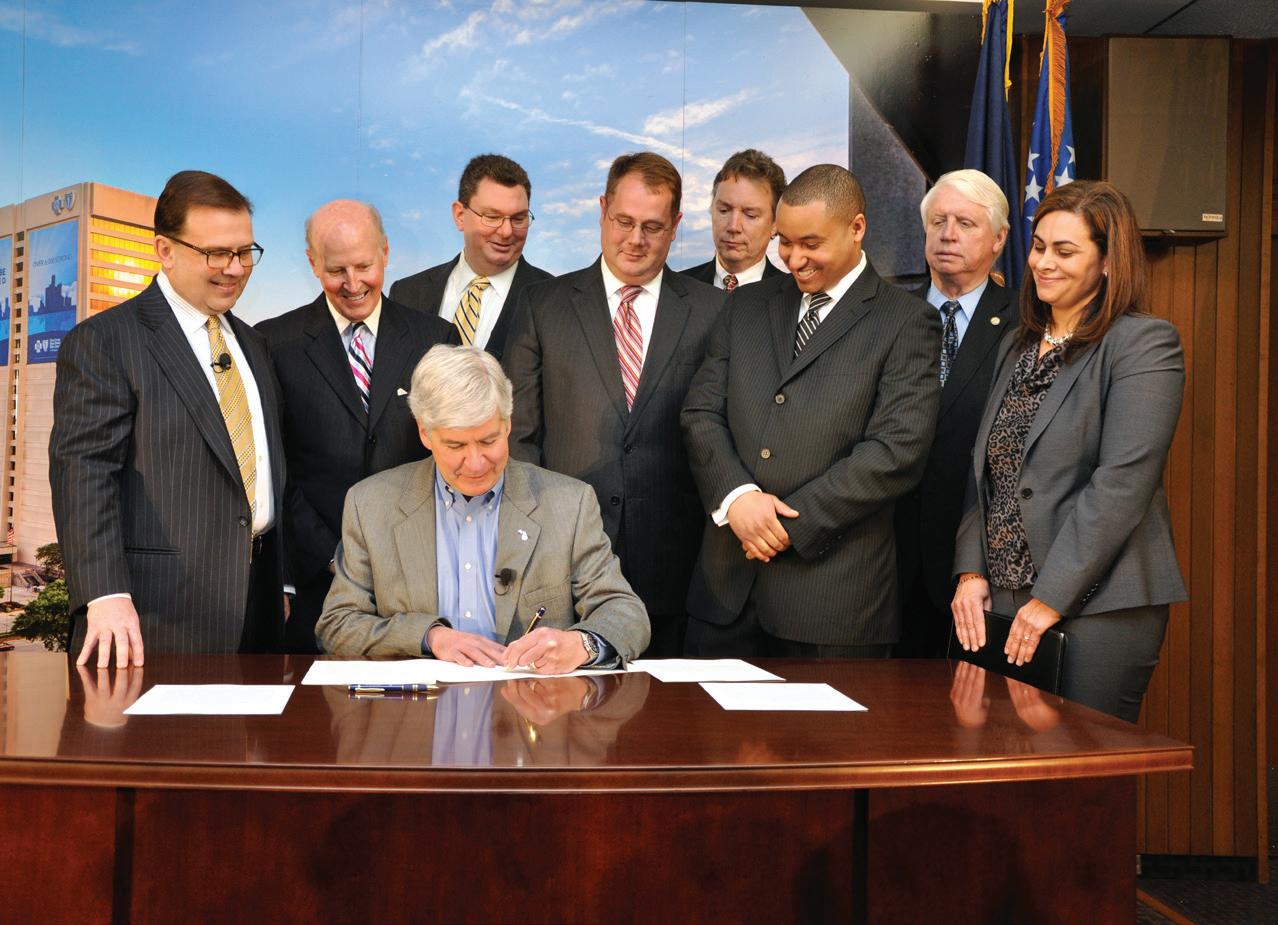
company’s AF Group subsidiary; and Medicare Advantage joint venture programs through Emergient, another BCBSM subsidiary, which has grown across four states and counting.
“Diversifying our lines of business has helped us reach more people — our members — to help them lead healthier, safer lives,” Loepp says.
Diversification helps keep BCBSM financially stable, which becomes critical if the organization has to make a major financial commitment — like the $2.8 billion it spent on COVID-19-related initiatives such as cost sharing, vaccine administration, treatment and testing. Although this response to COVID-19 represented a significant cost, BCBSM’s overall financial stability makes it possible for the organization to take such actions when necessary, meet the needs of its members and continue to operate in a strong manner.
Since BCBSM began diversifying, its family of companies has more than quadrupled from four to 18 under the leadership of Loepp, whose “listen first” approach has proved beneficial.
“Taking an active role in business-focused organizations such as the Detroit Regional Chamber, the Detroit Economic Club and Downtown Detroit Partnership offered me the opportunity to hear business and community leaders describe their own barriers to health care,” Loepp says. “It helped me better understand our customers’ needs and develop innovative products for the marketplace. It also helped us as a trusted health insurance brand translate that value into the areas we serve.”
Former Michigan Gov. Rick Snyder signed into law Public Acts 4 and 5 on March 17, 2013, establishing Blue Cross Blue Shield of Michigan as a nonprofit mutual and requiring the health insurer to contribute $1.2 billion over the course of 18 years to the Michigan Health Endowment Fund beginning in 2014.
BCBSM 5 SPONSORED CONTENT BLUE CROSS BLUE SHIELD of MICHIGAN PHOTO COURTESY OF BCBSM
Diversifying our lines of business has helped us reachmorepeople—ourmembers—tohelpthem lead healthier, safer lives.”
—Daniel J. Loepp

NAVIGATING COMPETITION, CONSOLIDATION, AND INNOVATION
The health care ecosystem is changing as plans and systems consolidate. The reality of this trend, and the competitive pressures it presents, means BCBSM has to find more ways to keep costs low while maintaining operational excellence.
The use of data and analytics, as well as the responsible deployment of artificial intelligence to support members and provider partners when applicable, has been critical. So, too, has been the pursuit of more standards and regulations to ensure that everyone in the industry is following proper protocols and using technology safely and ethically.
But even as BCBSM commits to these important steps forward in operations and best practices, the competitive landscape remains challenging.
“We are seeing continued consolidation of other health insurance plans and health care systems,” Loepp says. “We also recognize that, in addition to the national plans, our largest local competitors are integrated delivery networks, which are health plans owned by provider systems. Competition is always on our radar, and competition is healthy as it offers more variety and spurs innovation.”
No matter where competition leads the industry, BCBSM will always put patients first, Loepp says.
“As health system consolidation continues, the health care industry needs to be considerate of how this impacts their patient populations,” Loepp says. “People want their health care delivered locally, in close proximity to their providers.”
LOOKING TO THE FUTURE
Shifting to a nonprofit mutual structure gave BCBSM more ways than ever to promote healthier Michigan communities, and the new organizational model provided flexibility in terms of services offered and cost control. That ability to adapt and thrive will prove crucial as the health care market evolves and companies like BCBSM that are responsible for helping to provide access to care respond in kind, becoming more nimble, more responsive and more effective wherever possible. Thanks to Loepp’s leadership, BCBSM is ready for whatever comes next.
“We’re proud to work from a position of strength as Michigan’s health insurance market leader that is scaled to the size of a national plan,” Loepp says. “However, we know we cannot take our foot off the gas pedal. Innovation is imperative to stay ahead of industry trends and ensure those we serve receive the best products and experiences from our family of companies.”
When Loepp retires from BCBSM, he will be leaving behind a transformed organization, a legacy of growth and outstanding leadership, and a lasting influence on other Michigan leaders.
“Dan has been a longtime friend and counsel to me since I started my career in public service as an intern in the Michigan Legislature [in 1993],” says Michigan Gov. Gretchen Whitmer. “He saw my interest in policy and encouraged me to run for office [in 2000]. Dan has taught me a lot over the years — navigating a split Legislature, building consensus, and the importance of laughter along the way. As a business leader, he has been a strong advocate for more quality, affordable health care and moved our state forward. I’m grateful for his counsel and friendship, and I wish him and his family the best of luck on their next chapter.”
6 BCBSM SPONSORED CONTENT
Blue Cross Blue Shield of Michigan celebrated the result of 3,400 suburban employees’ relocation to the health insurer’s downtown Detroit campus on June 6, 2012. Pictured (from left to right): George Jackson, former president and CEO, Detroit Economic Growth Corp.; Robert Ficano, former Wayne County executive; Dave Bing, former Detroit mayor; Daniel J. Loepp, president and CEO, Blue Cross Blue Shield of Michigan; and Tricia Keith, then BCBSM vice president, corporate secretary and services, and now president and CEO-elect of BCBSM.

PAVING THE WAY FOR A STRONGER MICHIGAN
Economic support and positive health outcomes are directly tied. Here’s how BCBSM has been working on both.
BY DAN CALABRESE AND MICHELLE COHL
An economically strong Michigan will almost certainly be a healthier Michigan. Blue Cross Blue Shield of Michigan understands that from decades of supporting both the health and economies of Michigan communities.
Under the leadership of President and CEO Daniel J. Loepp, BCBSM has been consistent in its commitment to paving the way for a stronger Michigan, finding ways to help businesses flourish, supporting signature events and making critical investments.
Since Loepp assumed his current position in 2006, he has witnessed major events such as the implementation of the Affordable Care Act and the Detroit bankruptcy. As these events introduced uncertainty, he believed it was essential for BCBSM to spur business in Michigan’s core cities and urban areas, particularly where the organization has offices — i.e., Detroit, Lansing, Grand Rapids, Marquette and Traverse City.
One of the most impactful moves in this regard was BCBSM’s decision to redevelop the old Lansing Board of Water & Light plant into the national headquarters for BCBSM’s subsidiary AF Group. Employees first moved into the renovated space in 2011.
BCBSM also moved in 2022 to renew its 18-year commitment to downtown Grand Rapids, signing a seven-year extension on its lease in the old Steketee’s department store building and keeping 250 employees working each day in the downtown area.
And through the Marquette office in 2018, the Blue Cross Blue Shield of Michigan Foundation participated in providing more than $300,000 in grants to five Upper Peninsula health organizations: Upper Great Lakes Family Health, Munising Memorial Hospital, Upper Peninsula Health Care Solutions, Great Lakes Recovery Centers and Bay Cliff Health Camp.
“Ensuring our presence in those cities was authentic,” Loepp says. “We invested in real estate, signature events and community gatherings, from America’s Thanksgiving Parade in Detroit to the National Cherry Festival in Traverse City, showing that our support of the community can truly come from our corporate partnerships. One of my proudest accomplishments is bringing our businesses into the heart of cities to support this with our presence.”
BETTER HEALTH, LOWER COSTS
In a positive feedback loop, healthy communities lead to lower costs, which lead to healthy communities, and so on.
“When Michiganders are healthy, health care costs are lower and better health outcomes are achieved,” Loepp says. “We’ve found that investing in programs to improve health in varieties of ways with varied population groups — and partnering with the appropriate organizations to help facilitate these initiatives — helps us improve the health of residents.”
Take the Building Healthy Communities program to improve children’s health directly in schools. “[It] has led to reduced childhood obesity, the addition of nutritious food options in cafeterias, improved academic performance, and the fostering of an environment where students in grades K-12 and their families can lead healthier lifestyles,” Loepp says. The program, started by BCBSM,
BCBSM 7 SPONSORED CONTENT BLUE CROSS BLUE SHIELD of MICHIGAN PHOTO COURTESY OF BCBSM
President and CEO Daniel J. Loepp unveiled Blue Cross Blue Shield of Michigan’s America’s Thanksgiving Parade float in 2020, “From Virtual to Reality — Here for It All,” at The Parade Co.’s headquarters. The float included familiar Detroit neighborhood streets in dedication of BCBSM’s support of the East Warren/Cadieux neighborhood through the city of Detroit’s Strategic Neighborhood Fund.

Our support goes beyond corporate contributions. We aim to raiseawarenessoforganizations through public activations and events,opportunitiestopromote them through earned media and our integrated communications, and volunteer efforts.”
—Daniel J. Loepp
has now impacted over 500,000 Michigan students and 1,200 schools.
BCBSM also has a big impact on the state’s health and economic vitality through the Michigan Health Endowment Fund, which was established in 2013 as part of the company’s transition to a nonprofit mutual health insurer. BCBSM has already made $910 million in payments toward a total commitment of $1.56 billion that will be complete in 2031. The Endowment Fund, with a board appointed by Michigan’s governor, has provided $295 million in funding to organizations across the state and has backed partnerships with research institutions studying systemic health issues affecting some of the state’s most vulnerable populations.
“Our work with the Michigan Health Endowment Fund is a shining example of how the private sector and government can

work together for the betterment of people and their health,” Loepp says.
COMMUNITY PRESENCE
BCBSM has made an especially strong commitment to Detroit’s Strategic Neighborhood Fund, serving as the corporate partner for the East Warren/Cadieux neighborhood, where Loepp grew up. In that role, the organization has worked closely with Detroit Mayor Mike Duggan as well as the neighborhood’s residents to help those residents overcome health-related barriers.
“Outside of our $5 million investment, we brought vaccination clinics to the neighborhood and supported the opening of several new businesses, the groundbreaking of affordable housing developments and the opening of a senior primary care center for older adults,” Loepp says. “To be able to contribute to this community, the area in which I spent my childhood, is full circle for me.”
Mayor Duggan says the impact of Loepp’s personal involvement and commitment has been profound.
“For all of the ways he has supported Detroit over the years, I know one that is most personal to him is the $5 million Strategic Neighborhood Fund investment he made through Blue Cross Blue Shield in his old neighborhood near Warren and Cadieux,” Duggan says. “Because of that
investment, we are seeing new housing, new businesses, improved parks and a beautiful new streetscape along the East Warren corridor. Now another generation of young Detroiters will have those same childhood memories of walking or biking to the vibrant commercial district near their home, thanks to Dan’s generosity.”
The high-profile presence of BCBSM in so many Michigan communities, as well as its close involvement with so many community events and institutions, puts it in a strong position to bolster communities economically, socially and culturally — and, of course, by promoting the health of their residents.
“Our support goes beyond corporate contributions,” Loepp says. “We aim to raise awareness of organizations through public activations and events, opportunities to promote them through earned media and our integrated communications, and volunteer efforts.”
Loepp practices what he preaches outside of his work at BCBSM as well. His extensive involvement in community and public health causes reflects his embodiment of servant leadership. Through his philanthropic efforts with the Loepp Family Foundation and his leadership roles in various organizations, he demonstrates a commitment to serving others and making a positive impact on society. Loepp has received several honors during his tenure, including being recognized with the Outstanding Leadership Award from Yeshiva Beth Yehudah in 2008. Loepp and his wife, Amy, have been involved in the American Diabetes Association, Alzheimer’s Association, Capuchin Soup Kitchen, Children Trust Michigan, De La Salle Collegiate, Eton Academy, Kirk Gibson Foundation for Parkinson’s, Urban League of Detroit and Southeastern Michigan, NAACP, and National Kidney Foundation. Loepp also serves on the boards of many business, civic and community-based organizations.
Above: BCBSM President and CEO Daniel J. Loepp and his wife, Amy Tattrie Loepp (pictured here with Suzanne Greenberg, executive director of Children Trust Michigan, on the right), served as event co-chairs at CTM’s Pam Posthumus Signature Auction. Right: The Loepps pose for a photo at the 2022 Ford Fireworks event in downtown Detroit.
8 BCBSM SPONSORED CONTENT PHOTOS COURTESY OF BCBSM

Powered by Women







































































This year we’ve asked the 2024 Powered by Women honorees to wear an item of jewelry that was given to them or borrowed from an influential woman in their life. Inside, they reflect on the challenges of leadership, growing their respective organizations, and the lessons learned from their mentors. Please join the Powered by Women honorees at the DBusiness Breakfast Series on Aug. 1, from 8:30 a.m. to 10:30 a.m., at the Gem Theatre in downtown Detroit. For tickets, email Jaime Presnail at jpresnail@hour-media.com.
Profiles by Dale Buss, Tim Keenan, and Tom Murray
Photography by Matthew LaVere with Rebecca Simonov and Bryan Esler
Concept and digital compositing by Stephanie Daniel
Hair and Makeup by The Beauty Gals
Cover Story JULY - AUGUST 2024 || DBUSINESS.COM 45
Rose B. Bellanca President, CEO
Washtenaw Community College, Ann Arbor
Students: 20,000+
Budget: $100M
Rose B. Bellanca is running a $100-million community college in Ann Arbor with a sta of more than 1,500 people, more than 20,000 students, and an open pipeline for transfers to the prestigious University of Michigan.
And she says she remembers clearly what inspired her to get into the education business in the first place: her kindergarten teacher’s bling.
“She had a diamond ring and high heels, and I was mesmerized by her,” recalls Bellanca, president and CEO of Washtenaw Community College for 13 years and a senior educational administrator for nearly 40 years. “I started playing ‘school,’ and before you know it, it was a career.”
These days, Bellanca’s career puts her in the front lines of the increasingly important arena of community-college education in Michigan. She reports that more businesses than ever are turning to community colleges for qualified employees as tightness in the labor market continues, and as four-year universities are increasingly challenged by high attendance costs and other factors.
Although it’s not the largest vocational-technical school in the state, Washtenaw Community College was ranked No. 1 in Michigan in two recent independent rankings — by niche.com and intelligent.com — and it was tabbed by BestColleges as o ering the state’s best accelerated online program.
To oversee that kind of performance, Bellanca makes sure she puts two important constituencies first: employers and students. “We’re very aligned with the community; we’re very responsive to workforce training and development needs,” she says. “Everything we do takes an outside-in approach. We listen to CEOs of companies as well as advisory committees (and ask), ‘What do you need?’ ”
Referring to students, Bellanca says, “Our focus on them has never changed. They’re important to me.” To be clear, she notes, “Students have changed. They come from all walks of life. Their average age nowadays is 26 to 27 years old.”
Include the school’s faculty, system administrators, education regulators, and the politicians who hold the purse strings as other important stakeholders in Bellanca’s world.
“A community college is the economic engine of the community,” she says. “My passion and goals and what drives me are seeing everything improve — not because of me, but I need to be an integral part of that.”
Bellanca’s post-kindergarten trek up the ladder in education began after the East Detroit native graduated from nearby Regina High School, and it involved another influential figure from her own education. Based on her disappointing score on the SAT test, a Regina administrator told Bellanca’s parents that their daughter wasn’t college material.
“Mytreasuredpieceofjewelry,whichIwearalmostdailyismygrandmother’slonggold chainnecklacewithacrossandcharm.Mygrandmother,Benedetta,raisedherthreechildren asasingleparentinaone-roomstonehutinItaly.Shewasastrong,determined,loving woman,who depite her hardships,always had a sense of gratefulness and humor.I was namedafterherandprofessionallyhavealwaysusedmymiddleinitialof“B”tohonorher andtoremembermyfamily’shumblebeginnings.”
“Her advice was that I should go to business school and get married,” Bellanca remembers.
After enrolling in a business-skills school, however, Bellanca heard Macomb Community College would “take anyone.” That was her launching point: Bellanca finished a nine-month executive secretarial program while starting to attend Macomb Community College, then transferred to Wayne State University and went on to teach family life, culinary arts, and industrial arts at three di erent high schools.
From there, she was named the first female vocational director of Macomb Community College. “People at that time didn’t correlate that job with being a female,” Bellanca says, but “being in that arena as a woman was interesting. I’d get people who would imply that I could ‘understand this,’ and some men had a problem including me in meetings.”
In 1985, one of Macomb County’s premier school systems, Chippewa Valley in Clinton Township, brought Bellanca on as executive director of personnel and labor relations, as well as head of vocational and technical education. The experience deepened her expertise in the kind of career instruction that helps make metro Detroit an economic powerhouse.
Bellanca’s acumen earned her positions over the next 13 years as provost and chief academic o cer at Macomb Community College, president and CEO of St. Clair County Community College in Port Huron, and finally as provost and president of Northwood College’s campus in West Palm Beach, Fla.
As at other times in her past, hinge points came back into play for Bellanca when she accepted her post at Washtenaw Community College in 2011. Way back at Chippewa Valley, Bellanca had taken a deeper dive into a new kind of leadership exercise.
“Something new came across education then: strategic planning,” she says. “I fell in love with it. The (Chippewa Valley) superintendent asked me to create a strategic plan for the entire district, and I had to work with teams of people. We did a good job, so then I went around the country demonstrating how to do that.”
Expanding on that approach, Bellanca has continued to align the school with how education, technology, business, and people have changed. For example, Washtenaw Community College now focuses on online education, o ering both virtual and “mixed-mode” instruction.
“You’d be surprised how many classes actually can be taught virtually,” she says. “Science — I never thought that was going to happen. Even art and dance.”
Washtenaw has become the No. 1 transfer institution to the University of Michigan, and
nursing is the leading specialty in that pipeline, as WCC actually shares classes with U-M. “We need to make sure the quality of our curriculum aligns with the quality of that institution,” Bellanca says. “That’s what our faculty strives to do, and they’re always working to answer, ‘What does this student need to do to be successful? How does the curriculum and teaching need to change?’
”
Her school also is o ering more transportation, engineering, and cybersecurity courses. “We (tend to) think you have to have a white coat to be brilliant, but bluecoated people are darn smart, too.”
— Dale Buss

Cover Story 46 DBUSINESS || JULY - AUGUST 2024
Tina Freese Decker President, CEO
Corewell Health, Grand Rapids
Employees: 65,000
Revenue: $15.2B
It’s clear in Tina Freese Decker’s mind that her rise to become one of the most important guardians of health care in Michigan was fueled by the fact that her grandmother, Suzy Denny, gave up being a chain smoker cold turkey.
Being able to abstain from a pack of cigarettes she left on a table to stare at her every day was an act of courage — and a demonstration that Decker herself could do hard things.
“(My grandmother) was my best friend growing up; I would talk with her every day,” recalls Decker, president and CEO of Corewell Health, the Michigan medical giant that resulted when Spectrum Health in Grand Rapids and Beaumont Health in Southfield merged in 2022.
“She had smoked since she was 11 or 12, but when the doctor told her she needed to stop, she did it for the rest of her life — and I had six more years with my best friend.”
Decker, of course, has been dealing with her share of challenges as she continues to mesh the integration of two of the state’s largest and most crucial medical institutions, each with their own distinct brands, geographic domains, specialty concentrations, and cultures of care and work. She also led the expansion of Priority Health, a Spectrum-owned health-payment plan, into southeast Michigan.
Corewell has scored some early wins under Decker, including realizing cost savings of some $200 million a year largely from an enterprise-wide standardization of the merged system’s supply chain, revenue cycle, and marketing.
Decker says Corewell has “saved more than 3,000 lives” in its first two years by improving “system elements, better detection rates for sepsis, leadership clarity, aligning our care-pathway practices,” and more.
Decker also has led Corewell out of a painful initial period in which state lockdowns by Gov. Gretchen Whitmer, along with stifling COVID-19 protocols in 2020 and 2021, continued to fray the expectations of patients, and impacted the medical field’s culture, camaraderie, and sta work schedules.
“Ultimately, in health care, it’s helping people live their best lives possible,” Decker says. “Every conversation is about how to help the patient and health-plan member get the best outcome possible. We may approach these things in di erent ways, and that’s what we worked through with the merger.
“Apart from that, this is why we’re in health care. We have faith and a purpose that
NodoubtTinaFreeseDecker’sgrandmotherwouldhaveappreciatedhow hergranddaughterhandlesthehardthings.Deckerstillwearsaringshe gaveher;it’sanoldtietacksprinkledwithtinydiamondsthatwasconvertedintoaring.“Itgivesmecourage,”Deckersays,“andinspiration.”
is so foundational to us, and we build from that. Everything goes back to our mission and vision, and how we serve the people at the center of it.”

The native Iowan says she always had a passion for health care, adding a graduate degree in health finance and industrial engineering at the University of Iowa to her undergrad degree in finance from Iowa State University. She joined Spectrum, in Grand Rapids, as an administrative fellow in 2002, and by the next year she was director of planning and strategic development.
the smartest person in the room.

“It’s OK if you don’t have all the answers,” she continues. “Take progress over perfection. People are fearful of the first step when they don’t know every step of the way, but hopefully you only make small mistakes. You learn and get back up.”


“I wanted to be in health care, and I wanted to impact a broad population — which is why I chose the administrative track, to figure out how you make an impact,” she says. “I was also curious to learn more about the human factors. I did a double master’s (because) there aren’t too many industrial engineers in health care, and now we use them more and more for process improvement, in safety, and to lower costs.”
Decker’s background and rise through Spectrum — up through strategy and operations positions — made her a solid choice to helm the merged Corewell, smooth out the many bumps from the transaction, and pull the new entity into a modern era of health care that’s dominated by financial concerns as well as medical and technological issues.

She also credits “mentoring throughout my career, and my family — my husband, kids, and parents. They’ve been great and wonderful, and I’ve always had their support.”
— Dale Buss


Decker notes that this summer, Corewell is going live with “one of the last major elements of the integration: electronic medical records.”
Culture also is at the forefront of Decker’s responsibilities in completing the integration of Beaumont and Spectrum. “The big emphasis of our team is that they need to be aligned with our values, to be able to move forward in an environment where we care about our team members, physicians, patients, and health-plan members, and are accountable to our organization, to people who are part of the team, and to our communities. We come together as one team to achieve our mission and vision, aligned around our purpose.”



Leading Corewell’s 65,000 people and dozens of institutions in that common direction, she says, requires a focus on “advancing and shaping our culture,” for one thing; “investing in and developing people and leaders”; and “being real and authentic. This is (an area that’s) often overlooked. It’s important to show vulnerability, and not always think you’re









































BRYAN ESLER Cover Story JULY - AUGUST 2024 || DBUSINESS.COM 47
Jodie Kaufman Davis
Executive Vice President
H.W. Kaufman Group, Farmington Hills
Employees: 2,000+
Revenue: $3.6B
Even before Jodie Kaufman Davis graduated cum laude and earned her Juris Doctor degree from the College of Law at Michigan State University in East Lansing, her career path seemed to be preordained.
As a third-generation member of a family in a business founded by her grandfather, she’d already completed a critical step in the journey: Both her parents also were lawyers. But rather than join the family business, Kaufman Davis headed to Toronto, where she joined a law firm and advised Canadian and U.S. companies on M&A transactions, as well as handling capital market financing and cross-border transactions.
Of course, she made the move because of the proverbial o er she couldn’t refuse.
“It was a man,” Kaufman Davis says, with a laugh. “We met at summer camp when I was 19 years old and we’ve been together ever since.”
After eight years at the Canadian law firm, Kaufman Davis was on track for a partnership, but not wholly committed to the idea.
“There were challenges,” she recalls. “After I had my second of three children, it was time to decide if I was on the right path for a variety of reasons, especially as a young mother. I really wanted to make meaningful and impactful contributions.”
Around this time, as Kaufman Davis was pondering her future, her father came to Toronto for a visit. He showed his daughter the newly opened o ce of Burns & Wilcox, the most recent addition to the global network of insurance companies overseen by the H.W. Kaufman Group.
“My father always made it clear that if any of us ever wanted to try the business, we were most welcome,” Kaufman Davis says. “In January 2014, I decided to give it a try. At first, it was a part-time gig to learn the business. Then, my first big role was leading, building, growing, and developing Burns & Wilcox in Canada.”
Ever since making that first move, and the leap from law into the insurance business, Kaufman Davis has never looked back. She stayed in Canada for another six years, taking on additional responsibilities in the business, before returning home in 2020.
“My husband and I decided it would be best to come back here to Michigan and work with my father and my brother, as we continue to build the business and perpetuate it from generation to generation,” she explains.
As the family business has grown over the years, so, too, have Kaufman Davis’ responsibilities — but her attitude hasn’t changed a bit since her earliest days on the job.
“When I first started, I was in my early 30s, and the daughter of the owner,” she says. “I didn’t have an insurance background, so in order to give myself credibility, and having
“I’mwearingabraceletandnecklacefromeachofmygrandmothers.
Thenecklaceismadefromasetofearrings.Mysisterwearstheother one.WhenItoldherIlikedherbraceletmygrandmothersaid,‘Why don’tyouwearit?It’smorespecialtowearagift.’”
comfort and confidence in a board room, I had to roll up my sleeves.”
She still does.
“I’m definitely not in an ivory tower,”
Kaufman Davis asserts. “I’m really big on relationships, and I don’t think you make them sitting behind a screen or at a desk. You make them with your team, and with clients and business partners, by getting out there and being in front of them. So I still meet with all our new hires on a regular basis. We just opened in Dubai, and I went there and met with potential clients. That’s a huge part of who I am.”
Kaufman Davis and her brother, Danny, have lofty goals for their business, which is still helmed by their father, Alan Kaufman.
“We have a strategic plan to double our global business over the next five years, and we’re already almost one-and-a-half years in,” she notes. “There’s really three critical parts of it. No. 1 is an investment in talent, so we’ve been adding great people to our team.
“No. 2 is our investment in technology — over $100 million to ensure that our employees, clients, and business partners are set up for success, with access to the tools we need to handle our business. And No. 3 is to invest in infrastructure, so talent and technology can create a stronger infrastructure to support all of our global businesses.”
To that end, the H.W. Kaufman Group made a significant investment in its own backyard.
“We bought a building in Capitol Park in Detroit and opened an o ce there,” Kaufman Davis says. “We participate in a lot of activities and events. And every October, we hold our annual leadership meeting here and bring our leaders from around the world to downtown Detroit to show o our city.”
Perhaps inevitably, AI is now being utilized to exponentially improve the e ciency of the business.
“We recently launched RB Jones Innovates, which is a specific division focused on utilizing AI and machine learning to test out new ideas,” Kau man Davis explains. “For instance, reviewing underwriting guidelines from an insurance company partner previously might have taken several hours. Now, using our AI tool, we can grasp a better understanding of those guidelines in seconds.”
Kaufman Davis is clearly thrilled with her career, and everything the family business is accomplishing around the world.
“My first and foremost priority is my family; my husband and our three children,” she says. “But at Kaufman, I have a unique role in looking
at our organization globally and exploring how best to optimize each business, identifying where there are partnership and collaborative opportunities for the benefit of our associates and the company overall.
“Philanthropic involvement also is important to me, and (it’s) fundamental to our culture. It started with my grandfather when he founded the company 55 years ago. He understood that being the best insurance professionals required us to be active in the communities where we do business. My father has carried this forward, and today we’re working with organizations that are having a positive impact in the 60-plus cities worldwide where Kaufman has o ces.”
— Tom Murray

Cover Story 48 DBUSINESS || JULY - AUGUST 2024
Kim Montague President, CEO Albert Kahn Associates, Detroit
Employees: 100
Revenue: $26M
It’s a date Kim Montague will never forget.
“It was March 23, 2000, and I was here at Albert Kahn,” she recalls. “My mom had been ill with ovarian cancer and I received a call from her boss, saying, ‘Your mom isn’t here today and hasn’t called in to work. Something’s not right.’ ” Frantic, Montague dropped everything she was doing and raced to her mother’s home in Ann Arbor.
“I got to her, but unfortunately she passed away the next morning,” Montague says. “It still makes me emotional talking about it. It was while I was sitting in that cold, stark hospital room with my brother and my mom, talking and sharing and praying and doing all the things that you do during that moment, that I realized what a horrible environment it was.
“Whether it’s the happiest day of your life, when a child is born, or the saddest, when you have to say goodbye, that (hospital) room is an extremely intimate place.”
The hospital room where her mother died soon became a career catalyst for Montague.
“While the nursing care was fine, as an architect I thought that room didn’t support us emotionally or physically,” Montague says. “It was just a box, not really set up for family to be there, and not a place I’d want to be for the last moments of my life. I was overseeing health care projects at Albert Kahn during my mom’s illness, and my passion for health care only intensified after that experience.”
It led to her decision, in 2007, to leave the firm and join Planetree International, a nonprofit specializing in patient-centered care that not only focuses on both patients and their caregivers, but also strives to unite communities around the world with a robust emphasis on health and wellness.
“I didn’t leave Albert Kahn because I was disappointed,” Montague emphasizes. “I left because of the work I was doing at Albert Kahn with Aurora Health Care in Wisconsin. They were a Planetree a liate, and there was an opportunity to work with health care professionals, patients, and families around the world, furthering the mission to integrate healing spaces into health care operations. I wanted to take that work and expand it. In this case, it expanded worldwide.”
Montague spent almost seven years at Planetree.
“My o cial title was director of design consultation,” she says, “and I worked with health care systems in the U.S. and with the Veterans Administration. I also worked in Brazil, in the Netherlands, and in Japan, doing this
consultative kind of work.”
“IboughttheseearringsattheAnnArborArtFair.Theartisthad thesamenameasmymother,whopassedawayanumberofyears ago.Ifoundoutlater,adearmentorofmineboughttheexactsame styleofearringsfromthesameartistatanartfairinTexas.”
After her years at Planetree, there were several other “pit stops,” as Montague defines them, but she never lost touch with her friends and former colleagues at Albert Kahn.
“There’s a Facebook page for what are called “Ex-Kahns,” Montague says. “It’s like an alumni association of people who have remained friends over the years. At a holiday gathering, I found out there was a major retirement and they were looking for someone to step into a leadership role, and also reframe the work that Albert Kahn was doing in the health care space and win some new great projects. So it was a simple decision. I rejoined the firm in March of 2023, and ascended to the presidency soon after.”
Already the first woman to hold that title in the firm’s history, this past April Montague added the CEO position to her portfolio, and eagerly anticipates a significant milestone for her firm.
“Albert Kahn founded his practice in 1895, and in 2025 we’ll celebrate our 130-year history,” she says proudly, adding, “and the firm has been located in Detroit the entire time. At one point, there were about 1,000 Albert Kahn-designed structures in the metropolitan Detroit area, 500 of which are still standing and have been refurbished or reused, and are still in use. So it’s a storied organization.”
Montague is wholly focused on adding more designs to the local landscape.
“We’re continuing our legacy from here in the Fisher Building, working with both large and small organizations — our Gems and Giants. Gems are those projects that may be small in footprint, but have incredible community impact. The Giants are the projects with a large footprint and immense community impact, (including) increased jobs, housing, services, and community amenities.”
Montague promptly reels o a handful of local projects: one for Corktown Health in Hazel Park, and others involving renovations for Garden Court Condominiums, the Albert Kahn House, and the Edsel and Eleanor Ford House.
“And then, on the other side of the spectrum, we’re doing large programs like the battery manufacturing facility for Stellantis in Kokomo, Ind., as well as an EV manufacturing site in Raleigh, N.C. It’s an extremely diverse portfolio, with projects all over the world.
“From Brazil to Russia, Vietnam, and the Middle East, you name it, we’ve probably done a project there. And we pride ourselves on getting about 75 percent of our book of business from clients that come back to us with other projects they want us to get involved in. The other 25 percent are those where we’re building relationships and involve competitive requests for qualifications and proposals.”
Much of Montague’s jammed schedule requires participating in meetings with both old clients and new prospects, planning projects in a demanding, post-pandemic world.
“(Our clients are) downsizing the amount of o ce space they’re allocating, and there’s a big push to create private spaces, so people don’t disturb those around them,” she says. “So we’re very much evolving in terms of where we go as an industry.”
— Tom Murray

Cover Story JULY - AUGUST 2024 || DBUSINESS.COM 49
Mary Petrovich Chairman, CEO
Dealershop USA, Bloomfield Hills Employees: 50 Revenue: $40M
Mary Petrovich, chair and CEO of Dealershop USA in Bloomfield Hills, credits the game of golf for her success in both business and life.
“I wouldn’t be where I am in my life without golf,” says Petrovich, who was a pioneer as a 13-year-old when she became the first female caddie at Franklin Hills Country Club in Franklin. That was just the beginning of her relationship with golf and her pioneering ways.
Petrovich was the first member of her family to attend college when she went to the University of Michigan in Ann Arbor on a Western Golf Association Evans Scholarship for caddies. She also played softball for the Wolverines.
“Two of my biggest memories are making the softball team and (being voted) captain,” says Petrovich, who graduated with a 3.3 gradepoint average, earned four varsity letters as an infielder, and was named the university’s top female scholar-athlete in 1985.
She followed up her time in Ann Arbor with an MBA from Harvard University.
“If it wasn’t for golf and if I didn’t caddie, I probably wouldn’t have gone to college — certainly not the caliber of college as Michigan,” Petrovich says. “From there, there have been a lot of connections to golf that have been a big part of my life.”
Dealershop USA, which is a membership program o ering paint shop and body shop equipment and services, reduced credit card fees, equipment installation, inspection, and certification to 3,000 customer dealerships across the country, is just the latest in Petrovich’s list of successes. She purchased the U.S. part of the business, started in Montreal in 2020, and has quadrupled its revenue since then, as the company is able to buy direct from the factory at significantly lower prices.
Dealershop also puts vendors and suppliers through a rigorous review process to make sure dealers, collision centers, and auto body shops get the best products at the best prices.
Among the other 5,000 products and services provided by Dealershop are auto glass repair, car wash equipment, discount detailing products, digital license plates, EV charging solutions, identity validation, o ce supplies, remote video surveillance, uniforms, and waste management.
In addition, as a senior adviser at the Carlyle Group corporate private equity firm in 2005, Petrovich acquired the money-losing AxleTech — Meritor’s former o -highway axle business, with $100 million in revenue — for $5 million of equity and $20 million of debt. “In fewer than three years, we sold the business for $350 million,” Petrovich recalls.
“Myfirstmajorprivateequitydealinvolvedtheacquisitionofa100-year-oldindustrialcompany for$5Minequity.AfteradramaticturnaroundthatIledaschairman/ceo,wesoldthebusiness for$350Minthreeyears,yieldinga70timescashoncashreturn.Themajorityshareholder giftedmethisrare5.1caratheart-shapeddiamondtoalwaysrememberandcelebrateour record-settingsuccess.”
Throughout her career, she’s been a pioneer and a success.
She was president of Dura Automotive’s global $1 billion driver controls unit, and was the first female to attain vice president level by age 30 as business unit leader (operations and supply base management) at AlliedSignal. Earlier in her career, Petrovich served in a variety of engineering, manufacturing, and finance roles with Chrysler Corp. under Lee Iacocca, as well as General Motors.
Always in the background was her relationship with golf, and she proudly admits she currently carries a 5 handicap.
“I admit to a golf addiction,” she says with a chuckle. “Ultimately, it’s a game of competition. You can make it about everybody else, but in reality it’s about how well you can do — focusing on one shot at a time, controlling what’s in front of you.

“Golf and business are similar in that the top of the pyramid gets pretty sharp. There’s always someone better and there’s always room for improvement. The di erence is that to be successful in business, you need to have a great team.”
Although she has a primary role at Dealershop, Petrovich looks forward to a future of serving on boards of directors of companies that will revolutionize business and transportation.
Currently, she’s chair of Xeeva Inc. in Southfield, which transforms indirect spend management with best practices around AI-powered, spend analytics, data management, data sourcing, and procurement solutions. She’s also chair of Traxen in Plymouth Township, which is developing its iQ-Cruise, an intelligent speed control system designed to reduce fuel consumption and improve safety and driver satisfaction significantly.
Things have come full circle for Petrovich, who now gives back to the association and the scholarship program that gave her a head start in life and business; she’s a director for both the Western Golf Association and the Evans Scholar Foundation.
The game and being proficient at it has helped when playing business golf, adds the threetime club champion and U.S. Amateur participant. “I show up to the course with a 5 handicap and suddenly I’m the smartest person around.”
– Tim Keenan



She’s also a director of ZF CV Systems Europe BV in Germany, a global technology company supplying advanced mobility products and systems for passenger cars, commercial vehicles, and industrial technology, and Nikola Corp. in Arizona, which produces hydrogen fuel cells for Class 8 trucks.

In the past, she’s been a director of Modine Manufacturing Co., Woodward Inc., WABCO Holdings, GT Advanced Technologies, and GTAT Corp.
“I’m looking forward to continuing to transform businesses on boards,” Petrovich says.





REBECCA SIMONOV Cover Story 50 DBUSINESS || JULY - AUGUST 2024
Rachel Stewart CEO Gardner White Furniture Co., Warren
Employees: 1,000+
Revenue: NA
One might think growing up in the family that has owned Gardner White Furniture for more than 100 years would predispose company CEO Rachel Steward to a career in the home furnishings business. Not exactly.
After graduating from Andover High School in Bloomfield Township and the University of Michigan in Ann Arbor, she earned a Master of Science in economics from the London School of Economics and Political Science. Following graduation, she joined the U.S. Department of Energy in Washington, D.C., where she worked for Nobel Prize-winning physicist Steven Chu, who was exploring ways to drive down the installed price of solar energy to be competitive with other forms of electricity.
“I don’t know that it was well thought out, but I found it interesting and changing so fast,” Stewart says of her decision to work on clean energy for the government. “There’s all this new technology. It’s changing every day. One thing that appealed to me was you’re surrounded by all of these intellectually curious, smart people, so it’s a fun space to be in.”
After a decade of government work, Stewart thought about starting a solar-related startup company in California, then decided to come home to metro Detroit and work in the family business.
“I was at the point that I was definitely going to leave the Department of Energy,” Stewart recalls. “Once I started digging into the reality of doing a startup, it seemed less sexy. At the same time, there was so much positive activity going on in the city of Detroit. Then my parents (Barbara and Steven Tronstein) were at an inflection point, so it just seemed like a good moment to come back.”
That all happened in 2017. Back in Michigan, Stewart became president of Gardner White. In March 2024, she was appointed CEO when her parents became executive chair and chair of the company.
“One thing I feel strongly about is if you’re going to work in a family business, (it’s helpful) to have outside experience,” Stewart says. “I can’t underscore how important that was for me.”
Although she didn’t work for Gardner White before going to college, she was naturally exposed to the business her entire life. For example, she recalls her family reviewing print ads over the dining room table and discussing business over dinner as she was growing up.
Stewart doesn’t hide from the fact that, as a woman, she’s in the minority in the male-dominated furniture business.
“I think it’s a huge asset,” she says. “Issue No. 1 in the furniture business is that (most of) the customers are female. You’re always going to be better if you actually know your consumer.”
With that perspective, Stewart and her leadership team, which now is 70 percent female, have focused on making the process of buying furniture
easier. “We always want to be improving there.”
She notes Gardner White didn’t get to be a female-dominated leadership team overnight.
“The hard part about diversity is people want it fast, but you have to recruit, train, and invest in (recruits) before they become part of your leadership team,” Stewart explains. “We’ve focused on really cultivating strong leaders, and thankfully a lot of them are women. I’ve found that if you want to get something done, ask a working mother to do it.”
One of the biggest events that’s happened while Stewart has been at the helm of Gardner White was the fall of competitor Art Van Furniture in 2020.
“It was surprising to everyone, us very much included,” Stewart says. “But one of the things we do well is that we’re agile and nimble. It helped with the Art Van situation and it helped during COVID-19.”
Following the demise of Art Van, Gardner White expanded to 13 retail locations throughout metro Detroit (including Art Van’s former headquarters in Warren), Ann Arbor, and Saginaw. Today, the company has more than 1,000 employees.
Another opportunity that arose in the wake of the Art Van bankruptcy was the chance to sponsor the nationally televised America’s Thanksgiving Parade down Woodward Avenue in Detroit.
“They were looking for a sponsor and it’s the best and biggest in the country, so why not be part of that,” Stewart says. “I’ve become its biggest cheerleader. Anytime there’s an opportunity to toot Detroit’s horn, we — Gardner-White and Rachel Stewart — are all in.
“It’s such a cool event and a (big) moment for the city where the most diverse group of people you can imagine comes together, shoulder to shoulder, having a great time.”
In addition to sponsoring the parade, Gardner White is heavily involved in the community, hosting blood drives and the Twinkle Town display, in which holiday trees are decorated by local celebrities and influencers. Ultimately, charities walk away with donations that help them make a positive impact in the region.
“If Michigan’s not in a good place, then neither are we,” Stewart says.
“That’s how we approach it.”
In addition to her work responsibilities, Stewart serves on the board of directors for Business Leaders for Michigan, The Parade Co., Math Corps, the Detroit Economic Club, and the American Home Furnishings Hall of Fame Foundation.
Although she’s out of the clean energy business, Stewart still is one of its champions.
“I’mwearingmygrandmother’sring.Ialwayslovedit,and alwaystoldher.Andafteryears,mygrandmothergifteditto meformy40thbirthday.”
“The thing that gets lost in the conversation about clean energy is it’s good business,” she says, recounting a 2014 decision to convert all of Gardner White’s stores to LED lighting.
“One store had a payback in two months, and as a company we had a payback in about a year. Incandescent bulbs are like a furnace, so suddenly the air conditioning didn’t have to work so hard. We’ve done a lot here, and will continue to do a lot. It’s kind of easy because it’s good economics.”
– Tim Keenan

Cover Story JULY - AUGUST 2024 || DBUSINESS.COM 51
Linzie Venegas President Ideal Group, Detroit
Employees: 700 Revenue: $605M
Linzie Venegas, president of Ideal Group in southwest Detroit, was literally born into the family business.
Her father, Frank Venegas Jr., started selling steel beams to homebuilders under the Ideal Steel banner in Livingston County in December 1979. Linzie was born a month later.
By the time she was 7 or 8 years old, she was doing filing and attaching bags of Jelly Belly candy to the homemade flyers her father sent to homebuilders in the tri-county area.
“I’ve literally been working at my dad’s company since I could say the alphabet. That’s when I started filing,” Venegas recalls. “When I was a kid, I’d play Barbies under my dad’s desk, listening to his conversations.”
As president, a role she’s had for 2.5 years, she oversees all of the Ideal Group of companies’ accounting, human resources, administration, and marketing activities. As a partial owner of Ideal Contracting, Ideal Steel, Ideal Shield, Ideal Surplus, Ideal Setech, and Ideal Setech Share the Space, she’s active in developing the strategic direction of each business.
Venegas says she and her brother, Jesse, 18 months her junior, have been preparing for their current positions their entire lives.
“Even though we’re a small business, I never really worked for my dad,” Venegas explains. “He always had me working for someone else in the office. One of those people, Sylvia Gucken, saw some potential in me and taught me how to use Excel and PowerPoint, and I was using them when I was 11 or 12. I was doing mail merges and handling the whole mail system at that time.”
After graduating from Brighton High School, Venegas attended Western Michigan University and Eastern Michigan University, all the while working for Ideal in one capacity or another — learning how to sell house beams, overseeing accounts receivable and accounts payable, handling customer service, and running the sales floor.
“I’ve done almost every job in the office,” she says. “My brother’s trajectory was a little different. He started as a floor sweeper, learned how to be a forklift driver and weld steel beams, and then became a union ironworker.”
Now, Jesse Venegas is president of Ideal Setech and handles the functional manufacturing side of the business.
“My dad’s dream has always been that the business would go to the next generation,” Venegas says. “So, every few years, he’d have us learn a different part of the business. When I was in my early 30s, he started giving me more management responsibility, stretching me. About 10 years ago,
when I was in my mid-30s, he started teaching my brother and me how to be owners.”
Venegas says operating a family business can get complicated, with work spilling over into traditional family times.
“Sunday family dinner can sometimes get combined with work talk,” Venegas says. “On the flip side of that, we can be at work and Jesse will get a cute text picture of one of his kids, and we’ll start talking about that.”
Ideal Group currently operates on the site of the former Cadillac Clark Street headquarters, located just south of Michigan Avenue in southwest Detroit. The company moved there in 1996 and has since constructed a new building. Overall, it has 250,000 square feet of manufacturing space.
Venegas’ goals for the future of Ideal Group include expanding the overall business and enhancing community involvement.
“We want to continue to grow the Ideal Group, and find the right opportunities that make sense for the business and for our people,” she says. “We have really great people at Ideal and we want to keep growing and developing our talent and culture.
“I also want to continue to invest in the southwest Detroit community, which is very important to us.”
Venegas says a large percentage of Ideal Group’s philanthropic activity involves Holy Redeemer Church and its grade school, as well as Cristo Rey High School, both of which have been part of the Venegas family for years. She calls the Holy Redeemer campus Ideal’s Corner of Excellence.
Among the projects completed by Ideal Group were a renovation of all of the classrooms, along with adding a hospital classroom, in partnership with Henry Ford Health; a STEM room; and an entrepreneurship class.
Family continues to play a vital role at the Ideal Group, where Frank Venegas still holds the title of company chairman.
“I feel blessed to be able to see my dad every day,” Venegas says.
“The whole family gets along really well. My dad has become my greatest mentor, and as I’ve gotten older and he has more trust in my abilities, he’s become even more of a mentor and less of a boss.”
In addition to her college degrees, Venegas graduated from the Harvard Executive Education Training Program and the Executive Training Program at the Tuck School of Business at Dartmouth College. She’s also an instructor at Dartmouth’s
“This cameo ring belonged to my grandmother. Shewasthefirstentreprenuerinthefamily,anda trueinspiration.”

Tuck School of Business Digital Excellence Program, where she teaches small business owners how to grow their businesses using the fundamentals of digital marketing.
Venegas is a board member of the Michigan Minority Supplier Development Council, Detroit Economic Growth Corp., and PBD Detroit. Additionally, she serves on the Cranbrook Board of Trustees and is a member of the board of governors at the Cranbrook Institute of Science in Bloomfield Hills. Closer to home, she works with a variety of southwest Detroit organizations, including Latin Americans for Social and Economic Development Inc. (LA SED), the oldest Hispanic advocacy agency in southeast Michigan.
“The greatest thing about being in business is your employees,” Venegas says. “You have to really love people to be in business. It really is a family.”
— Tim Keenan
Cover Story 52 DBUSINESS || July - August 2024
Marissa West
Senior Vice President, General Motors Co. President, GM North America
Employees: 163,000
Revenue: $171.8B
Marissa West, a senior vice president at General Motors Co. and president of GM North America, knew she wanted to work for the Detroit-based automaker since about age 5.
“I was born and raised in a small town in southeast Michigan and have several generations of GM (workers) in my family,” West says. “Both of my grandfathers worked for GM, and one of my grandmothers and my dad worked for GM. So for as long as I can remember, I knew GM was really integral to my family.”
She also was just plain interested in cars.
“My dad would bring home di erent work-related vehicles that he was driving and, when he brought a new one home, I’d run out and crawl through the car,” she recalls. “I became intrigued when the instrument clusters became more digital, and buttons started appearing on the steering wheel. I even remember noticing the seat belts changed from having the square GM on the button to the red button. At 5 to 8 years old, I was really tuned in to some specific details.
“I also remember going to the Detroit Auto Show with my dad and collecting all the brochures, and going home and pretending that I was selling them.”
When she showed a mastery of math and science in high school, her dad pointed her toward engineering. West focused on mechanical engineering.
“I was really into vehicle performance and had chances to visit the Milford Proving Ground for various events and fell in love,” says West, who did her undergraduate work at Michigan State University. She followed up with a master’s degree in mechanical engineering from the University of Michigan.
In lieu of relying on family connections, West was recruited out of MSU to an internship working as a durability and quality assurance test engineer at GM’s Milford Proving Ground in 2003. Later that year, she hired in full time.
“It really was a good opportunity to touch all parts of the car, documenting issues and working with engineers in the various departments,” she says of her internship at Milford. “It was a good indoctrination into the auto industry.”
Her first position as a full-fledged GM engineer was in the noise and vibration department in the automaker’s performance organization, also at Milford. She spent the first seven years of her career working on noise and vibrations for di erent vehicle systems.
“In that job, we did a lot of driving,” she says. “Part of the job was evaluating vehicles, both on the property at Milford and during trips o -property. We drove countless miles.”
One of her career thrills was working on the second-generation Cadillac CTS more than a decade ago.
“That still sticks out as a career highlight: working on a vehicle from cradle to launch. I was able to transition what my engineering role was, but keep working on that vehicle.”
She even had a role in the launch event at the North American International Auto Show in Detroit that year. Mementos of that time include a model of the CTS and a Motor Trend Car of the Year co ee mug.
Since that time, she’s worked on engineering rear-wheel drive performance vehicles, small compact cars, full-size trucks, and medium-sized trucks and vans, and has held engineering positions of increasing responsibility.
“I never really paid a whole lot of attention to the number of women I was working with,” she recalls. “I was just excited to be doing what I was doing. I never once questioned if I belonged in the engineering area or in the auto industry. I just knew it was where I wanted to be.
“I was in the minority, but it wasn’t a lot di erent than engineering school. And while there weren’t that many women around, there were enough — and in positions that I aspired to be in — so it didn’t occur to me that it wasn’t a possibility.”
The possibilities quickly became reality.
As the chief of sta to the executive vice president of global product development, purchasing and supply chain, West coordinated product processes from start to finish. She eventually returned to her roots and led the Global Noise and Vibration Center, and later orchestrated and led the merger of two distinct GM engineering centers into one agile, e cient organization, the GM Accessibility Center of Excellence, which works across the entire organization using technology and innovation to unlock barriers to mobility innovations.
“I commend GM for always recognizing and promoting diversity,” West says.
“The encouragement of people I had a lot of respect for planted the seed that I could think bigger.”
Next on West’s rise up the GM corporate ladder was president of GM Canada.
“GM Canada is like a company within a company,” she says. “It was really fun and a huge growth opportunity. I enjoyed the breadth of responsibility that I had. It was one of my best assignments.”
“I’mwearingapearlnecklacethatmymothergaveme. Hersupportandconfidenceinmehasalwaysbeena drivingforce.”

Now, as president of GM North America since January 2024, West is charged with leading the sales and service network.
“It felt very natural to come back to the North American organization, and I’m humbled and grateful for the opportunity,” she says. “My big goals are business growth. We’re expanding our EV portfolio and, at the same time, (we) have the best ICE portfolio we’ve ever had.”
There are also perks for being among GM’s leadership, such as attending the 2024 Indianapolis 500 and delivering the call to start the engines at the Detroit Grand Prix.
“That’s a fun part of the job,” West says.
— Tim Keenan
Cover Story JULY - AUGUST 2024 || DBUSINESS.COM 53













WEDNESDAY, SEPTEMBER 18 | 11:00 AM - 3:30 PM | 2GATHER ELEGANT EVENT VENUE

STAND OUT: Find Your Competitive Edge
Designed for sales, marketing, and communications professionals, this program provides creative strategies to help your company STAND OUT when building brand awareness in person and digitally. This event includes an expo component ‒sign up to be a sponsor today to build even more brand recognition.
REGISTER ONLINE TODAY!
SPONSORSHIP OPPORTUNITIES AVAILABLE NOW!
Looking For More Networking Opportunities?
Stick around for Chamber Cheers ‒ a complimentary networking event being held at 2 Gather from 3:30 PM - 5:00 PM.

UNIQUE VALUABLE MEMORABLE
The NFL Draft gave Detroit a chance to shine on a global stage. Now, the challenge is to capitalize on that success.
BY DAN CALABRESE AND MICHELLE COHL
VIA ADOBE STOCK Feature July - August 2024 || DBUSINESS.COM 55





The 2024 NFL Draft in Detroit was nothing short of spectacular, setting a new draft attendance record as 775,000 fans ocked to downtown Detroit from April 25-27.
e main stage, located inside the NFL Draft eater east of Campus Martius Park, was a dazzling spectacle, and the energy was palpable among football fans who had come from nearly every state, eager to witness and partake in the phenomenon.
Spirits were high; even amidst various team rivalries, residents and visitors alike mingled in good fun, dressed proudly in their respective gear and showcased the unifying power of sports.
e city buzzed with a variety of events and activation areas that catered to fans of all ages, and patrons eager to spend their money emptied their pockets, which prompts one very important question: What’s next for Detroit, and how can it accelerate the momentum?
“ is would be a terrible waste of an opportunity if we don’t seize this moment and maximize the impact for Detroit, southeast Michigan, and the state of Michigan,” says Claude Molinari, CEO of Visit Detroit and president and CEO of the Detroit Sports Commission.
According to Molinari, the cost of putting on the draft totaled more than $11 million. at included items like venue rental, energy costs, labor, hotels, facility rentals, and parking lots.
FANTASY FOOTBALL
A record 775,000 fans visited the NFL Draft in downtown Detroit from April 25-27. Adding vendors, fans outside the event zone, and others, more than 1 million people participated, according to the Detroit Police Department.



e estimated economic impact, by contrast, was $200 million. To come up with the money needed to host the draft, Molinari says he spent considerable time visiting prospective sponsors — General Motors, Ford, Penske, Rocket, and United Wholesale Mortgage among them — looking for support. By the time he was through the process, most of the supporters had “Claude fatigue.”
“ ere’s only so (many) philanthropic sponsorship dollars that companies are willing to put forward, especially when the biggest bene ciary is the taxpayers of Michigan,” Molinari says. “We really need the Legislature to put funding in place — evergreen funding that will allow us to continue to attract events like the NBA AllStar Game, the Winter Classic, and the Big 10 basketball championships. All of these events require a certain level of nancial commitment up front.”
Detroit has hosted major events before. e 1980 Republican National Convention gave the city a chance to show o its shiny new Joe Louis Arena. Major sports events were a frequent occurrence in the rst decade of this century — sometimes as a result of winning a bid, and sometimes as a result of winning games.
e 2005 Major League Baseball All-Star Game was a long-awaited reward for getting Comerica Park built, and it was followed in 2006 by both the Super Bowl and the World Series being held in Motown. e NCAA men’s basketball Final Four was in Detroit in 2009. And almost as if to close the loop on Joe Louis Arena, the Red Wings hosted Stanley Cup nals games in 2008 and 2009.
But those events happened during the run-up to Detroit’s municipal bankruptcy, and they brought people to town during a time when the city’s best foot wasn’t exactly forward. Even as the Wings were wrapping up their championship era with a loss to the Penguins in the 2009 Stanley Cup nals, the groundwork for the city’s bankruptcy was already being laid.
“If you remember 2009, when the Final Four was here and the Super Bowl was here before that, we were putting facades on buildings to make us look like a city,” says Mark Hollis, CEO of Rock Entertainment Group, one of the main coordinators of the bid to bring the NFL Draft to Detroit. “When we brought in visitors for this one, they saw energy.”
TRAVIS CLEVELAND
Feature 56 DBUSINESS || JULY - AUGUST 2024
“ A lot of people, if it weren't for the NFL, might have underestimated the impact we had on (the NFL Draft). The draft is their second-most iconic event of the year (behind the Super Bowl) ...”
— ERIC LARSON
ey also saw well-organized coordination, attention to detail, a strong plan, and solid execution.
“It allowed us to demonstrate Detroit’s capacity to be a great host on all levels — on the spectrum of incredible hospitality, unbelievable safety, great public spaces, and incredible public/private coordination,” says Eric Larson, CEO of the Downtown Detroit Partnership. “A lot of people, if it weren’t for the NFL, might have underestimated the impact we had on that event. e draft is their second-most iconic event of the year, and they’re extremely challenging to work with because their demands are very high. But we met every one of those demands.”
One of the keys to that success was the region’s ability to bring everyone together and get them to work in tandem with each other.
“ e last thing the NFL wants is to come into a city and have to work with countless entities where they’re having to do the negotiations with venues that might be privately owned,” Hollis says. “ ey want some synergy. Detroit, frankly, didn’t have that for a period of time. When we went into our bankruptcy, as a city we lost a lot of that cohesiveness.”
Today, through a con uence of events, the city has become more accessible.
Consider that Andrea Gengler, CEO of Rock Events, was in charge of putting on dozens of events surrounding the draft. ey included hosting brand innovators at the Madison Building overlooking Grand Circus Park, as well as a reception in the Rivera Court at the Detroit Institute of Arts for Hispanic business leaders, which was put on in conjunction with the NFL and the Hispanic C-Suite Corporate Council. It was part of an e ort to turn a sports-related gathering into an opportunity for economic growth.
“Having these ancillary events around the draft gives people an opportunity to elevate their experience, network with people, and do business with people,” Gengler says. “It also helps them to spend more time downtown. It’s awesome that we had the draft, but this was about showing o the city.
“We’re still crunching numbers, but we have all these contacts now. We’ve had all these folks who (were here) and we can get them back to Detroit. A lot of them are going to follow us on social media now, and we’re going to be a resource for them to get them to come back to the city.”



STREET SCENE
Top: The main stage for the NFL Draft was west of Campus Martius Park.
Middle: Singers perform in front of the Element Hotel.
Bottom: Fans of all stripes enjoyed the action.

BRANDON VANNO VIA VISIT DETROIT, AMI NICOLE 'ACRONYM' VIA VISIT DETROIT, TRAVIS CLEVELAND
Feature JULY - AUGUST 2024 || DBUSINESS.COM 57
Extra Points
Bringing the NFL Draft to Detroit’s neighborhoods took six months of planning.
By Dan Calabrese and Michelle Cohl





When the NFL Draft took place April 25-27 in downtown Detroit, the event’s organizers thought it was important for the city’s neighborhoods to feel the impact.
That led to an interesting assignment for Laura Granneman, executive director of the Gilbert Family Foundation in Detroit.
“We wanted to make sure our neighbors had direct access to everything that was going on in the draft,” Granneman says, “so we decided to do a neighborhood draft party both on the west side and on the east side.”
The east side event was held along Mack Avenue. The west side gathering was in the NW Goldberg neighborhood, near West Grand Boulevard and I-94. More than 2,000 people turned out for the two events combined.
Granneman and her team worked with community groups — MACC Development on the east and NW Goldberg Cares on the west — to develop ideas and get the word out to the community.
Across three days, each draft party had its own particular features and distinctive vibe. There was music, food, kids’ activities, and big screens for watching the draft, in addition to shuttles for those who wanted to head downtown and witness the event in person.
“We probably started thinking about it six months in advance, but we really hit the ground running maybe three or four months out,” Granneman says. “We’re lucky to have partners we could ideate with, and they did a lot of the engagement around it — which is why we had slightly di erent programming in both spots.”
Some of the themes included a Gospel night, cleat giveaways, and football giveaways. The NW Goldberg event took place in a newly christened public space that includes a basketball court, a playground, and plenty of room for food trucks and other amenities.
“Community engagement’s really important to us,” Granneman says. “We didn’t want to throw a party just for the sake of throwing a party. We wanted people to come and see something meaningful to them. We respectfully asked the community members if they would want us to do something, and they were really jazzed about the idea.”



ON THE ROAD
Above: Local organizers of the NFL Draft hosted various events across the city, including the Cleat Giveaway at the NW Goldberg Cares Draft Party.
Left: A street performance sponsored by MACC Development.

e infrastructure necessary to host a major national event isn’t built in a few weeks, or even in a few years. While southeast Michigan is well-stocked with 45,000 hotel rooms, a surprisingly small percentage of them are located close to the region’s two convention hubs: downtown Detroit and Novi.
And the more elite the event, the more likely visitors will want higher-end hotels. at’s a problem in Detroit, which at present doesn’t o er a single ve-star hotel. Bedrock Detroit’s anticipated Edition Hotel in the new Hudson’s Detroit building will be the rst.
One of Molinari’s highest priorities is to accelerate the development of more hotels. He cites a ve-year-old study showing Detroit has lost convention business that would have lled 600,000 room nights annually if there was more capacity.
Visit Detroit is currently working on another study, with a release expected this summer, that demonstrates rising demand for Detroit hotel rooms. One of the data points in the study, Molinari says, is that Romulus — which has the highest concentration of hotel rooms in southeast Michigan — also has the highest occupancy rate.
“It’s a false narrative that we have to ll up our existing hotels before we build new hotels,” Molinari says. “We’re losing business. at’s 80,000 room nights a year that would be lled up just from the events.”
More lled hotel rooms would also be a bene t for Visit Detroit.
“Our annual budget is $20 million, and 90 percent of that goes to marketing and promotion for the destination,” Molinari says. “Our funding comes from an assessment on hotel rooms. e more hotel rooms we sell, the more assessment we receive, which means we have more money to market. It’s a virtuous circle. We continue to drive revenue by our success.”
According to Larson, additional hotel rooms are just one element necessary to turn the draft triumph into an ongoing success.
“In addition to hotel rooms, we need to continue to have stable governance,” Larson says. “At the public-sector level, as well as at the private and foundation levels, one of the reasons we’re successful in securing any event — much less investment — is that people have trust in the government in which they’re investing. e quickest way to lose that trust is to have a lack of stability, or a lack of consistency in leadership and governance.”
COURTESY GILBERT FAMILY FOUNDATION
Feature 58 DBUSINESS || JULY - AUGUST 2024

Adding to the challenge of hosting the NFL, the league had never held its draft in an urban setting.
“The draft itself doesn’t want to replicate itself over and over again,” Hollis says. “It wants each experience to be uniquely different. So we looked at Belle Isle, we looked at the train station, and we made the decision to use the downtown urban core because it would be the first time ever it would be located in that kind of situation.
“Over the course of time there were moments when sometimes we (asked ourselves), should we have taken it to an easier place — a more controlled environment? But in talking to the mayor, he steadfastly said stay the course. Solve the problems.”
Hollis credits Mayor Mike Duggan with playing a critical, if largely unseen, role in making the effort successful. Duggan attended the 2022 NFL Draft in Las Vegas, not as a VIP but as a regular tourist walking the streets, because he wanted to get a sense of what it took to put on such an event successfully.
The ideas he brought back helped spur the efforts of the various players, which included Visit Detroit, the Detroit Sports Commission, the Downtown Detroit Partnership, the Rock Family of Cos., and many more.
Ida Greaner, COO of Bedrock, says the company’s massive downtown footprint basically mandated heavy involvement. At the same time, it offered an opportunity to expand Detroit’s growth and prosperity.
“Bedrock’s footprint was 70 percent of where the draft took place, so even if Bedrock didn’t want to do it, it made no sense not to include Bedrock because so many of our buildings, operationally and visibly, (were) part of the draft,” Greaner says.
“For us, the mission hasn’t changed. Making sure Detroit is front and center in everybody’s mind, and (everybody) understands this version of Detroit, is pretty amazing — not only for people who live in and around here, but for people nationally and internationally.”
Neighboring businesses also felt the impact. Zaid Elia, CEO of Elia Group — which owns Parc Restaurant, Brisabar, Anchor Bar, Experience Zulu, and Upstairs Bar — says people from outside the region affirmed how far Detroit has come.
“Visitors from out of town shared overwhelmingly positive impressions of Detroit,” Elia says. “They were genuinely impressed by the city’s energy,

hospitality, and the sense of community they felt. Many expressed their surprise at how vibrant and welcoming Detroit has become, and is, noting that it far exceeded their expectations.”
One of the things that’s true about thriving cities is there’s more opportunity to attract institutional investors from around the globe.
“If you think about 100 years ago, we were probably on top of the world,” says Jim Bieri, CEO of Stokas Bieri Real Estate, located across from Campus Martius Park in the First National Building (where he watched the NFL Draft). “In the 1920s, Detroit was as good as it got. Look at the buildings that were built. In the ’50s we had nearly 2 million people here.
“This place was blowing and going. We got derailed for certain reasons. Our auto industry was the No. 1 industry, and we’ve not been able to attract other industries. So I’m hopeful the NFL Draft, along with other positive events, will make it more attractive for people to come here and live here.”
UP, UP, AND AWAY
The 48-story Hudson's tower is sceduled to open next year, and will include retail, office, dining, a 220-room EDITION hotel, 97 condominiums, and event amenities along Woodward Avenue.
But is a one-time event like the NFL Draft sufficient to change the minds of investors and potential residents or visitors?
“If this can get us off the lies of this being a bad place to invest, that would be awesome,” Bieri says. “There are a lot of projects here that can be built if
COURTESY BEDROCK
Feature July - August 2024 || DBUSINESS.COM 59
10 Largest Trade Shows in the U.S.
10 Largest Trade Shows in the U.S.
(by attendees)
Source: Momencio
people would invest from outside. Most of the projects you see today have been nanced locally, or by businesses that have local ties that get the banks to make those loans.”
With the city’s population now rising again for the rst time since the city’s heyday in the 1950s — even if the boost is a very recent development — city leaders think they have something to build on, and the draft proves it.
“We have data not only on the number of people who came into the city, but we also have data on where they came from, where they stayed, where they went, how many of them visited a restaurant or a bar, how many of them stayed in a hotel,” Larson says.
“We have information about people’s buying habits and other preferences, so it’s a tremendous opportunity to understand what was driving participation versus what wasn’t. For us at the Downtown Detroit Partnership, we’ll look at that very closely.”
Larson says the organization is combing through the data now and using it to draw up action plans for all major stakeholders.

Top Sporting Events in the World
FIFA World Cup Soccer
Olympic Games
Super Bowl
Wimbledon Championships
Tour de France
Cricket World Cup
Rugby World Cup
Formula 1 Grand Prix
NBA Finals
The Kentucky Derby
Source: LunaGroup Charter
Editor’s Note: The Indianapolis 500 attracts more than 330,000 fans annually from around the world.
“We’re packaging all the results for our board, which is made up of C-suite leaders in the public, private, and philanthropic sectors, so they’ll have a playbook they can use, whether they’re convincing new employees to take a job or move to Detroit, or looking for various opportunities,” Larson says.
“We’re also communicating with the foundation community as to how their investments allowed for a multiplier e ect.”
While tourism can help sell a city and attract residents, the overall economic vitality depends on the presence of vibrant businesses creating wealth and jobs.
Bieri says he hopes local and state o cials will focus on more business-friendly policies, such as reducing regulations and bringing back Right to Work. He also suggests the region refrain from going all-out to bring in a single major corporate target — such as the pursuit of Amazon that took place in 2018 — and, instead, cast a wider net.
“I would encourage people to try to isolate 10 growth companies and industries around the world and gure out what they need,” Bieri says. “A fair number of Fortune 500 companies relocate every ve years. So where are the jobs we can nd and bring here so we can also bring people here?”
ere’s more work to be done, but sometimes it’s a speci c moment that can bring forth a change in direction. Detroit’s leaders think that’s what they got when the NFL Draft came to town.
THAT'S THE SPIRIT
“When you walked the streets on ursday, the smiles, the conversations with people you didn’t even know — you just felt this synergy that was so positive for the city,” Hollis says. “Not even at Opening Day for the Tigers have I seen that no-stress, no-anxiety, big smiles — and that’s what you want in a downtown kind of area.”
ACRONYMIS VIA VISIT DETROIT
Marshall Fredericks' Spirit of Detroit statue, located on the west side of the Coleman A. Young Municipal Center, was decorated with a Detroit Lions jersey during the NFL Draft.
ATTENDEES SEMA Show Las Vegas 161,829 National Association of Music Merchants Show Anaheim, Calif. 115,303 Consumer Electronics Show Las Vegas 107,148 Men’s Apparel Guild in California Las Vegas 76,819 Mid-America Trucking Show Louisville, Ky. 72,584
Aftermarket Products Expo Las Vegas 70,256 International Builders’ Show Las Vegas 63,816 Premiere Beauty Orlando Orlando, Fla. 60,123
Racing Industry Trade Show Indianapolis 53,132
Expo West Anaheim, Calif. 52,120
TRADE SHOW CITY
Automotive
Performance
Natural Products
Feature 60 DBUSINESS || JULY - AUGUST 2024

2024 FIND THE FACES OF: Automation 62-63 Cannabis Business 64 Civil Litigation 65 Eyelid Surgery 66 International Transportation & Logistics 67 Lingerie 68 Mortage Banking 69 Real Estate Excellence 70 Restoration 71 Structured Tents 72 PROMOTIONAL CONTENT 61


THE FACE OF AUTOMATION
MARCO ANDRIANO, PRESIDENT & CEO, FIVES CINETIC CORP. 23400 HALSTED ROAD, FARMINGTON HILLS, MI 48335 | FIVES CINETIC CORP. – SMART AUTOMATION SOLUTIONS
Marco Andriano is the president and CEO of Fives Cinetic Corp., a subsidiary of Fives Group — a global industrial engineering group that employs more than 8,700 people worldwide. He oversees the direction of the businesses’ North American operations, leveraging its industryleading expertise.


When asked what key attributes are needed to thrive in the industrial automation market, Andriano says: “Technical and role-specific competencies are crucial,
but soft skills can determine how well individuals apply them in a real-world context. Often, employers seek a combination of both when hiring or promoting; together, (they) can significantly enhance success in the workplace.
“If you’re successful in the automotive industry, you possess the skills that are needed to thrive in any business,” he adds. “Margins are slim, and there’s no room for mistakes. One error can be a detriment to your business.”



2024
62 PROMOTIONAL CONTENT 2024

PROMOTIONAL CONTENT


Mark Savaya is the visionary behind Leaf and Bud, a Detroit based cannabis-growing and processing company.
With a passion for horticulture and a deep understanding of the industry, Savaya has established Leaf and Bud as a leader in the field. His brand-label cannabis, the Mark Savaya Collection, features a hybrid strain exclusively available at Leaf and Bud centers, which o er medical and recreational cannabis.
Products include edibles, concentrates, topicals, and oils. Through innovative cultivation techniques and state-of-the-

art technology, Leaf and Bud produces high-quality cannabis products. Savaya’s commitment to sustainability and environmental responsibility is reflected in the company’s energy-e cient operations.
Leaf and Bud has earned recognition for its success and has been featured in various publications and the local news, further solidifying its presence in the cannabis market. The company has locations in Detroit, Hazel Park, Center Line, Ann Arbor, and Battle Creek, and more planned to open throughout Michigan.



THE FACES OF THE CANNABIS BUSINESS MARK SAVAYA — LEAF AND BUD 14470 LIVERNOIS, DETROIT, MI 48238 | LEAFANDBUD.COM PROMOTIONAL CONTENT 2024 64


Civil litigation is the start-to-finish legal process of a general civil lawsuit. Typical cases involve personal injury, auto accidents, and insurance claims (theft, fire, and water damage) pursued by homeowners. They’re the cases trial lawyers are made of. In a male-dominated world, Armene Kaye has prevailed by being extremely competitive and well-prepared for each legal battle.
Over the past 25 years, Kaye has built a successful Oakland County law practice, one client at a time. She claims the key

to winning cases is to be a good listener, to provide an honest assessment, to develop a sound legal strategy, and to pursue each case with unrivaled passion.
Kaye is as well-known for her litigation skills as she is for her zealous advocacy on behalf of her clients. “I think it’s important to love what you do and do what you love, particularly in this profession,” Kaye says, adding that, for her, a successful legal career is reward enough.

PROMOTIONAL CONTENT
THE FACE OF CIVIL LITIGATION ARMENE KAYE, ESQ. — LAW OFFICES OF ARMENE KAYE PC, 2900 BEL AIRE DRIVE, SUITE 200, HIGHLAND, MI 48357 | 248-496-9500 | ESTABLISHED 1999 65 2024











LEONORA SELMANI — ROZAFA TRANSPORT INC. 4400 22 MILE ROAD, UTICA, MI 48317 | 586-739-7900 | ROZAFATRANSPORT.COM9
Rozafa Transport Inc. o ers a multitude of services, from oversized and specialized shipments to brokerage and expedited shipping. With the highest integrity, Rozafa Transport Inc. has created transportation solutions using leading-edge technology while providing exceptional customer service.
While completing a dual MBA, Leonora Selmani joined the family business founded by her brother, taking the role of CEO.
Under her leadership and commitment, the company grew from a very small flatbed trucking company into one of the largest in its field in metro Detroit, servicing customers all over the USA, Canada, and Mexico. As one of the very few women in such a position, in an industry historically dominated by men, she is a strong, respected leader who is asked often to share her experience and advice and mentor other women beyond the transportation industry.


PROMOTIONAL CONTENT
INTERNATIONAL TRANSPORTATION & LOGISTICS
THE FACE OF
66 2024






CONSULTANTS IN OPHTHALMIC & FACIAL PLASTIC SURGERY, PC 29201 TELEGRAPH ROAD, SUITE 324, SOUTHFIELD, MI 48034 | 248-357-5100 | EYELIDPROS.COM
The physicians at Consultants in Ophthalmic & Facial Plastic Surgery — Geo rey Gladstone, Evan Black, Francesca Nesi-Elo , Dianne Schlachter, Robert Beaulieu, Shravani Mikkilinenni, and physician assistant Lindsay El-Awadi — are proud to be known as the “Eyelid Experts.”
Representing the gold standard in eye plastic surgery, these doctors have developed and improved techniques to provide the results patients seek when it comes to plastic surgery in the delicate areas around the eyes and forehead.
Their advanced training, together with the personal care and attention provided to patients, is obvious from your first visit. Outstanding results, faster healing, long-lasting benefits, and happy patients are what the team strives to achieve. They o er upper and lower eyelid surgery and the removal of eyelid “bags.” State-of-the-art endoscopic brow- and forehead-lift procedures accomplish the rejuvenation many patients can’t get from eyelid surgery alone. When you choose the Eyelid Experts, you’ll “see” the di erence!
PROMOTIONAL CONTENT
THE FACES OF EYELID SURGERY
2024 67















A customized fi t and extraordinary lingerie are the secrets to a happy customer. The granddaughters of Betty Harp, founder of Harp’s Lingerie — Lisa Hardy Hamill and Kim Hickson — know that what you wear underneath your outfi t is just as important as the clothes themselves. Lingerie determines your silhouette and your comfort, ensuring you’ll look and feel your best. At Harp’s Lingerie, you’re showered with excellent customer service and fi t perfectly for undergarments that will accentuate your fi gure. Harp’s carries a wide variety of intimate apparel for your everyday, bridal, and special occasion needs. Hard-to-fi t sizes are Harp’s specialty; they carry band sizes 32-54 and cup sizes AA-N. Experience the Harp’s di erence and see why, for more than 77 years, they’ve earned the loyalty of generations of customers. Harp’s strives to make everyone feel beautiful and special when they walk out the door, just as Mrs. Harp did so well.
THE FACES OF LINGERIE LISA HARDY HAMILL & KIM HICKSON — HARP’S LINGERIE 265 S. OLD WOODWARD AVE., BIRMINGHAM, MI 48009 | 248-642-2555 | HARPS-LINGERIE.COM PROMOTIONAL CONTENT 2024 68



Since 1992, Capital Mortgage Funding has been a leader in Michigan’s mortgage banking industry. Led by Harry Glanz and Dan Burke, two of the state’s most well-respected mortgage banking luminaries, the company is driven by a simple but e ective philosophy.
“We’re a relationship-driven organization; our focus is on our clients’ experience and making the process as smooth as possible,” explains Glanz — who, like Burke, brings more than 34 years of experience to the business. “We have some of the

most experienced mortgage bankers, and we’re proud of our award-winning mortgage team and state-of-the-art process, which customizes and e ciently completes the right mortgage for each client.”
Powered by CMG Homeloans


2024 PROMOTIONAL CONTENT
specializes
residential loans,
is proudly celebrating
anniversary
Capital Mortgage Funding is powered
Fairway Independent Mortgage Corp.
No. 1820.
housing opportunity.
No. 61034.
Burke,
No. 61101. THE FACES OF MORTGAGE BANKING HARRY GLANZ & DAN BURKE — CAPITAL MORTGAGE FUNDING POWERED BY CMG HOME LOANS 17170 W. 12 MILE ROAD, SOUTHFIELD, MI 48076 | 248-569-7283 | CAPITALMORTGAGEFUNDING.COM 69
in
and
its 31st
in 2023.
by
NMLS
Equal
Harry Glanz, NMLS
Dan
NMLS


THE FACE OF REAL ESTATE EXCELLENCE
CINDY KAHN & EMILY KAHN THE AGENCY HALL & HUNTER 442 S. OLD WOODWARD, BIRMINGHAM, MI 48009
248-568-7309 | 248-568-0569
CINDY@CINDYKAHN.COM

For two decades, Cindy Kahn has been a prominent figure in the real estate industry, specializing in southeast Michigan’s finest residential properties. Her daughter, Emily Kahn, joined the business three years ago, bringing a fresh approach and her own successful business acumen.
Cindy Kahn’s success is built on her extensive network of fellow agents, area professionals, and valuable referrals. Known for her unwavering work ethic, tenacity, and local expertise, clients highly appreciate her commitment to serving buyers and sellers at every level — not just when it comes to luxury properties. Her commitment has earned her the prestigious title of Top Producer for eight consecutive years (2016-2023), placing her in the top 1 percent of Realtors nationwide. Emily Kahn shares her mother’s dedication to clients, ensuring a seamless continuation of their legacy of excellence.

PROMOTIONAL CONTENT
70 2024


An accomplished plastic surgeon, Dr. Ellen Janetzke offers the most current surgical and nonsurgical options so you can look your very best.
Dr. Ellen is one of few female surgeons specializing in breast and abdominal surgeries. Breast augmentations, breast lifts, and breast reductions enhance the appearance of the breast, while breast reconstruction restores a feminine profile.
Women who want to improve their figure post-

pregnancy often come to Dr. Ellen for a Mommy Makeover — a customized series of surgical techniques addressing the abdominal area and the breasts. Tummy tucks and liposuction appeal to both women and men who want an aesthetically pleasing body shape. Dr. Ellen also performs male breast reduction for those with gynecomastia.
Prior to performing any cosmetic treatment, Dr. Ellen and her qualified staff will thoroughly explain the procedure. Their skills ensure exceptional results.



PROMOTIONAL CONTENT
2024
THE
RESTORATION ELLEN A. JANETZKE, M.D., PC 60 W. BIG BEAVER ROAD, SUITE 100, BLOOMFIELD HILLS, MI 48304 | 248-220-6760 | DRELLEN.COM 71
FACE OF


David Lazarus Jr., owner of HRG Capital, a Michigan-based private equity firm, has curated a diverse portfolio of event services companies with the purchases of Wahl Tent Structures, Bos Structures, and Tecumseh Tent Rental.



Successfully pursuing a niche opportunity with tremendous growth has earned Lazarus recognition as a prominent player in the industry. The businesses hold some of the largest inventory in the Midwest of structure tents, tables, and chairs, and they’ve expanded into double-decker tents, garden atrium tents, and more custom products. Their strategic locations and e cient logistics ensure timely delivery and setup, further enhancing their competitive edge in the market.



Consider Wahl, Bos, or Tecumseh for your next corporate event, construction site, industrial storage solution, or luxurious wedding.

PROMOTIONAL CONTENT
THE FACE OF STRUCTURED TENTS DAVID LAZARUS JR., OWNER OF HRG CAPITAL, 44550 N GROESBECK HWY, CLINTON TWP, MI 48036 | 586-493-0563 AND 248-926-0296 WAHLTENTRENTAL.COM AND BOSSTRUCTURESANDEVENTS.COM 72 2024



CLASSIC MOMENTS The Northville Councours d’Elegance will be held from July 12-14 at the Mill Race Historical Village, just north of downtown Northville. Last year’s event included a 1933 Packard Super 8 Club Sedan. 07- 08.24 EXEC
p. 82 p. 76 p. 87 p. 79 p. 88 Production Run The Young Classics Opinion Return on Investment The Circuit 76 p. 84 Patents and Inventions July - August 2024 || DBUSINESS.COM 75
LIFE
The Young Classics
Against significant odds, three high school sophomores from Northville managed to plan and host an annual Concours d’Elegance.
BY DAN CALABRESE
In just three years, the next generation of automotive enthusiasts in metro Detroit has reached the pinnacle of classic car shows by organizing and hosting the region’s only Concours d’Elegance, scheduled to take place this summer.
Since they were 15-year-old sophomores at Detroit Catholic Central High School in Novi, David Kibbey, Chase Ziegler, and Drew Lenhert were determined to see their native Northville — and, specifically, the Mill Race Historical Village located just north of the downtown district — host an annual Concours d’Elegance event.
On the elite scale as car events go, a Concours allows only the highest-end classic cars to be featured and imposes tough standards on collectors who want their cars accepted. The event also requires considerable outdoor space within a resort or historical setting.
With Kibbey serving as chairman, Ziegler as chief brand officer, and Lenhert as chief media officer, in 2022 the trio managed to put on the first Northville Concours d’Elegance for a mere $700.
They’re now getting ready to host their third Concours, which is scheduled for July 12-14 at Mill Race Historical Village. The initial idea for a classic car show came from Kibbey’s own experience attending concours events around the country, and his determined belief that he and his friends could plan and organize a major show.
“I’ve been really blessed to travel around the country and judge at some amazing Concours events,” Kibbey says.
As the three began contacting people in the community, the idea — which initially started with the thought of hosting a cars-and-coffee event — evolved

into a full-scale concours. Kibbey’s familiarity with the people who manage the Mill Race Historical Village laid the groundwork for utilizing the location, and soon the first few sponsors were on board.
At the center of the idea, always, was an opportunity for young people to live out their love of high-end, classic automobiles.
“The first thing we wanted to emphasize was we’re young guys trying to get something started,” Kibbey says. “And there’s not a lot of options for young people who like automobiles. We wanted to get young people together from around the country to come and see a beautiful car show, and have the opportunity to have unparalleled access that they wouldn’t have anywhere else.
“And then, also, (we wanted to) drop the velvet rope and get that kind of young person who otherwise can’t walk up and check out a Ferrari or a Porsche or a Mercedes or a classic vehicle of some kind.”
MOTOR HERITAGE
The Northville Concours d’Elegance will include an array of classic cars, muscle cars, and sports cars. The lineup is mostly sourced from private owners who live in metro Detroit and Michigan.
The three founders emphasize, however, that they don’t want the Northville Concours d’Elegance to be seen as overly elitist. There’s a selection process and some tough criteria for the 85 cars that will be on display, but not so tough that it’s impossible to be chosen.
One of the key calls Kibbey made early on was to Ken Lingenfelter, owner of Lingenfelter Performance Engineering in Brighton and a collector of more than 300 classic cars. Lingenfelter recalled a previous concours in Northville that had been successful for several years, and he wanted to help the young men who were looking to breathe new life into the idea.
COURTESY OF DREW LENHERT Exec Life 76 DBUSINESS || July - August 2024
“Car enthusiasts kind of cling together,” Lingenfelter says. “We’re a club of people that really enjoy cars. There are people who look at my collection and probably think I need psychiatric help. They really don’t get it. But most of the people we’ve had on the board for the (previous) Concours were really into this. So it’s really fun for me to watch someone like David.”
While the current Northville Concours has no formal board, like the previous event, Lingenfelter was happy to provide guidance and support to Kibbey, Ziegler, and Lenhert. And he likes the results he’s seen.
“I don’t think there are as many cars, but they’ve picked a good venue and they’ve done a really good job putting it together and getting attendance,” Lingenfelter says. “Northville is a great place to do it. There are a lot of car fanatics, and the effort they’ve put into the shows has generated great attendance.”
Much of the attraction, of course, is the cars themselves. Previous years featured cars such as a 1957 Polo White Corvette, as well as a 330 GTC Ferrari and, perhaps most iconically, the Black Ghost. A mysterious black 1970 Dodge Challenger that was said to have ruled Detroit’s racing streets during its era, the Black Ghost is listed with the Library of Congress as a vehicle of historic significance.
“It’s definitely an important one because its backstory is based in the city of Detroit,” Kibbey says.
DREAM TEAM
The original founders of the Northville Concours
d’Elegance include Chase Ziegler, Drew Lehnert, Bennett DiMeo, and David Kibbey. They’re joined in this photo by a model from Orin Jewelers.

CAR ENTHUSIASTS KIND OF CLING TOGETHER. WE’RE A CLUB OF PEOPLE THAT REALLY ENJOY CARS.”
— KEN LINGENFELTER



COURTESY OF CHASE ZIEGLER, REBECCA DI ANGELO Exec Life July - August 2024 || DBUSINESS.COM 77
Although the cars have been known to come from around the country, the organizers especially appreciate when they can display cars from local collectors.
“We had cars out of the Larry Smith collection, which is in Pontiac,” Kibbey says. “And Larry Smith is kind of one of the godfathers, one of the behind-thescenes guys. He has a beautiful collection.”
The three founders are joined by Patrick Rizzo, a teenager who serves as chief judge. And they all know their roles. Lenhert deals with media. Ziegler oversees branding. Kibbey takes the lead on community outreach and the connections needed with the larger automotive industry.
While they’ve broken through most of the barriers one might expect them to face because of their ages, it hasn’t been without challenges. Kibbey says the group faced some very determined opposition in their first year from people who simply didn’t like the idea that this new group would bring forth a new Concours event for Northville.
“There was a lot of proving ourselves, and we had some people who didn’t want us to do what we’re doing, and made it very clear that they didn’t want us to do what we’re doing, and tried to fight us extremely hard,” Kibbey says.
“Going into last year, specifically, even after we’d done the first year of the event, it was still there. So it’s not been without a struggle. But I think we’re finally getting to the point where people recognize it as something, now that it’s (in its) third year.”
Tickets for this year’s event are $20 per person, while VIP admission ($75) includes early admission and a curated breakfast and lunch.
Kibbey also emphasizes that young people 18 and under get in for free. And he thinks the current generation of car enthusiasts should applaud that move.
“If classic car owners don’t create this love and passion in the next generation, then some day when they pass on, there’s not going to be someone who wants to buy the car,” he says.



 CARS ARE STARS
CARS ARE STARS
COURTESY OF CHASE ZIEGLER, REBECCA DI ANGELO Exec Life 78 DBUSINESS || July - August 2024
The Northville Concours d’Elegance includes dozens of different vehicles, including nameplates from Ford, Chevrolet, Chrysler, Packard, Austin-Healey, and Cadillac.
Native App
Tiffany Moore, who was raised on Detroit’s west side by a single mother and a group called the “godmothers,” helps lead the Consumer Technology Association.
BY TOM MURRAY
Tiffany Moore’s title at the Consumer Technology Association is senior vice president of political and industry affairs — which means an array of different responsibilities fall under her purview.
CTA, formerly the Consumer Electronics Association, is a trade group that represents the $505 billion consumer technology industry in the United States. The sector supports more than 18 million jobs.
Moore is not only in charge of advocating CTA’s efforts at the federal level, which impacts the consumer technology industry, but she also oversees its political strategy and programs, including its political action committee. In addition, she leads an internal team responsible for the launch and management of a $10 million fund that’s focused on supporting women and venture funds that invest in women, people of color, and other underrepresented entrepreneurs.
It’s all in a day’s work for a woman who happily recalls her early days growing up in Detroit.
“I guess my fondest memories are my neighborhood, which was near Seven Mile and Greenfield roads,” Moore says. “I remember walking to Perry’s, which was the drug store at one corner, and then you went toward Eight Mile and there was Shields Pizza, where my mother would sometimes splurge and get us pizza.”
Moore was an only child, and her mother played a critical role in her life, first and foremost by the example she set for her daughter.
“She was a single mother and she worked her tail off,” Moore says. “My mother was the inspiration for everything. She worked her entire career as an executive secretary at Rockwell International in Troy.
“But there was also a group of women who, along with her, raised me in Detroit. They effectually became known as my ‘godmothers.’ They played a role in picking me up from school, dropping me off, and making sure I got where I needed to go when my mother was working.”

OPERATING NETWORK
Tiffany Moore planned to pursue a career in foreign service after graduating from Western Michigan University in Kalamazoo. With no offers and running out of options, in the spring of 1996 she switched gears and joined the office of then-U.S. Congressman Fred Upton.
Moore was barely out of diapers when she first met one of her godmothers.
“I went to Sleepy Hollow Educational Centers for preschool and Dr. Johnnye Summerville was my kindergarten teacher,” Moore says. “She was the epitome of what a kindergarten teacher should be; she inspired curiosity and excitement. I was a smart kid but I also needed some focus, and she cared so much about her students. We all got personal attention, and she became a great family friend who knew me my entire life and inspired a curiosity in learning.”
Moore continued her education at several Detroit schools — first at Burt Elementary, then St. Scholastica, and finally at Christ the King.
“When I was 12 or 13, the city was going through some challenges and my mother wanted me to be able to go to a good high school. So we moved to Rochester and ended up sharing a townhouse with one of her coworkers, and I went to Rochester High School.”
Following graduation, Moore enrolled at Western Michigan University in Kalamazoo, where she pursued a curious double major: Spanish and Japanese.
“I was the first in my family to go to college, and my mother wanted me to get a business degree. She didn’t think I would ever find a job with language degrees. But I had an amazing Spanish teacher at Rochester High; her name was Gay Wittenstrom. I took (Spanish) every year and loved it.
“So it just seemed very natural to continue with it. And then I studied in Japan at the University of Michigan Center for Japanese Studies in the summer of 1995, which was actually the 50th anniversary of the bombings of Hiroshima and Nagasaki.”
As it turned out, the value of Moore’s decision to double-major in two languages was solidified even before her memorable summer in Japan.
“In August of 1993, I’d just completed my freshman year at Western and declared my Spanish major, and was probably just starting my first Japanese language class,” she says. “I made my first trip to Washington, D.C., on a bus, to commemorate the 30th anniversary of the March on Washington. And I knew I needed to be in Washington, D.C.”
Fast-forward to the spring of 1996, when Moore graduated from college. At the time, she was solely focused on a career in the foreign service, where she hoped to travel the world. She researched any job in Washington that seemed to offer that opportunity, and flooded the city with resumes.
“The day before I moved to D.C., I still didn’t have a job,” Moore says. “Then I got a call from then-Congressman Fred Upton’s office, telling me to give them a call when I got to D.C.”
Upton, whose district covered Kalamazoo, had noted the return address on Moore’s resume.
RETURN ON INVESTMENT
Exec Life July - August 2024 || DBUSINESS.COM 79 COURTESY CONSUMER TECHNOLOGY ASSOCIATION

“I didn’t know him and he didn’t know me,” Moore says. “I didn’t have a political background. I wasn’t a donor’s kid. But he gave me a chance, an opportunity, and a month later I started working for him.”
Moore stood out from her first day on the job.
“She started with the very basics by answering the phone and greeting constituents,” Upton recalls fondly. “It’s a schedule that’s like a doctor’s office in terms of appointments, and it gets interrupted quite frequently with votes. But Tiffany proved herself from day one. She’s very talented, a good writer, and she connects really well with people.”
Years before websites became common for every member of Congress, Moore launched one for Upton.
“Along with her job at Rockwell, my mother had a part-time bookkeeping job and her own desktop publishing business,” Moore explains. “When she bought our first computer to make extra money typing dissertations for students or other projects, I soaked it all in.
“Email was still new, and members of Congress were just figuring out the internet and web pages. The favorite browser at the time we were building Congressman Upton’s first website was Netscape.”
Even as Moore was working her way up the ladder, she couldn’t let go of her dream of working in foreign service.
“I was about a year into working for the congressman when I signed up to take the foreign service exam, but I didn’t pass it,” Moore reveals. “I only had the background in foreign languages, not the broader kind of undergraduate program — and actually, the foreign service exam is one of the hardest to pass.
“It’s multifaceted and includes military history, foreign policy, and the history of Europe. But there are people who are foreign service officers who failed it multiple times and finally passed, so I wasn’t too demoralized.”
Especially when Upton expanded Moore’s responsibilities in his office.
SHE HAD A METEORIC RIDE. I MEAN, HERE’S A PERSON WHO STARTED AT THE FRONT DESK, AND IN A SHORT SPAN OF YEARS SHE ENDED UP RUNNING MY LEGISLATIVE OFFICE ...”
— FRED UPTON
“The congressman said I could work on policy and cover foreign policy issues for him,” Moore says. “I ended up going to grad school while I worked on the Hill. They let me leave work at four o’clock so I could make it to my classes.”
Attending as a part-time student, Moore earned a master’s degree in international affairs at George Washington University’s Elliott School, and continued working in Upton’s office for 6.5 years.
“She had a meteoric rise,” Upton says proudly. “I mean, here’s a person who started at the front desk, and in a short span of years she ended up running my legislative office, going into my senior meetings with our leadership or committees, and the different groups I was in. (She was) one of the best hires I ever made, absolutely.”
Moore worked with Upton through the 9-11 terror attacks, when her job portfolio swelled even more.
“It was a chaotic time on Capitol Hill, and I very much appreciated the opportunity to work on issues related to homeland security after September 11,” she says. “But I was also working on other issues for the congressman, including agriculture policy.
“I started working closely with Kellogg’s, and I ended up leaving to go work for Kellogg’s as their Washington representative, as director of government relations.”
Still living full-time in D.C., Moore traveled back and forth every few weeks to Kellogg’s corporate headquarters in Battle Creek, and in 2006 she made another career move to a position as an assistant U.S. trade representative for intergovernmental affairs and a public liaison.
Suddenly, the young woman who didn’t pass the foreign service exam was working on behalf of the

BONJOUR In her role with the Consumer Technology Association, Moore has met numerous dignitaries, including Laurent Bili, ambassador of France to the United States. COURTESY NASSEREEN MIRZA, EMBASSY OF FRANCE IN THE UNITED STATES/CONSUMER TECHNOLOGY ASSOCIATION Exec Life 80 DBUSINESS || July - August 2024

United States to advance better trade relations with other countries.
“Crazy, right?” Moore says. “I believe in serendipity, and the fact that I was able to represent my country on trade matters after failing the foreign service exam made it all that more special, and reminded me that I could serve my country in a different way.”
In 2010, around the time an influx of entrepreneurs began to create business models for an array of different ventures and ideas, Moore started her own consulting company.
“I decided to follow my mother’s entrepreneurial instincts to launch my own firm,” she recalls. “It allowed me to continue working as a consultant for Kellogg’s and focus on building out a technology policy practice with an all-women firm, TwinLogic Strategies.”
Moore’s specialty was advising corporations, trade associations, and other coalitions on how to influence technology and innovation policy before Congress and the White House.
“The Consumer Electronics Association was one of the first organizations we pitched, and they became one of our first clients,” she says. “They hired me to join them in-house in 2015, and I’ve been there ever since.”
The technology sector nowadays is almost too vast to describe; it’s exponentially larger than it was 15 years ago when Moore started her consulting firm.
“Every company is a tech company now,” she says. “I have the opportunity to influence advocacy at the federal level, particularly at the White House and on Capitol Hill. We represent about 1,300 companies within the entire tech ecosystem, and 80 percent of them are small businesses and startups.
“It can range from issues like self-driving vehicle policy to artificial intelligence, blockchain, patents,
copyright, how they’re dealing with privacy and data security, you name it. All of those issues are at the intersection of tech policy, and we do that fearlessly every day.”
And then there’s CES, the annual trade show owned and produced by CTA, which features the latest groundbreaking innovations on the tech landscape. At this year’s event in January, nearly 140,000 participants converged on Las Vegas, where 300 of the Fortune Global 500 were represented, along with a record 1,400-plus startups.
Moore was somewhere down there, smack in the middle of it, reveling in every minute of the exciting chaos. For years, she’s been a well-known and highly respected lobbyist and executive who may have left
WARE ABOUT
In early January, CES 2024 drew more than 135,000 attendees to the Las Vegas Convention Center. One of the events, below, was the annual Women in Tech Brunch, which celebrates women’s contributions in technology.
Detroit decades ago, but has never forgotten the impact of her hometown on her life and career.
“Those kind of ties, they don’t leave,” she says. “I may not live there, but I still consider myself a Detroiter. I’ve worked in D.C. for 27 years, but you’d be hardpressed to get me to call myself a Washingtonian. I’m so grateful for my experience growing up in Detroit, and for the work ethic I inherited from my family.
“(My mother) was an entrepreneur by necessity to make ends meet,” Moore says. “She wanted me to have the best future possible. She was always willing to make any sacrifice so I could succeed. I am her wildest dream come true, the ultimate fruit of her hard work and labor, and I can’t wait to show her this article.”

Exec Life July - August 2024 || DBUSINESS.COM 81 COURTESY CONSUMER TECHNOLOGY ASSOCIATION
PRODUCTION RUN
Full Body
Great Lakes Malting Co., located just south of Traverse City, gives a whole new meaning to farm to glass.
BY SETH SCHWARTZ | BETH PRICE
Michigan brewers and distillers long sourced malted grains from around the country — and even Europe — before Jeff Malkiewicz decided to give up a promising career in the banking and finance sectors, and left behind cities such as Detroit, New York, and San Francisco.
In 2015, when Malkiewicz took a trip to Grand Traverse Distillery in Traverse City, he recalls listening intently as Kent Rabish, the owner, detailed the difficulties he had in obtaining locally produced barley.
Malkiewicz figured there had to be an answer to the problem. A graduate of Michigan State University in East Lansing, he reached out to a research team that had completed a feasibility study showing smallscale malt houses could be successful supplying the beer and spirits industry in-state.
“I started with the Michigan State barley research team,” says Malkiewicz, a Dearborn native who now lives in Traverse City. “The foundation for my business plan was built out from those early discussions.”
His timing in opening Great Lakes Malting Co. in 2016 in Garfield Township, a mile south of Traverse City, proved to be ideal. From a burgeoning brewing market in 2005, today there are 418 craft breweries in the state — making Michigan eighth in the country, according to the Michigan Brewers Guild in Lansing.
Word about Malkiewicz’s premium malt quality quickly spread among brewers and distillers. In his first year, he malted 50 tons. In 2022, two germination units were added, and a year later 250 tons were malted. Within the next three years, Malkiewicz expects to increase annual production to 600 tons.
Today, Great Lakes Malting is supplying 40 breweries and five distilleries across Michigan. Malted two-row barley accounts for 80 percent of production, malted rye is 12 percent, and 8 percent consists of malted wheat.
After starting with seven varieties, the company now has 14 offerings, which gives it the ability to produce malt for almost every style of beer. In the next two years, Malkiewicz plans to produce roasted malts, such as those used in stouts and porters.
“We work with breweries of all sizes, and we pride ourselves on supplying flavorful malts that you can taste in the finished beer,” says Malkiewicz, who sources barley and rye from six Michigan farmers, including one in the Upper Peninsula.

“Our hands-on approach sets us apart from larger malt houses. We’re responsive and we listen to what our customer is looking for. We’re not a revolving door. We’re looking to build long-term relationships on a foundation of mutual respect and collaboration. We work with our customers’ production schedules to ensure an ample supply of malts.”
Nearly all malt used by Michigan breweries and distilleries is currently grown and processed outside the state, and occasionally comes from Europe. Considering those statistics, Malkiewicz hopes to increase awareness of how important local farms are to the local craft beer and spirits industries.
“The larger companies can’t connect the farmers and brewers like we can,” explains Malkiewicz, who has five employees including his wife, Kerry, who handles marketing and accounting. “We’re supporting the state’s rich agricultural history. It’s something that resonates with Michigan consumers.”
Rabish, who opened Grand Traverse Distillery in 2005, often can be found in the production room in Traverse City. He uses malted barley and malted rye, and two malted products are used for his Old George rye whiskey and bourbon line. The single malt whiskey uses 100 percent malted barley.
“We only use Michigan products, so it’s a good fit,” Rabish says of Great Lakes Malting. “We mill about 1,000 pounds a week, which ends up being about twothirds rye and the rest malt.”
Iron Fish Distillery in Thompsonville has been using Great Lakes Malting barley malt for seven years. Last summer, the addition of a still saw the company double its annual capacity to more than 71,000 pounds.
“Great Lakes Malting is only 45 minutes away,” says Jeff Eddington, production manager of Iron Fish Distillery. “Having the local connection and Michigan-grown (products) is important. Depending on how the lab says it’s grown in the field, and if it was a wet or dry season, there can be a variation in taste.
Jeff
“We might ask Jeff to tweak it a little; it’s great to have that level of communication. We use it for our whiskeys, single malt whiskey, bourbon, and rye whiskey. You definitely taste the difference.”
Archival Brewing, located just north of Grand Rapids in Belmont, has been a customer for two years. Levi Knoll, owner of Archival Brewing, says the brewer receives more than 35,000 pounds of product annually. Beginning in the spring and through the fall, they receive deliveries twice monthly.
MALT MANIA
Exec Life 82 DBUSINESS || July - August 2024
Malkiewicz launched Great Lakes Malting Co. in 2016. The company now supplies malted two-row barley, malted rye, and malted wheat to 40 breweries and five distilleries in Michigan.
THE RUNDOWN
“We get the base malt pilsner and pale, some Munich, Vienna, and white wheat and caramel malt,” Knoll says. “Everything they have pairs well with what we make.
“ ey’re great people to work with and they have a fantastic product. e smaller batch size ensures fresh quality. It’s malted and packaged; they don’t sit on it. e quality is what you’d expect from places in Europe.”
Nick Van Court has been using products from Great Lakes Malting since 2018, when he and his wife, Marina Dupler, opened Barrel & Beam in Marquette.



































Malted two-row barley/ malted rye/malted wheat
“With our Bog Berry beer, we use a rye malt, which gives it a peppery, spicy avor, and we nish it with cranberries,” says Van Court, who will order more than 20,000 pounds this year, up from 7,000 pounds in 2018.
“ e spelt malt we use with a seasonal beer for the summer,” he says. “Wheat malt is used in our terroir and several other beers. It’s a good malty avor with foam stability, and it’s softer on the palate.”
In downtown Traverse City, the Filling Station was Great Lakes Malt’s rst customer.
“We get base malt, pilsner malt, and pale malt,” says head brewer omas Hodges. “We use those with 90 percent of our beers. We get hops locally. ey set the bar high for quality and freshness; their malts are on par with anything else we’ve ordered from Germany, Vienna, or England.”
Jeremy Lewis, owner of Copper Hop in St. Clair Shores, says the malts pair well with his beer list.












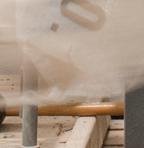






















David Becker, co-founder of Moth re Brewing Co. in Ann Arbor, ordered 25,000 pounds last year.
“Our best-seller is pint break, which is a blonde ale,” Lewis says. “We use wheat and pale malt. We also use wheat, pilsner, pale ale, and Vienna. ere’s no middleman. I call Je or their salesman, Justin Rivard, tell them what we need, and it’s at our place in less than a week. e malts really shine well with our lighter beers. With our pilsners and lagers, the malts really come through, as well.”






Sources: Great Lakes Malting Co., Michigan Beer Guild, Pure Michigan








“We use the pale malt, pilsner, Vienna, and white wheat with almost all our base malts,” says David Becker, co-founder of Moth re Brewing, which o ers more than 40 beers. “Lolo is our best seller, and we use Vienna. It’s a hazy IPA that has a tropical citrus avor. We use the pale malt in most of our 12 IPAs and darker beers as a base malt.
“I have a background in sustainability. We want to minimize our carbon footprint and support local businesses. When people know the farms we utilize produce local ingredients, it gives them a deeper connection to the beer.” 80%/12%/8%
























 BREW CREW
Je and Thomas Hodges, with the Filling Station in downtown Traverse City (right), were Great Lakes Malting Co.’s first customers. Today, they utilize base malt, pilsner malt, and pale malt.
Number of farms utilized in the state
Craft brewers/distillers in Michigan
Annual number of tons to be produced in 2027
BREW CREW
Je and Thomas Hodges, with the Filling Station in downtown Traverse City (right), were Great Lakes Malting Co.’s first customers. Today, they utilize base malt, pilsner malt, and pale malt.
Number of farms utilized in the state
Craft brewers/distillers in Michigan
Annual number of tons to be produced in 2027
600 418/53 6 JULY - AUGUST 2024 || DBUSINESS.COM 83 Exec Life
PATENTS AND INVENTIONS
Mix of Fate
Mabel White Holmes, of Chelsea, built Jiffy ready-mix biscuits into a global brand.
BY NORM SINCLAIR
Alunch date with a schoolmate, arranged by twin brothers Howard and Dudley Holmes at their Chelsea home in April 1930, provided the catalyst for a new industry in Michigan — and the world — that continues to flourish today.
Although the twins’ mother, Mabel White Holmes, had prepared a meal for the boys, their friend’s father, a single parent, packed a lunch for his son.
While the boys were outside, Holmes peeked inside the visitor’s lunch. At the top of the bag was a flat, unappetizing-looking biscuit that she later described as resembling a hockey puck. In that moment, she realized just how difficult it must have been for that father to make a baked treat from scratch.
Inspired by the dad’s hard biscuit, she decided she would invent a prepared baking mix that would be so easy to make that, as she said, “even a man could use it.”
Howard S. Holmes, who operated Chelsea Milling Co., shared his wife’s enthusiasm for the project and encouraged her as she experimented with various ingredients and measurements in the kitchen. It helped that her family also had owned a mill, so she was knowledgeable about flour and baking products.
Mabel White Holmes envisioned a mix that included most of the necessary ingredients inside a box. The package would contain just enough mix to produce baked treats for one family meal, keeping waste to a minimum. After much trial and error, she came up with a product that required only the addition of milk and an egg to make perfect biscuits every time.
The couple now needed a name for their new retail offering. It came soon after, as the pair was driving home through heavy rainfall from a business trip to Chicago. As she rode in the car, Mabel White Holmes had a “eureka moment.”
Reminiscing about her childhood, she recalled her father’s fondness for hot biscuits, and remembered the family cook announcing at lunchtime that the biscuits she was making would be “ready in a jiffy.”
“That’s it!” she exclaimed. “That’s what we’ll call it.”

As America’s first prepared baking mix, Jiffy quickly gained the attention of consumers when one of the country’s largest grocery chains, C.F. Smith, which had 600 stores, began stocking the new Jiffy mix. It was also significant that the product, which cost less than $1, was introduced during the Great Depression, making it a budget-friendly staple for family meals.
Today, Howard “Howdy” Holmes, Mabel’s grandson, is CEO and chairman of the board of Jiffy’s parent company, Chelsea Milling Co. He relates how his grandparents brought out their baking mix product just ahead of the competition.
“As it turns out, there was a General Mills sales guy who was in Detroit checking on things and he happened to see this box of Jiffy all-purpose baking mix,” Holmes says. “Of course he couldn’t get back to Minneapolis (General Mills’ headquarters) fast enough; I believe he took the train. He told his people what he saw in a Smith store and, of course, they followed suit and developed their mix, Bisquick, which came out nine months later in 1931.”
Mabel White Holmes was born in 1890. She graduated from Chelsea High School and Eastern Michigan University, which was known then as Ypsilanti Normal College. Her father owned White Milling Co. in Chelsea, which was later purchased by Harmon Samuel Holmes, a prominent local businessman and mill owner. Harmon Holmes would later turn his milling business over to his son, Howard Sumner Holmes, Mabel’s husband. The name of the combined businesses was changed to Chelsea Milling Co. in 1923.
After Mabel White Holmes’ ready-made mix hit the market, it changed the focus of Chelsea Milling from producing flour for households to creating Jiffy
RISING ABOVE
Co. following the death of her husband, Howard S. Holmes, in 1936.
baking mixes. In 1936, the Holmes family was devastated when Howard Holmes, then age 50, fell 90 feet to his death in one of the company’s grain silos.
Mabel White Holmes succeeded him as president of the company. Her twin sons, Dudley and Howard Jr., then 23 and recent graduates of the University of Michigan, joined her. The transition she and the twins made running the company wasn’t always smooth, Howdy Holmes says.
“My grandmother thought up this idea: One year Dudley would be president and my father, Howard, would be vice president, and then they would trade off every year,” Holmes says, chuckling. “They tried it for a while but that didn’t work out very well.”
As president of the company, Mabel White Holmes solidified the Jiffy brand as the top player in the prepared mix market in the United States. In 1940, she stepped down as president while remaining active with the company for decades on the board of directors.
She died in November 1977, a month shy of her 87th birthday. She was inducted into the Michigan Women’s Hall of Fame in 2015.
Howard Holmes succeeded his mother as president and ran the company for the next 50 years, while Dudley became secretary and treasurer.
When America entered World War II, Dudley Holmes enlisted in the U.S. Navy and saw combat in the Pacific theater. After the war ended, he worked briefly as a commodities broker in Chicago and Detroit before returning to the company.
The brothers are credited with modernizing the Chelsea operation and keeping it ahead of their rivals. Dudley, who oversaw plant operations, designed an advanced test kitchen in the plant.
A skilled baker, Mabel Holmes used a twin-oven stove in the 1940s. During that time, she served as president of Chelsea Milling
Exec Life 84 DBUSINESS || July - August 2024 COURTESY OF JIFFY


READY MIX

“The scales we used were so sensitive they could detect the difference between two and three grains of sugar,” he said. “The mixes had to be done exactly.”
Howard Holmes, who had earned an engineering degree at U-M, introduced computer-controlled warehousing in the plant. He also designed a conveyance system and instituted Jiffy’s policy of shunning advertising, coupons, and giveaways of Jiffy products, which remains in effect today. The distinct blue-topped Jiffy boxes on shelves were advertising enough, he said.
“The reason we don’t advertise is it costs money,” Howdy Homes says. “In business, you want to develop an unfair advantage that your competition can’t duplicate. Everybody else thinks advertising is
the right thing to do. I wouldn’t agree or disagree with that. But by not doing it, we’ve passed those savings on to the consumer.”
Although Holmes began working part time in the Chelsea mill as a teenager, he took a different lane to the top job.
He left Jiffy in 1968 and spent 20 years as a race car driver. After winning the open-wheel racing Formula Atlantic Championship, Holmes moved up to the Indy car circuit, where he became a fan favorite. He competed six times in the Indianapolis 500, driving the Jiffy mix-sponsored Armstrong Wildcat. He was named Rookie of the Year in 1979 and qualified second on the starting grid, in the middle of the front row, for the 1984 Indianapolis 500 race.
Returning to Jiffy and Chelsea in 1988, Holmes brought along his hard-charging racing style and related business experience to Jiffy management. He hired professional managers and introduced business systems that made Team Jiffy, as he dubbed the company, more efficient while remaining true to the company’s distinct family values.
Those efforts vertically integrated all Jiffy functions, making the company more competitive.
“We print our own boxes,” Holmes says. “We store our own wheat. We mill our own flour. Our packaging we do ourselves, so we can control quality and cost better.”
Despite competition from industry giants like Pillsbury and General Foods, Jiffy’s 14 different mixes, varying from biscuits and muffins to pizza and pie crusts, remain leaders in the field.
“Not only is our corn muffin the largest-selling dry grocery item in the United States, our honey corn muffins are at No. 3 in muffins. So we’ve got two of the top three units in dry grocery in the United States,” Holmes says.
The company produces 1.6 million boxes of the top-selling corn muffin mix daily, which Holmes says represents a healthy percentage of the company’s retail profits.
In turn, Jiffy shipped 216 million boxes of mix to retail stores nationwide last year, while the food service division accounted for 101 million pounds of mix, Holmes says.
Jiffy owes its success to his grandmother, Mabel White Holmes, Holmes acknowledges. “To her credit, she invented the first all-purpose baking mix ever and, in essence, she started an industry.”
Top left: Jiffy’s orginal packaging.
Top right: Production plant in Chelsea.
Bottom left: A 1930 patent for a food mixer.
Exec Life July - August 2024 || DBUSINESS.COM 85













































































July 13 1PM-7PM July 14 1PM-5PM HOUR DETROIT’S PRESENTED BY KOWALSKI COMPANIES FOOD | MUsic | Friends Let’s Get Grillin’ Campus Martius ParkDetroit’s Premier Gathering Place More info HourDetroit.com For sponsorship or vending opportunities, contact advertising@hour-media.com PRESENTING SPONSOR MAIN STAGE SPONSOR GRILL SPONSOR GOLD SPONSOR AUTOMOTIVE SPONSOR BEVERAGE SPONSOR Advia is an Equal Opportunity Lender. Federally Insured by NCUA. The community lender large enough to provide big options for your business and small enough to know you by name. You know your business, the area, its challenges, and its advantages. So do we. Partner with the community lender with a history of crafting custom lending solutions and expertise in commercial real estate, working capital, and equipment financing. $5,500,000 Refinance Multifamily Residence in Royal Oak, MI Real Advantages for Business Michigan | Illinois | Wisconsin adviacu.org/commercialloans For digital advertising solutions call 248-268-8025 Frustrated with your web sites search results ? We have IDEAS that work.
Women’s Touch
The Downtown Detroit Partnership and its predecessors have long been led by women who have embraced the goal of making the city a world-class destination.
BY LILA ASANTE-APPIAH
Detroit has a rich legacy of leaders, visionaries, and trailblazers. Henry Ford, Albert Kahn, and Mayor Coleman Young immediately come to mind. Like dozens of others, their names are as familiar as Woodward and Hudson.
But what about Haviland, Richards, and Peck? Less familiar are the women who shaped our incredible history. Laura Smith Haviland created the rst anti-slavery organization in Michigan. Fannie Richards, the rst Black schoolteacher in Detroit, introduced kindergarten programs to Michigan and opposed segregated public schools.
In the 1930s, Frannie Peck founded the Housewives League of Detroit, which supported Black merchants during the Great Depression.
e Downtown Detroit Partnership (DDP), founded in 1922 as the Business Property Association, also has a legacy of strong women leaders from its sta to its board. ese individuals can be credited with helping to make — and continuing to make — downtown Detroit a world-class destination for businesses, residents, and visitors.
eir vision, talents, tenacity, and leadership helped shape Detroit and the DDP.
Born just two years before the Business Property Association was formed in the 1950s, Diane Edgecomb joined what was then known as the Central Business District Association. In 1980, she became the rst woman to lead the CBDA, and was one of the rst women in the country to lead any economic development organization.
Many readers will recall Edgecomb’s incredible vision and close friendship with Mayor Young. She understood the importance of public- and private-sector collaboration, and she was a trailblazer, creating the rst Ethnic Festival, championing the installation of lights on the Ambassador Bridge, and crossing international boundaries to develop key sister-city relationships for Detroit.
She also started Salute to Women Who Work, an annual event that brought hundreds of women downtown to recognize their contributions.
In 1997, Linda Bade, an assessor for the City of Detroit, took the reins as president. Bade’s tenure was equally impactful. She changed the name from the Central Business District Association to Detroit Downtown Inc. (DDI), realizing the power and
potential of a vibrant, thriving urban core and the need to create a clean, safe, beautiful, and inviting downtown.
Bade championed Public Act 260, which paved the way for forming the Downtown Detroit Business Improvement Zone. Today, the BIZ, as it’s known, supports 591 businesses in the city by supplementing infrastructure, maintenance, lighting, safety, and other programs that help create a clean, safe, and welcoming downtown for businesses, residents, and visitors alike.
e BIZ celebrates its 10th anniversary this year.
In 2005, Kate Beebe led the Greater Downtown Partnership, which would later merge with the DDI to create the Downtown Detroit Partnership.
Beebe’s accomplishments include the Lower Woodward Agenda, a reinvestment strategy that brought more than $100 million in public and private investment to downtown, the formation of Eastern Market Corp., and negotiating an agreement with the city for EMC to manage and improve the market.
to lead the BIZ. She spearheads all of the DDP’s programs, including the BIZ Ambassadors, digital kiosks, job fairs, and other activities that support the downtown business community. In 2023, the supporting businesses unanimously voted to extend the BIZ for another 10 years.
ese initiatives are only possible with the leadership of DDP board chair Cindy Pasky. Pasky started Strategic Sta ng Solutions in Detroit more than 30 years ago; today, her $350-million, full-service business and IT consulting rm has 3,600 direct consultants in 49 U.S. states and 27 countries across Europe, the Americas, and Asia.
Pasky was named to the DDP board in 2005 and became chair in 2010. She’s one of the city’s, and the DDP’s, most enthusiastic boosters, and has devoted countless hours and resources to supporting its mission (as well as those of many other organizations).


e DDP is stronger and more in uential than ever before, thanks to her leadership and that of all the women who have made the organization the success it











Both Bade and Beebe were instrumental in helping prepare Detroit for Super Bowl XL in 2006. e played a pivotal role in securing, planning, and execomed a record-breaking 775,000 visitors over three
Both Bade and Beebe were instrumental in helping prepare Detroit for Super Bowl XL in 2006. e results of their work continue to be seen, as the DDP played a pivotal role in securing, planning, and executing the 2024 NFL Draft in Detroit, which welcomed a record-breaking 775,000 visitors over three days (April 25-27).




women who have made the organization the success it is today.





In addition, Njia Kai has made a lasting impression and has been a steady presence at the DDP as an


pany, NKSK Events + Production, she has produced festivals around Detroit as well as hundreds of events in DDP parks. As an early team member of the Detroit 300 Conservancy, she was part of a group of visionaries who created the

In addition, Njia Kai has made a lasting impression and has been a steady presence at the DDP as an event planner and a placemaker. rough her company, NKSK Events + Production, she has produced festivals around Detroit as well as hundreds of events in DDP parks. As an early team member of the Detroit 300 Conservancy, she was part of a group of visionaries who created the city’s centerpiece: the award-winning Campus Martius Park.

















Today, an impressive 75 percent of the DDP team consists of women, with 42 percent at director and executive levels. Each woman serves the organization’s members and executes its programming with skill, passion, and unyielding commitment.
utive levels. Each woman serves the organization’s members and executes its programming with skill, passion, and


Gina Cavaliere, DDP’s chief community impact o cer and Downtown Detroit Business


Gina Cavaliere, DDP’s chief community impact o cer and Downtown Detroit Business Improvement Zone director, joined the DDP




Lila Asante-Appiah is chief administrative o cer of the Downtown Detroit Partnership. In her role, she designs and implements organizational development practices. She also manages the organization’s operations, administrative processes, and DEI initiatives. Her leadership helps ensure all DDP programs, from policies to public spaces, are inclusive and accessible.
OPINION COURTESY OF DDP
LILA ASANTE-APPIAH
Exec Life JULY - AUGUST 2024 || DBUSINESS.COM 87
DETROIT SOIRÉE
CHRISTINE MJ HATHAWAY
The Entrepreneurs’ Organization (EO) Detroit gathered for its 2024 Annual Party on May 31 at the 13th Floor Conservatory Ballroom in the Book Tower Detroit, along Washington Boulevard in downtown Detroit. Participants at the sold-out event were treated to a cocktail reception, a plated dinner, live entertainment by Dal Bouey, dancing, a dessert table, and late-night snacks. The organization also welcomed John Anderson, David Galbenski, Kristina Marshall, and Gino Wickman into the EO Detroit Hall of Fame.
1. Dan Glisky, Christel Gaillard, Rajesh Iyengar, Ritika Nigam
2. Mark Biebuyck, Audrey and Jason Brown
3. Seth and Arielle Helfman
4. Ron LaPointe, Andrea and Chris Lambert
10. Paul Smith, Gretchen Hopp Doyle






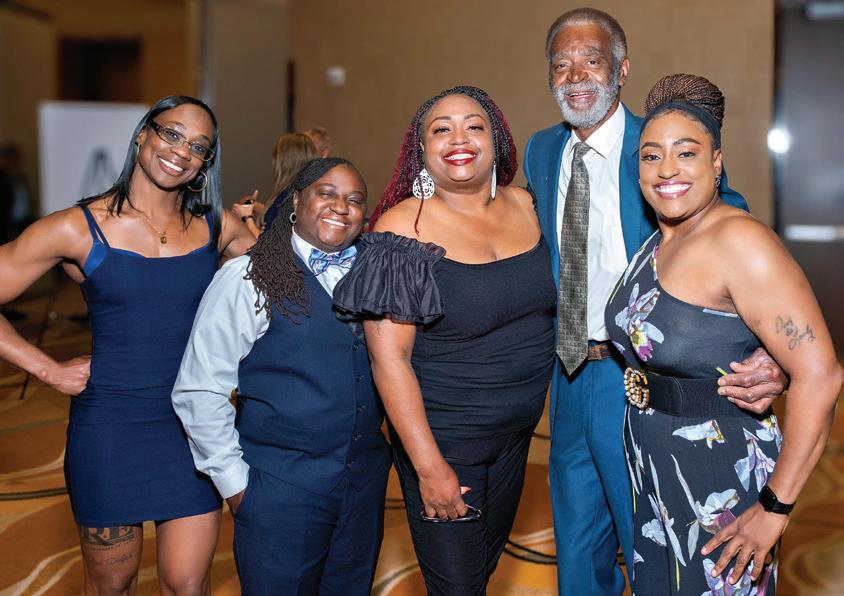

FRENCH AFFAIR
PATRICK GLORIA
The French American Chamber of Commerce Michigan Chapter hosted its 2024 Gala and Award Ceremony on May 15 at the Henry Ford Museum of American Innovation in Dearborn. The evening was highlighted by a conversation between Ford Motor Co. CEO Jim Farley and automotive journalist John McElroy. Other special guests included Deputy General Consul Clément Calais and Honorary Consul Cedric Ballarin. Sponsors included Alten, Araymond, BCG, Dawda Mann, Ducker Carlisle, Forvia, Ghafari, Siemens, ATEQ Corp., MEDC, Valeo, Butzel Long, Bosal, Fakhoury Global Immigration, Plante Moran, Delta Air Lines, M1 Concourse, Wipfli, and Woodberry.
11. Ahmad Ezzeddine, Clara DeMatteis Mager, Nicholas Stasevich
12. Bertrand Rakoto, John McElroy, Xavier Mosquet, Jim Farley
13. Amy and Scott Harris
14. Noah Vandenbulke, Francke Vandenbulke
15. Sebastian and Emily Mucherie

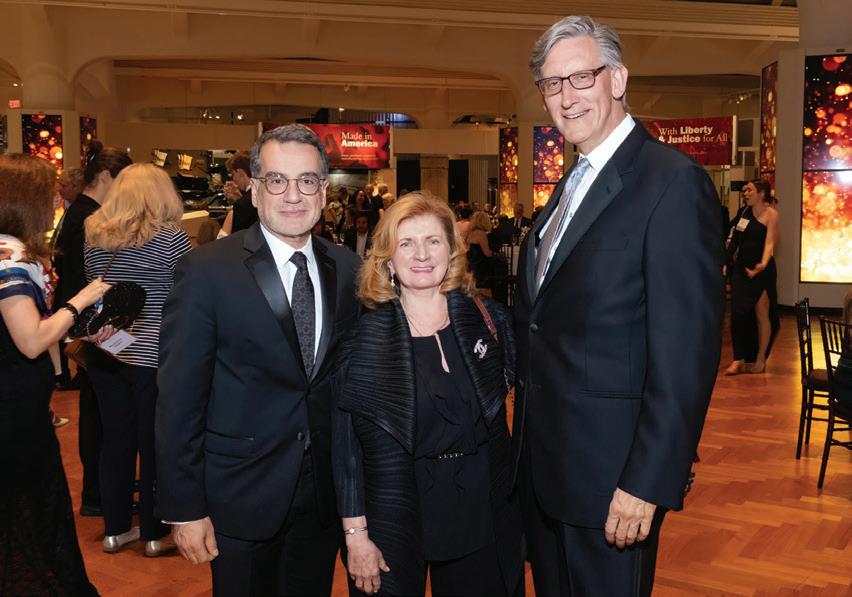


WOMEN IN BLUE
PATRICK GLORIA
The Detroit Public Safety Foundation hosted its 11th annual Women in Blue breakfast on May 23 at the MGM Grand in Detroit. The event highlights the women who serve with the Detroit Police and Fire departments. In addition, awards were given for the Women in Blue Officer of the Year and the DFD Woman of the Year. This year’s keynote speaker was Michigan Attorney General Dana Nessel. The event supports the Detroit Public Safety Foundation, the nonprofit supporting Detroit Police and Fire by securing grants and donations to meet priority projects not otherwise funded in the city’s budget.
6. Lena Epstein, Lisa Porter, Marjory Winkleman Epstein
7. Tamara Donaldson, Kelly Lucy, Kiana Sweeney, John Lucy, Kristy Elswick
8. Mary Sheffield, Anne Mervenne
9. Terance Grimes, Sgt. Cassandra Spike, Carl Clarke
10. Patti Kukula, Cynthia Ford
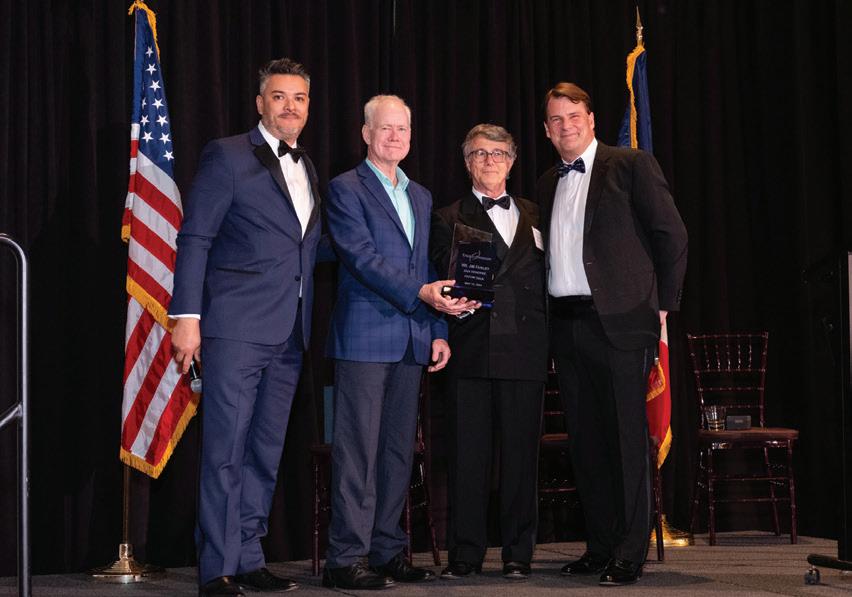


Exec Life 88 DBUSINESS || July - August 2024 1 2 3 4 5 6 7 8 9 10 11 12 13 14 15

DETROIT RIVERFRONT POLO & FASHION CLASSIC
July 14 - 11 a.m.-9 p.m. poloandprettywomen.com/
Mark your calendars for July 14 — a day filled with thrilling polo matches, fabulous fashion shows, lively lawn parties, and a diverse range of food and dry goods vendors. This event promises to be the ultimate highlight of the summer, and you won’t want to miss out! To secure your spot at this amazing experience, make sure to get your tickets now at poloandprettywomen.com. Don’t delay, as this event is sure to sell out quickly! The event takes place at the Riverside Marina, located at 1100 Freud, Detroit. Spread the word, invite your friends, and let’s make this event one for the books! Proceeds support Dave’s Choice Community Development Corp.
NEW DAY GOLF CLASSIC
July 15 - 10 a.m.-7 p.m. foundationforfamilies.org/
Support local families facing cancer and enjoy a day of golf at The Wyndgate, one of Michigan’s most challenging and beautiful golfing experiences. The schedule Includes:
• 10 a.m. — Registration open
• 10:30-11:45 a.m. — Lunch
• 12 p.m. — Shotgun start; 18-hole scramble; beverage stations on the course
• 5-7 p.m. — Dinner on the terrace with hearty appetizers, carving stations, and an open bar.
GROSSE POINTE GATHERING
July 17 - 5:30-8:30 p.m. beaumont.org/giving/events
Join us for the Grosse Pointe Gathering, a festive summer evening benefiting Corewell Health Beaumont Grosse Pointe Hospital’s spiritual care endowment fund. The endowment helps to further integrate the medical and spiritual care needs of patients, families, and caregivers and enhance patient outcomes. The evening will include creative cocktails, a sumptuous strolling dinner, outdoor activities, and live entertainment at a private lakeside residence in Grosse Pointe Shores. For more information and event registration, visit: beaumont.org/giving/events
ORCHARD LAKE FINE ART SHOW
July 27-28 - 10 a.m.-6 p.m. hotworks.org/
Art lovers return year after year to West Bloomfield’s rolling green hills and lavish views, which provide an exceptional setting for HotWorks.org’s 21st Hot Works Orchard Lake Fine Art Show. The event showcases up to 150 renowned artists from all over the country offering original handmade works, so you’re sure to find something for everyone, in all price ranges. Voted 12 times as one of the top 100 juried art shows in America, Hot Works welcomes you to enjoy live entertainment and great food, ranging from lemonade to lobster. Ample free parking is available in the back half of the lot behind Beaumont Medical Center, 6900 Orchard Lake Road, West Bloomfield.
TROY TRAFFIC JAM
Aug. 4 - 10 a.m.-3 p.m. troyhistoricvillage.org/







Legacy vehicles, your favorite classics, and high-end exotics will fill the 16th Annual Troy Traffic Jam on Sunday, August 4, from 10 a.m.-3 p.m. at the Columbia Center on Big Beaver Road. Troy’s premier automotive festival is more than just a car show! You’ll enjoy Tech Talks with leading designers, demonstrations by local robotics teams, pedal car races for the youngest car enthusiasts, and live music. This year, the Troy Traffic Jam is celebrating two notable automotive anniversaries: the GTO and the Mustang. The event is free to the public, but registration to show your car is $25 in advance or $30 on-site. All proceeds fuel education at the Troy Historic Village, a nonprofit organization that enables a life-long exploration of history through field trips, workshops, talks, and other creative, meaningful experiences. Troy Traffic Jam Registration and more information can be found at troytrafficjam.com, or follow us on Facebook and Instagram!

ADVERTISEMENT
FUN WITH SUN
LINDSAY SCHWEICKERT
ULI Michigan hosted the 2024 Lifetime Achievement Award Dinner honoring Gary A. Shiffman, CEO and chairman of Sun Communities Inc. in Southfield, on May 1 at the MGM Grand Casino Hotel in Detroit. The Lifetime Achievement Award was established to recognize leaders in the Michigan real estate community whose achievements throughout their lifetime exemplify the spirit and mission of ULI (Urban Land Institute). The event, which raised funds for ULI Michigan’s programs and initiatives, began with a reception, followed by dinner and an awards presentation.
1. Brian and Jennifer Hermelin, Steve Rosenthal
2. Lisa and Gary Shiffman, Luciano DelSignore, Nicole Antakli
3. Eric Larson, Ebon Betty, Bob Doil
4. Dan Morse, Jeffrey Schostak, Ron Boji
5. Alon and Jenna Kaufman








CARS AND CIGARS
PATRICK GLORIA
Hosted by Detroit entrepreneurs Tom Celani and Dario Bergamo, the sold-out 10th annual Cars & Cigars Smoke Detroit took place on June 6 at the Michigan Lottery Amphitheatre at Freedom Hill in Sterling Heights. More than 1,800 participants enjoyed an exotic car show; a reception with cigars, live music, appetizers, and beverages; a sit-down dinner; and a live auction. Proceeds will benefit the Cigar Family School in the Dominican Republic and the Celani Charitable Foundation, which works with local Detroit charities like Gleaners Community Food Bank and the Capuchin Soup Kitchen.
11. Bruce Smith, Brian Cousins, Lomas Brown, Bob Krause
12. Bryan Hanson, Rich Royer, Brandon Cochran
13. Greta Bourbeau, Denise Annas, Joe Lucido
14. Joe Aesy, Jim George, Jim Michaels
15. Robert Krall, Dario Bergamo




MARKET RISE
LINDSAY SCHWEICKERT
The ACG Detroit M&A All-Star Awards Dinner took place on May 6 at the Townsend Hotel in downtown Birmingham. Attendees enjoyed networking, a strolling buffet, an open bar, and an awards ceremony led by Diamond sponsor Foley & Lardner. Awards were given in several M&A categories, including Deals of the Year Over and Under $50 million, Adviser of the Year, Dealmaker of the Year, Investment Banker of the Year, and Rising Star. The late Thomas S. Vaughn of Dykema was given a Lifetime Achievement Award. Other sponsors included BDO, Datasite, Peninsula Capital Partners, AON, Blue River Financial Group, Chase/JPMorgan, and Waseyabek Development Co. Profiles of the award-winners are in the May/ June 2024 issue of DBusiness magazine.
6. Andrea Selke, Rachel Locricchio, Kelly McConnell
7. Julia Baran, Scott Reilly, Kim Easterle Mattes
8. James Parchell, Hope Jackson
9. Omar Lucia, Andrew Dickow, Michelle Dickow
10. The late Thomas S. Vaughn

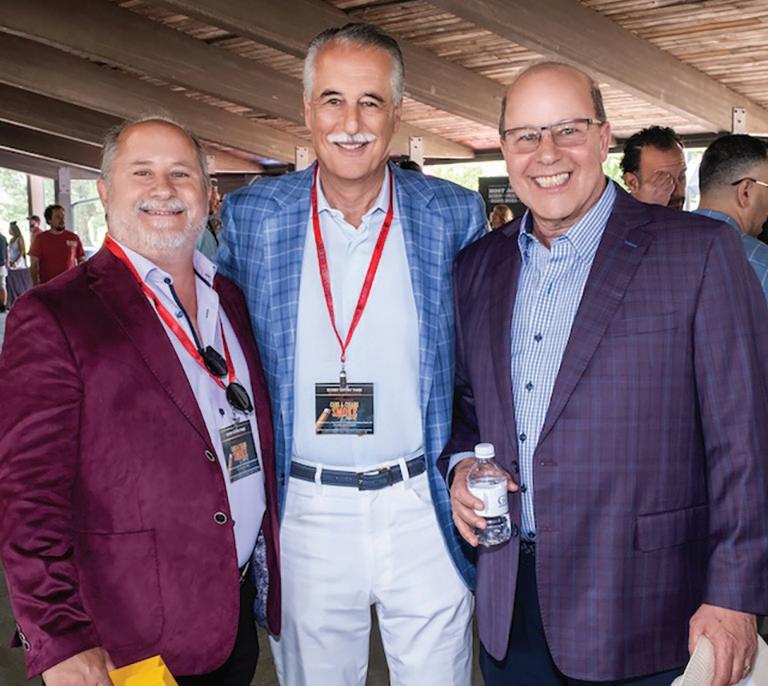

Exec Life 90 DBUSINESS || July - August 2024 1 2 3 4 5 6 7 8 9 10 11 12 13 14 15

USA PARA DANCE SPORT COMPETITION
Aug. 10-11 - Various Times rimfoundation.org
The RIM Foundation is excited to bring the Para Dance Sport USA Open to the Dearborn Community & Performing Arts Center Aug. 10-11. This historic event will welcome more than 100 of the world’s best wheelchair ballroom dancers from over 20 countries. Para Dance Sport is an extremely elegant, graceful, and stylish sport that involves athletes who use a manual or power wheelchair due to a physical disability. Para Dance competitions have been hosted throughout Europe and Asia since the 1970s, but have never taken place in North America until now. Para dancers compete in two categories: a wheelchair dancer with a standing partner (Combi), or two athletes in wheelchairs (Duo). Athletes compete in all ballroom dances including the Waltz, Foxtrot, Tango, Cha Cha, Samba, and Jive. Freestyle events can include everything from hip hop to contemporary, ballet, or folk dancing.
VARIETY SHINE FASHION SHOW
Aug. 25 - 2-3:30 p.m. variety-detroit.com/
The Variety SHINE Fashion Show takes place on Sunday, August 25, at Somerset Collection South Rotunda in Troy. This beautiful fashion show, featuring the children of Variety and friends from FAR Therapeutic Arts & Recreation, will capture the hearts of all in attendance as the models rock the runway in the latest back-to-school fashions from Somerset Collection retailers. The children will be accompanied by community mentors whose dedication to these programs is simply astounding. This captivating afternoon will benefit two therapeutic programs for those with special needs: FAR’s Making Music with Friends, and the Variety 4-H Horseback Riding program.


August 26 - 9:30 a.m.-6 p.m. beaumont.org/giving
The Feldman Automotive Children’s Miracle Celebrity Invitational is a unique celebrity golf event where every foursome enjoys an up-close and personal celebrity pairing. This partnership between Corewell Health Children’s and the Mark Wahlberg Youth Foundation features 50 national and local celebrities from the world of entertainment and professional sports. The Invitational provides a full day of golf on the premier courses of the Detroit Golf Club, all-day hospitality, and a live auction of over-the-top experiences. All proceeds benefit the Children’s Miracle Network at Corewell Health Children’s and the Mark Wahlberg Youth Foundation. For sponsorship details, visit Beaumont.org/giving/events.
2024 GREENS ’N’ GRAPES GOLF + WINE EVENT
Oct. 4 - 10 a.m.-10 p.m. migreengrape.com
The 2024 Greens ’n’ Grapes Golf + Wine event at St John’s Resort combines a competitive golf tournament throughout the day with world-class wine and craft brewing offerings during the evening. Start your day at the brand-new Cardinal Golf Course (opened May 2024) with a four-person golf scramble and 18 individual experiences from wineries, craft brewers, and some of the best local foods available.
The evening event transitions from the course to an exclusive Grand Tasting event with wine sampling from local, national, and international wineries, coupled with chef-prepared hors d’oeuvres and small-plate offerings from Five Steakhouse. The evening event also features award-winning musical artists including the Walter Blanding Jazz Trio and Northville Folk. This year’s event proudly supports both the Ronald McDonald House Charity of Ann Arbor and the Northville Educational Foundation.
Tickets will be available for purchase beginning July 1 at migreengrape.com.

FELDMAN AUTOMOTIVE CHILDREN’S MIRACLE CELEBRITY INVITATIONAL




ADVERTISEMENT
LARGEST ACCOUNTING FIRMS IN METRO DETROIT
(RANKED BY METRO DETROIT-AREA EMPLOYMENT)
1. DELOITTE
1001 Woodward Ave.
Detroit
313-396-3000
deloitte.com
Top Local Executive: David Parent, Managing Partner
Detroit-area Employees:
2024: 1,445
2023: 1,476
Michigan Employees:
2024: 1,624
2023: 1,701
Number of CPAs:
2024: 332 2023: 342
2. PLANTE MORAN*
3000 Town Center, Ste. 100
Southfield
248-352-2500
plantemoran.com
Top Local Executive: James Proppe, Managing Partner
Detroit-area Employees: 2024: NA 2023: 1,408
Michigan Employees: 2024: NA 2023: 1,904
Number of CPAs: 2024: NA 2023: 683
3. ERNST & YOUNG*
One Kennedy Square
777 Woodward Ave., Ste. 1000
Detroit
313-628-7100
ey.com
Top Local Executive: Angie Kelly, Detroit Managing Partner
Detroit-area Employees: 2024: NA 2023: 795
Michigan Employees: 2024: NA 2023: 935
Number of CPAs: 2024: NA 2023: 284 (Michigan)
4. UHY*
Chrysler House
230 E. Grand River Ave., Ste. 700
Detroit
313-964-1040
uhy-us.com
Top Local Executive: Tom Callan, Great Lakes Managing Partner
Detroit-area Employees: 2024: NA 2023: 553
Michigan Employees: 2024: NA 2023: 592
Number of CPAs: 2024: NA 2023: 204
5. DOEREN MAYHEW*
305 W. Big Beaver Rd., Ste. 200 Troy
248-244-3000 doeren.com
Top Local Executive: Chad Anschuetz, Managing Shareholder
Detroit-area Employees: 2024: NA 2023: 301
Michigan Employees: 2024: NA 2023: 417
Number of CPAs: 2024: NA 2023: 138
6. REHMANN
1500 W. Big Beaver Rd. Troy
248-952-5000 rehmann.com
Top Local Executive: Ryan Krause, Regional Managing Principal
Detroit-area Employees: 2024: 376 2023: 345
Michigan Employees: 2024: 777 2023: 772
Number of CPAs: 2024: 253 2023: 257
7. BDO USA
2600 W. Big Beaver Rd., Ste. 600 Troy 248-362-2100 bdo.com
Top Local Executives: Matt Manosky, Tax Practice Leader; Kevin Patterson, Assurance Market Leader; Andy Zaleski, Tax Market Leader; John Marquardt, Tax Managing Partner; Tony Lawrence, Assurance Managing Partner
Detroit-area Employees: 2024: 280 2023: 225
Michigan Employees: 2024: 980 2023: 926
Number of CPAs: 2024: 244 2023: 245
8. GRANT THORNTON 2777 Franklin Rd., Ste. 800
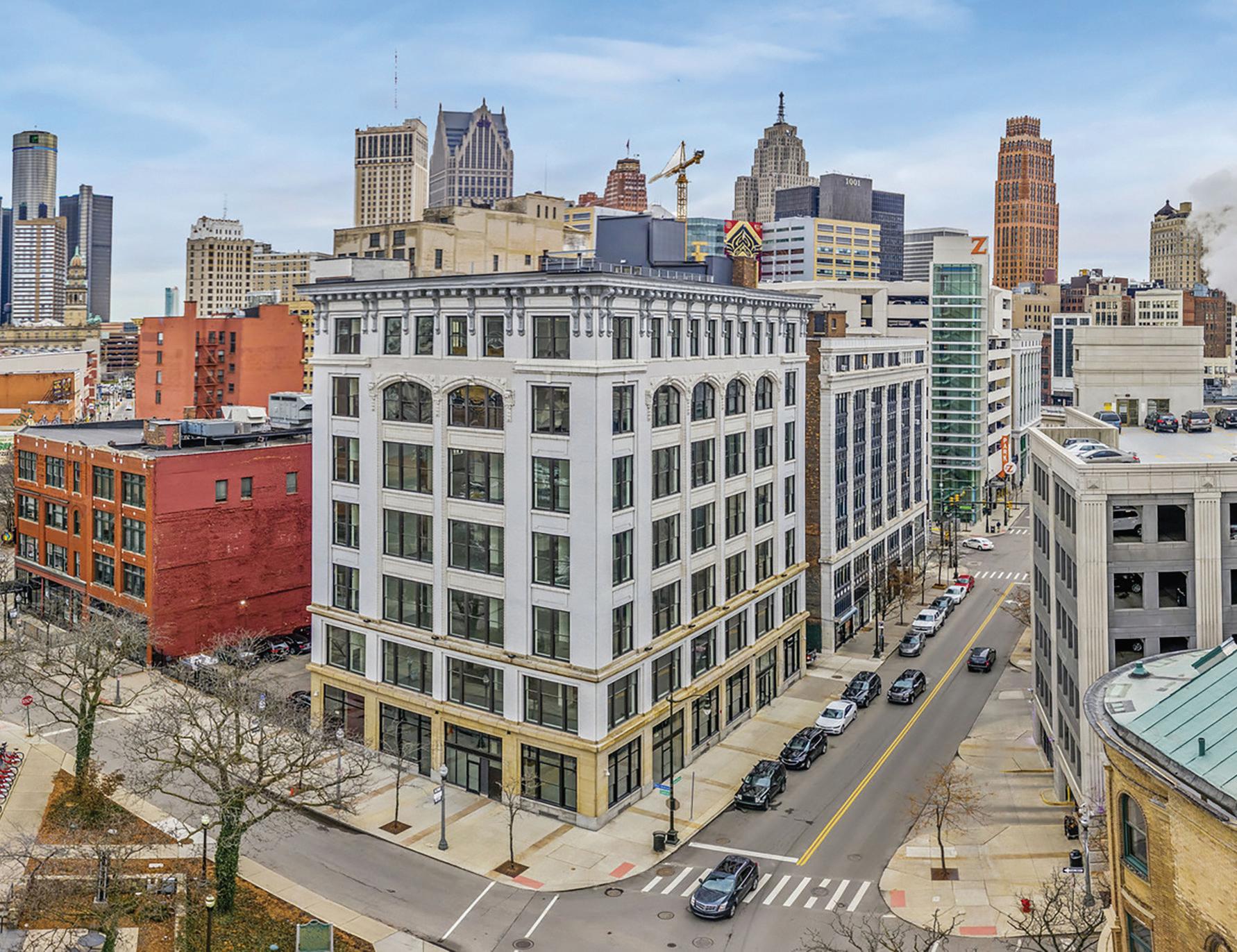
Southfield 248-262-1950
grantthornton.com
Top Local Executive: Jim Tish, Office Managing Partner
Detroit-area Employees: 2024: 104 2023: 91
Michigan Employees: 2024: 104 2023: 91
Number of CPAs: 2024: 46 2023: 46
9. WIPFLI (Formerly Clayton & McKervey) 2000 Town Center, Ste. 1800 Southfield 248-208-8860 claytonmckervey.com
Top Local Executive: Rob Dutkiewicz, President
Detroit-area Employees: 2024: 68 2023: NA
Michigan Employees: 2024: 78 2023: NA
Number of CPAs: 2024: 33 2023: NA
10. COLE, NEWTON & DURAN* 33762 Schoolcraft Rd. Livonia 734-427-2030
cndcpa.com
Top Local Executive: Christopher Boloven, Managing Partner
Detroit-area Employees: 2024: NA 2023: 47
Michigan Employees: 2024: NA 2023: 47
Number of CPAs: 2024: NA 2023: 18
11. EDWARDS, ELLIS & ASSOCIATES* 2155 Butterfield Dr., Ste. 305 Troy 248-643-4545
eeacpas.com
Top Local Executive: Jeffrey B. Ellis, CPA
Detroit-area Employees: 2024: NA 2023: 37
Michigan Employees: 2024: NA 2023: 37
Number of CPAs: 2024: NA 2023: 13
12. MRPR GROUP, CPAS AND ADVISORS
28411 Northwestern Hwy., Ste. 800 Southfield 248-357-9000 mrpr.com
Top Local Executive: Angie Mastroionni, President & Managing
UHY, DETROIT
COURTESY UHY
92 DBUSINESS || July - August 2024
From the Top
Principal
Detroit-area Employees:
2024: 25
2023: 24
Michigan Employees:
2024: 45
2023: 45
Number of CPAs:
2024: 21
2023: 22
13. GORDON ADVISORS*
1301 W. Long Lake Rd., Ste. 200 Troy
248-952-0200
gordoncpa.com
Top Local Executives: Paul J. Arment and Maureen M. Moraccini, Executive Committee
Detroit-area Employees:
2024: NA
2023: NA
Michigan Employees:
2024: NA
2023: NA
Number of CPAs: 2023: NA 2023: NA
14. BAKER TILLY US*
2000 Town Center, Ste. 900 Southfield
248-372-7300
bakertilly.com
Top Local Executive: Patrick Killeen, Michigan Managing Partner
Detroit-area Employees:
2024: NA
2023: NA
Michigan Employees:
2024: NA
2023: NA
Number of CPAs:
2024: NA
2023: NA
15. KPMG*
150 W. Jefferson Ave., Ste. 1900 Detroit
313-230-3000
kpmg.com
Top Local Executive: Kevin Voigt, Office Managing Partner, Detroit and Grand Rapids
Detroit-area Employees: 2024: NA
2023: NA
Michigan Employees:
2024: NA
2023: NA
Number of CPAs: 2024: NA
2023: NA
*Did not respond to requests for information.
Source: DBusiness research
LARGEST BANKS AND THRIFTS IN METRO DETROIT
(RANKED BY 2023 ASSETS)
1. HUNTINGTON BANK* 2025 Woodward Ave. Detroit
866-258-1807
tcfbank.com
Top Local Executive: Mike Land, President, Southeast Michigan and Ohio Market
Assets 2023: $188.7B
Assets 2022: $183B
Net Income 2023: $2.1B
Net Income 2022: $1.45B
Total Loans 2021: $120.1B
Total Loans 2022: $119B
2. FLAGSTAR BANK 5151 Corporate Dr. Troy 248-312-5400
flagstar.com
Top Local Executive: Alessandro
HUNTINGTON TOWER, DETROIT
Dinello, Chairman of New York Community Bancorp and Flagstar Bank Assets 2023: $116.2B Assets 2022: $90B
Net Income 2021: $2.4B
Net Income 2022: $650M Total Loans 2021: $84.8B Total Loans 2022: $69B
3. COMERICA BANK*
411 W. Lafayette Blvd. Detroit 313-222-4000 comerica.com
Top Local Executive: Steve Davis, Michigan Market President Assets 2023: $85.9B Assets 2022: $85.5B Net Income 2023: $876M
Income 2022: $1.14B Total
4.
Arbor
734-662-1600
bankofannarbor.com
Top Local Executive: Tim Marshall, President & CEO
Assets 2023: $3.08B
Assets 2022: $3.01B
Net Income 2021: NA
Net Income 2022: $48.5M
Total Loans 2023: NA
Total Loans 2022: $1.8B
6. CHOICEONE BANK
109 E. Division St. Sparta 616-205-0321
choiceone.com
Top Local Executive: Kelly J. Potes, CEO
Assets 2023: $2.5B
Assets 2022: $2.3B
Net Income 2023: $23M
Net Income 2022: NA
Total Loans 2023: $1.3B
Total Loans 2022: $1.1B
7. STERLING BANK AND TRUST
One Towne Square, Ste. 1900 Southfield 248-355-2400
sterlingbank.com
Top Local Executive: Thomas M. O’Brien, Chairman, President & CEO
Assets 2023: $2.4B
Assets 2022: $2.4B
Net Income 2023: $10.5M
Net Income 2022: $13.1M
Total Loans 2023: $1.3B
Total Loans 2022: $1.62B

8. FIRST STATE BANK
24300
Loans 2023 (FY average): $51.6B Total Loans 2022 (FY average):
Net
$52.7B
FIRST MERCHANT BANK 32991 Hamilton Court Farmington Hills 800-205-3565
Assets 2022:
Net Income 2023:
Net Income 2022:
Total Loans 2021: NA Total Loans 2022: $12B
levelonebank.com Top Local Executive: Terri Cable, Regional President Assets 2023: $12.3B
$17.9B
$236.1M
$220.7M
5. BANK OF ANN ARBOR 125 S. Fifth Ave. Ann
Local Executive:
Lovell, President
CEO Assets
Assets 2022:
Net Income
Net Income 2022: $10M Total Loans 2023: $667.9M Total Loans 2022: $612.4M
Little Mack Ave. St. Clair Shores 586-775-5000 fsb.bank Top
Gene
&
2023: $1.1B
$957.9M
2023: $13.7M
& CEO Assets 2023: $909.7M Assets 2022: $781.5M Net Income 2023: $8.5M Net Income 2022: $4.73M Total Loans 2023: $797M Total Loans 2022: $625.7M
9. UNIVERSITY BANK 2015 Washtenaw Ave. Ann Arbor 734-741-5858 university-bank.com Top Local Executive: Stephen L. Ranzini, President
60 S. Washington St. Oxford 248-628-2533 oxfordbank.com Top Local Executive: David Lamb, President & CEO Assets 2023: $816.6M Assets 2022: $792.5M Net Income 2023: $12.5M Net Income 2022: $9.5M Total Loans 2021: $411.1M Total Loans 2022: $536.5M 11. FIRST INDEPENDENCE BANK 7310 Woodward Ave., Ste. 101 Detroit 313-256-8400 firstindependence.com Top Local Executive: Kenneth Kelly, Chairman & CEO Assets 2023: $607.1M Assets 2022: $468.4M Net Income 2023: $1.8M Net Income 2022: $1.3M Total Loans 2023: $374.5M Total Loans 2022: $266.1M
CHELSEA STATE BANK 1010 S. Main St. Chelsea
Top Local Executive: Joanne Rau, President & CEO Assets 2023: $403.6M Assets 2022: $424.4M Net Income 2023: $8.6M Net Income 2022: $6.6M Total Loans 2023: $240.4M Total Loans 2022: $219.9M
DEARBORN FEDERAL SAVINGS BANK 22315 Michigan Ave. Dearborn 313-565-3100 mydfsb.com Top Local Executive: William R. White, Chairman & President Assets 2023: $268.9M Assets 2022: NA From the Top July - August 2024 || DBUSINESS.COM 93 COURTESY BRINKER
10. OXFORD BANK
12.
734-475-1355 chelseastate.bank
13.
Net Income 2023: $253K
Net Income 2022: $272K
Total Loans 2023: $196.8M
Total Loans 2022: $190M
14. MI BANK
3707 W. Maple Rd., Ste. 100 Bloomfield Township 855-642-2651
mi.bank
Top Local Executive: Rob Farr, Chairman & CEO
Assets 2023: $236.1M
Assets 2022: $203.7M
Net Income 2023: $453K
Net Income 2022: $263K
Total Loans 2023: $196.8M
Total Loans 2022: $142.1M
15. HURON VALLEY STATE BANK
130 S. Milford Rd. Milford 248-684-9626
hvsb.com
Top Local Executive: Jack Shubitowski, President & CEO
Assets 2023: $232.2M
Assets 2022: $228.1M
Net Income 2023: $2.6M
Net Income 2022: $2M
Total Loans 2023: $174.9M
Total Loans 2022: $150.1M
* Numbers are national figures.
Total financial results are listed for banks headquartered in Wayne, Oakland, Macomb, Livingston, and Washtenaw counties. For banks headquartered outside this area, local results only are provided. Many national banks do not release results for individual markets; therefore, major institutions aren’t included on this list. Total loans also account for leases.
Sources: Federal Deposit Insurance Corp., DBusiness research
LARGEST CREDIT UNIONS IN METRO DETROIT
(RANKED BY 2023 ASSETS)
1. DFCU FINANCIAL
400 Town Center Dr. Dearborn
888-336-2700
dfcufinancial.com
Top Local Executive: Ryan
Goldberg, President & CEO
Assets 2023: $6.2B
Assets 2022: $6B
Total Income 2023: $225.3M
Total Income 2021: $167.86M
Total Loans 2023: $1.75B
Total Loans 2022: $1B
2. GENISYS CREDIT UNION
2100 Executive Hills Blvd. Auburn Hills
248-322-9800
genisyscu.org
Top Local Executive: Jackie Buchanan, CEO
Assets 2023: $4.85B
Assets 2022: $4.4B
Total Income 2023: $225M
Total Income 2022: $200.7B
Total Loans 2023: $3.6B
Total Loans 2022: $3.2B
3. MICHIGAN SCHOOLS AND GOVERNMENT CREDIT UNION
40400 Garfield Rd. Clinton Township
586-263-8800
msgcu.org
Top Local Executive: Peter D.
Gates, President & CEO Assets 2023: $3.62B Assets 2022: $3.2B Total
4. COMMUNITY CHOICE CREDIT UNION 31155 Northwestern Hwy. Farmington
877-243-2528 communitychoice.com Top
5.
GENISYS,
AUBURN HILLS
6. COMMUNITY FINANCIAL CREDIT UNION
500 S. Harvey St. Plymouth 734-453-1200
cfcu.org
Top Local Executive: Tansley Stearns, President & CEO
Assets 2023: $1.59B
Assets 2022: $1.5B
Total Income 2023: $99.2M
Total Income 2022: $68.2M
Total Loans 2023: $1.48B
Total Loans 2022: $1.4B
7. MICHIGAN FIRST CREDIT UNION 27000 Evergreen Rd. Lathrup Village 800-664-3828 michiganfirst.com
Top Local Executive: Jennifer Borowy, President & CEO
Assets 2023: $1.5B
Assets 2022: $1.4B
Total Income 2023: $122.35M
Total Income 2022: $108.3M
Total Loans 2023: $1.07B
Total Loans 2022: $1.07B
8. UIVERSITY OF MICHIGAN CREDIT UNION
340 E. Huron St., Ste. 100 Ann Arbor 734-662-8200
umcu.org
Top Local Executive: Tiffany Ford, CEO
Assets 2023: $1.35B
Assets 2022: $1.3B
Total Income 2023: $64.48M
Total Income 2022: $52.7M
Total Loans 2023: $1.06B
Total Loans 2022: $1.06B
9. MICHIGAN EDUCATIONAL CREDIT UNION 9200 N. Haggerty Rd.
Plymouth 734-455-9200 michedcu.org
Top Local Executive: Robert Sandercock, President & CEO
Assets 2023: $1.23B
Assets 2022: $1.03B
Total Income 2023: $70.6M
Total Income 2022: $28.9M
Total Loans 2023: $868.3M
Total Loans 2022: $519.4M
10. VIBE CREDIT UNION 44575 W. 12 Mile Rd. Novi 248-735-9500 vibecreditunion.com
Top Local Executive: Chaz
Rzewnicki, President & CEO
Assets 2023: $1.2B
Assets 2022: $1.2B
Total Income 2023: $17.4M
Total Income 2022: $60.8M
Total Loans 2023: $868M
Total Loans 2022: $792.7M
11. CHRISTIAN FINANCIAL CREDIT UNION 35100 Van Dyke Ave. Sterling Heights 586-772-6330
christianfinancialcu.org
Top Local Executive: Patricia L. Campbell, President & CEO
Assets 2023: $855.9M
Assets 2022: $819.8M
Total Income 2023: $21.69M
Total Income 2022: $36.3M
Total Loans 2023: $591.8M
Total Loans 2022: $518.7M
12. ZEAL CREDIT UNION 17250 Newburgh Rd. Livonia 800-321-8570 zealcreditunion.org

Income
Income 2021:
Total Loans
2023: $159.9M Total
$116.8M
2023: $3.1B Total Loans 2022: $2.8B
Hills
Local Executive:
President
CEO Assets 2023:
Assets 2022:
Total Income
Income 2022: $83.9M Total Loans 2023:
Total Loans 2022:
Robert Bava,
&
$1.78B
$1.7B
2023: $102.8M Total
$1.35B
$1.3B
CREDIT UNION ONE 400 E. Nine Mile Rd.
Top Local Executive: Julie Kreinbring, President & CEO Assets 2023: $811.9M Assets 2022: $831.2M Total Income 2023: $54.8M Total Income 2022: $44.6M Total Loans 2023: $616.7M Total Loans 2021: $535.5M
Local Executive: Robert Grech, President & CEO Assets 2023: $637.8M Assets 2022: $638.6M Total Income 2023: $29.8M Total Income 2022: $23.15M Total Loans 2023: $287.1M Total Loans 2022: $267.3M 14. DIVERSIFIED MEMBERS CREDIT UNION 1480 E. Jefferson Ave. Detroit 313-568-5000 dmcu.com Top Local Executive: Kathie Trembath, CEO Assets 2023: $481.1M Assets 2022: $505.6M Total Income 2023: $26.4M Total Income 2022: $21.9M Total Loans 2023: $278.7M Total Loans 2022: $299.7M 15. PEOPLE DRIVEN CREDIT UNION
Top Local Executive: Renee
CEO/Manager
Local
Moody, President
Income
Income
Loans
Loans
13. ALLIANCE CATHOLIC CREDIT UNION 26913 Northwestern Hwy., Ste. 520 Southfield 877-950-2228 allianceccu.com Top
24333 Lahser Rd. Southfield 248-263-4100 peopledrivencu.org
DeMarco,
Ferndale 800-451-4292 cuone.org Top
Executive: Gary A.
& CEO Assets 2023: $1.72B Assets 2022: $1.75B Total
2023: $86.3M Total
2022: $71.6M Total
2023: $1.2B Total
2022: $1.1B
94 DBUSINESS || July - August 2024 COURTESY GENISYS
From the Top

Total Income 2022: $21.6M
19. MICHIGAN UNITED CREDIT UNION
16. LOC FEDERAL CREDIT UNION
22981 Farmington Rd. Farmington
248-474-2200
locfederal.com
Top
Total
17. PUBLIC SERVICE CREDIT UNION
7665 Merriman Rd. Romulus
734-641-8400
pscunow.com
Top Local Executive: Dean Trudeau, President & CEO
Assets 2023: $415.5M
Assets 2022: $390.8M
Total Income 2023: $25.7M
Total Income 2022: $22M Total Loans 2023: $267M Total Loans 2022: $255.3M
18. CORNERSTONE COMMUNITY FINANCIAL
2955 University Dr. Auburn Hills
248-340-9310
800-777-6728
ccfinancial.com
Top Local Executive: Heidi Kassab, President & CEO
Assets 2023: $407M
Assets 2022: $410.8M
Total Income 2023: $24.8M
576 E. Lincoln St. Birmingham 248-647-5958
michiganunitedcu.org
Top Local Executive: Andrew Staley, President & CEO
Assets 2023: $367.7M
Assets 2022: $357.3M
Total Income 2023: $14.3M
Total Income 2022: $11.9M
Total Loans 2023: $223.2M
Total Loans 2022: $184.8M
20. OUR CREDIT UNION 3070 Normandy Rd. Royal Oak 248-549-3838 ourcuonline.org
Top Local Executive: Darren Camron, President & CEO
Assets 2023: $364.4M
Assets 2022: $386.1M
Total Income 2023: $1.5M
Total Income 2022: $2M
Total Loans 2023: $220M
Total Loans 2022: $259.4M
Total financial results are listed for credit unions headquartered in Wayne, Oakland, Macomb, Livingston, and Washtenaw counties.
Sources: Michigan Credit Union League and Affiliates, DBusiness research
CORPORATE AVIATION
(TOP REGIONAL AIRPORTS 2024)
GENESEE COUNTY
BISHOP INTERNATIONAL
AIRPORT (KFNT)
G-3425 W. Bristol Rd. Flint
810-235-6560
bishopairport.org Tower: Yes
Instrument Approach Procedures: Yes
Number of Runways: 2
Longest Runway: 7,849 ft.
Total Operations 2023: 282,695
Services: Fuel (100 LL, Jet A), maintenance, hangars, tie-downs, aircraft parking, ground power unit, de-icing, restrooms, showers, flight planning, satellite weather, passenger lounge, passenger terminal, on-site rental cars, lavatory service, air stairs, pilot lounge, crew cars, limo service, catering, business services, pilot supplies, internet, conference room, U.S. Customs, flight training, air freight, military landing rights
FBOs/Other Services: Avflight Flint, 810-235-0681
Hours: Open 24 hours daily
PRICE’S AIRPORT (K9G2)
15057 Lindbergh Court Linden
Tower: No
Instrument Approach Procedures: Yes
Number of Runways: 1
Longest Runway: 4,000 ft.
Total Operations 2023: 17,600
Services: Self-serve fuel (100 LL), maintenance on call, snow removal, hangars, tie-downs
Hours: Open 24 hours daily
LIVINGSTON COUNTY
BRIGHTON AIRPORT (K45G) 8664 Hyne Rd. Brighton
810-599-1747 brightonairport.org Tower: No
Instrument Approach Procedures: No
Number of Runways: 1
Longest Runway: 3,120 ft.
Total Operations 2023: 17,520
Services: No fuel available, tie-downs
Hours: Open 24 hours daily (irregular)
LIVINGSTON COUNTY SPENCER J. HARDY AIRPORT (KOZW)
3399 County Airport Dr. Howell 517-546-6675
Instrument Approach Procedures: Yes
Number of Runways: 1
Longest Runway: 5,002 ft.
Total Operations 2023: 50,000
Services: Fuel (100 LL, Jet A), maintenance, repair, inspection, charters, rentals, flight training, hangars
FBOs/Other Services: Airservice Enterprise Inc., 517-546-7379; Fuel After Hours, 517-861-1856; Crosswinds Aviation, 517-552-1101
Hours: 7 a.m.-5 p.m. Monday-Friday; 8 a.m.-noon Saturday-Sunday
MACOMB
COUNTY
RAY COMMUNITY AIRPORT (K57D) 59819 Indian Trail Ray Township 586-612-9910 go2ray.us
Tower: No
Instrument Approach Procedures: No
Number of Runways: 2
Longest Runway: 2,495 ft.
Total Operations 2023: 26,000 (est.)
Services: Fuel (100 LL), flight instruction, mechanic on call, hangar, tie-downs
FBOs/Other Services: Berz Flight Training, 586-731-6750
Hours: 10 a.m.-4 p.m. daily
ROMEO STATE AIRPORT (KD98) 15340 32 Mile Rd. Romeo 586-336-9116
airnav.com/airport/D98
Tower: No
Instrument Approach Procedures: Yes
Total Operations 2023: 15,000 (est.)
Services: Self-serve fuel (100 LL, Jet A), on-call maintenance, airport management, rental cars, flight training, charters, aircraft rentals, hangars, hangar leasing/sales, passenger terminal, passenger lounge, tie-downs
FBOs/Other Services: St. Clair Flight School, 586-536-0773
Hours: 8 a.m.-4 p.m. Monday-Friday
OAKLAND COUNTY
OAKLAND COUNTY
INTERNATIONAL AIRPORT (KPTK) 6500 Patterson Parkway Waterford Township 248-666-3900 oakgov.com/aviation
Tower: Yes
Instrument Approach Procedures: Yes
Number of Runways: 3 Longest Runway: 6,521 ft.
Hours: Open 24 hours daily OAKLAND COUNTY INTERNATIONAL AIRPORT,
810-735-6569 horizonlakesairpark.net
co.livingston.mi.us/airport Tower: No
Number of Runways: 1 Longest Runway: 4,000 ft.
Total Operations 2023: 142,000
Services: Fuel (100 LL, Jet A), aircraft parking, maintenance, repair, parts, detailing, pilot/ passenger lounges, rental cars, limo service, catering, ground power units, de-icing, lavatory and oxygen service, flight planning, live weather radar, U.S. Customs, heated FBO hangars, conference rooms, wireless internet, showers, concierge, passenger/freight charters, military landing rights
FBOs/Other Services: Michigan Aviation, 248-666-3440; Oakland Air, 248-666-4300; Pentastar Aviation, 248-666-8230; Royal Air, 248-666-3070
Assets 2023: $456.8M Assets 2022: $350.7M Total Income 2023: $27.4M Total Income 2022: $15.3M Total Loans 2023: $295.7M Total Loans 2022: $209.4M
WATERFORD TOWNSHIP
Local Executive: Stephen Grech, President & CEO Assets 2023: $434.9M Assets 2022: $450.2M Total Income 2023: $18.6 Total Income 2022: $10.3M Total Loans 2023: $249.6M
Loans 2022: $234.5.5M
Total
Total Loans 2022:
Loans 2023: $344M
$345.4M
From the Top July - August 2024 || DBUSINESS.COM 95 COURTESY OAKLAND COUNTY INTERNATIONAL AIRPORT
OAKLAND/SOUTHWEST AIRPORT (KY47)
57751 Pontiac Trail
New Hudson
248-437-2333
oakgove.com/aviation Tower: No
Instrument Approach Procedures: Yes
Number of Runways: 1
Longest Runway: 3,128 ft.
Total Operations 2023: 11,000 (est.)
Services: Self-serve fuel (100 LL), pilot/passenger lounge, hangars, tie-downs, internet and computer for flight and weather planning. American Aces offers flight training and aircraft rentals.
Other Services: Flight school only, American Aces, 248-446-9734
Hours: 8:30 a.m.-5 p.m.
OAKLAND/TROY AIRPORT (KVLL)
2672 Industrial Row Troy
248-288-6100
oakgov.com/aviation Tower: No
Instrument Approach Procedures: Yes
Number of Runways: 1
Longest Runway: 3,549 ft.
Total Operations 2023: 143,893
Services: Self-serve fuel (100 LL, Jet A), hangars, tie-downs
FBOs/Other Services: JDS
Pumps-N-Go, 248-288-6100; 2HRFUEL.com, 248-655-1474
Office Hours: 8 a.m.-6 p.m. daily
WASHTENAW COUNTY
ANN ARBOR MUNICIPAL AIRPORT (KARB)
801 Airport Dr. Ann Arbor 734-994-2841 airport@a2gov.org Tower: Yes
Instrument Approach Procedures: Yes
Number of Runways: 2
Longest Runway: 3,505 ft.
Total Operations 2023: 78,828
Services: Fuel (100 LL, Jet A), maintenance, repairs, parts, aviation accessories, rental cars, restroom, limousine service available 24 hours a day, parking/ tie-downs, auxiliary power units, jump-starting, computerized weather and flight planning, aircraft parking, aircraft rental, aerial tours/ aerial sightseeing, rental/crew cars, oxygen, pilot lounge, shower, internet, passenger lobby, catering, refreshments, aircraft rental, flight training, hangars, glider towing, tie-downs
FBOs/Other Services: Ann Arbor Aviation Center, 734-662-6806; Solo Aviation, 734-994-6651; Bijan Air Inc. (helicopter), 734-769-8400
Hours: Nov.-March 8 a.m.-6 p.m. daily; April-Oct., 8 a.m.-8 p.m. daily; terminal open 7 a.m.-dusk
WILLOW RUN AIRPORT (KYIP)
801 Willow Run Airport
Ypsilanti Charter Township
734-485-6666
willowrunairport.com
Tower: Yes
Instrument Approach Procedures: Yes
Number of Runways: 3
Longest Runway: 7,543 ft.
Total Operations 2023: 68,447
Services: Fuel (100 LL, Jet A), flight planning, de-icing, aircraft lavatory service, satellite weather, U.S. Customs services, parking (ramp and tie-down), hangars, passenger terminal, pilot lounge, catering, concierge, rental/crew cars, high-speed wireless internet, business services, freight/cargo handling, military landing rights
FBOs/Other Services: Avflight Willow Run (East), 734-482-2621; Avflight Willow Run (West), 734-483-3531; Odyssey Aviation, 734-547-7359; Flagship Private Air, 734-926-2000
Hours: Open 24 hours daily
WAYNE COUNTY
CANTON-PLYMOUTH-METTETAL AIRPORT (K1D2)
8550 North Lilley Rd. Canton Township
734-459-0012
airnav.com/airport/1D2 Tower: No
Instrument Approach Procedures: Yes
Number of Runways: 1
Longest Runway: 2,302 ft.
Total Operations 2023: 14,000 (est.)
Services: Fuel (100 LL), hangars, maintenance, repair, parking, tie-downs, flight school, aircraft rental, high-speed wireless internet, lounge, computerized weather, flight planning Hours: 8 a.m.-4 p.m. daily
COLEMAN A. YOUNG INTERNATIONAL AIRPORT (KDET) 11499 Conner Ave. Detroit
313-628-2146 detroitmi.gov/Government/ Departments/airport.aspx
Tower: Yes
Instrument Approach Procedures: Yes
Number of Runways: 1
Longest Runway: 5,090 ft.
Total Operations 2023: 55,000 (est.)
Services: Fuel (100 LL, Jet A), maintenance, cleaning, de-icing, hangars, weather/flight planning, tie-downs, charter, courtesy transportation, aircraft lavatory service, passenger terminal, pilot lounge, rental cars, limo service, catering, aircraft sales, aircraft cleaning/washing/detailing, conference rooms, concierge, military landing rights
FBOs/Other Services: Avflight, 313-527-6620; Active Aero, 734-547-7359
Tenants: Detroit Aircraft Corp., ASX, and more
Hours: Open 24 hours daily
DETROIT METROPOLITAN WAYNE COUNTY AIRPORT (KDTW)
Wayne County Airport Authority
11050 Rogell Dr., Bldg. 602 Romulus
734-247-7678 metroairport.com
Tower: Yes
Instrument Approach Procedures: Yes
Number of Runways: 6
Longest Runway: 12,003 ft.
Total Operations 2023: 290,238
Services: Cleaning, fuel (100 LL, Jet A), hangars, office rental, weather/flight planning, tie-downs, passenger/pilot lounges, lavatory and potable water, GPU, ground handling, rental/crew cars, de-icing, exec terminal, crew lounge, wireless, catering, limo service, conference rooms, on-site hotel and concierge, military landing rights
FBOs/Other Services: Signature
Flight Support, 734-941-7880
Hours: Open 24 hours daily
GROSSE ILE MUNICIPAL AIRPORT (KONZ)
9601 Groh Rd. Grosse Ile Township
734-675-0155 grosseileairport.com
Tower: No
Instrument Approach Procedures: Yes
Number of Runways: 2
Longest Runway: 4,846 ft.
Total Operations 2023: 16,000+ (est.)
Services: Fuel (100 LL, Jet A), hangar leasing/sales, tie-downs, computerized weather, pilot lounge, plane wash, rental/crew cars, charter, aircraft lavatory service, conference room, concierge, catering, restaurant and lodging on-site, flight training, military landing rights
FBOs/Other Services: Grosse Ile Municipal Airport, 734-675-0155
Hours: 8 a.m.-6 p.m.
Monday-Friday; 8 a.m.-5 p.m. Saturday
Sources: Michigan Office of Aeronautics, AirNav.com, DBusiness research
GROSSE ILE MUNICIPAL AIRPORT, GROSSE ILE TOWNSHIP

COURTESY GROSSE ILE MUNICIPAL AIRPORT From the Top 96 DBUSINESS || July - August 2024




California-Inspired Luxury Addiction Treatment in the Heart of Michigan
Liberty House Recovery Center is proudly celebrating its second anniversary of providing the highest standards of care for those suffering with substance use and co-occurring disorders. Liberty House Recovery Center was created based on the passion of its founders for the betterment of substance use treatment and helping those in need. “Since the beginning, our vision has been to create an environment that provides worldclass care here in Michigan so that loved-ones seeking treatment no longer need to travel across the country to get the care they deserve” says founder Dr. Susan Abed, who created a facility dedicated to ensuring the highest level of care in all aspects of service and treatment. “It is our honor to continue providing a fresh perspective on individualized, comprehensive, and evidencebased treatment through mind, body, and lifestyle approaches in the Michigan community and beyond.”
Liberty House Recovery Center is a California-inspired premiere detox and residential treatment facility located on 34 acres of outstanding natural beauty designed to provide safety, serenity, and a place where clients can truly focus on healing. The Center offers expert and personalized treatment for substance use and co-occurring disorders. The evidence-based program was intricately designed to bring the comfort and luxury of coastal living to the heart of Michigan and is rooted in addressing the core issues that lead to substance use disorders in the first place.
“Our unique, judgment-free approach allows clients to participate in treatment while building their self-esteem and selfworth through expert, tailor-made treatment plans, specific to each client’s individual needs,” says Dr. Abed. “Our genuine expert team is always ready to help clients and their families to discover the path to true freedom from drugs and alcohol. At Liberty House Recovery Center, you can be confident that you and your loved ones are being provided the highest level of compassion, care, and healing.”
The team at Liberty House Recovery Center is dedicated to address the many factors that contribute to addiction by tailoring our evidence-based, multifaceted

program to each unique individual that enters our care. Care professionals on staff include doctors, therapists, counselors, nurses, coaches, and case managers. Personal chefs, housekeeping staff, and drivers also are available to every client to lighten any burden and minimize distractions while one focuses on healing.
A fulfilling life without the burdens of alcohol and substance use is possible and begins with Liberty House Recovery Center, where excellence and elegance combine to provide a comprehensive and personalized path to recovery. For more information, call (866) 686-0319 or log onto libertyhouserecoverycenter.com.

Liberty House Recovery Center 13520 White Lake Road Fenton, MI 48430 1-866-686-0319
libertyhouserecoverycenter.com
PROFESSIONAL PROMOTIONAL CONTENT


Damsels of Design
In the 1950s, market trends and a spirit of innovation prompted General Motors’ styling boss, Harley Earl, to hire the first coterie of women designers.
BY RONALD AHRENS
For a coda to his long-running performance as General Motors’ style master, Harley Earl had a great idea. It manifested as the 1958 Spring Fashion Festival of Women-Designed Cars — an industry first. Held at the GM Styling Dome in Warren, it showcased recent work from six women whose canvases were Chevrolets, Pontiacs, Oldsmobiles, Buicks, and Cadillacs.
In those days, auto industry leaders were waking up to the fact that women had a strong voice in newcar purchases. Earl thought automotive design should reflect their concerns and aspirations.
From 1955 onward, he started hiring new talent from the Pratt Institute in Brooklyn, N.Y. The school had a longstanding commitment to student-body diversity, and progressive pedagogy led to the awarding of industrial-design certifications from 1937. Besides those who were assigned to car studios, three new hires went to GM’s Frigidaire division to design the Kitchen of Tomorrow.
GM’s public-relations machine generated the name Damsels of Design, which some team members didn’t appreciate. “Damsel” has well-established literary connotations, but the dictionary also pinpoints unflattering jocular usages. Nevertheless, Earl was ahead of the times and tried to establish a dignified tone.
On the verge of retirement after 30 years, he also got an elaborate series of publicity shots of himself towering over a group of admiring young women.
The cars got makeovers in the glossy custom style established in postwar Los Angeles. Some had lipstick-colored paint jobs and seemed to promise an exciting night on the town. Interior surfaces were
VOGUE GEAR
Thank the Damsels of Design for adding a sense of fashion and style to vehicle interiors from 1955-59. From a private office to an array of bespoke accessories, GM had a hit on its hands, only to see it slip away.
redone with sophisticated textile prints or exotic leather in novel trimmings. Names for the one-off creations generally took on French intonations. Jeanette Linder’s Chevrolet Martinique, a yellow-and-white convertible, flaunted four-color fabric seat inserts, and that fabric carried over to the well-lined trunk and bespoke luggage.
An immortal product of the program is the Chevrolet Corvette Fancy Free roadster, rendered by Ruth Glennie in shimmery, silvery olive. Today, it’s part of the Gilmore Car Museum’s collection in Hickory Corners (northwest of Battle Creek). Hired in 1955, Glennie had a commercial-art diploma from Skidmore College before undertaking advanced studies at Pratt.
Her ’Vette had four sets of seasonally interchangeable seat covers and a passenger-side dashboard cove for a handbag. Retractable seatbelts foreshadowed safety advances to come. Glennie ended up transferring to GM’s Vauxhall unit in England for a year, and then left the corporation. She later executed product, exhibit, and interior design for GTE Sylvania.
Besides the imported talent from New York, locally educated women made contributions, too. In 1950, Peggy Sauer completed a BFA at the Cranbrook Academy of Art and then spent five years creating window displays for B. Siegel, Himelhoch’s Department Store, and the J.L. Hudson Co. She joined GM in 1955 and ultimately contributed the “high-luster violet” Oldsmobile Chanteuse convertible with clever umbrella sleeves in the front door panels. Her Olds Carousel station wagon featured a magnetic plate on the back of the front seat. Various toys were affixed to it for the amusement of young passengers.
Sauer left GM in 1962 and contributed to the interior design of the Studebaker Avanti. The latter part of her career was devoted to making and exhibiting fine art and teaching in local colleges. She died in 1986 at the age of 61.
Harley Earl retired just months after the Damsels showed their cars in 1958. His successor, Bill Mitchell, disbanded them.
“No women are going to stand next to any senior designers of mine on any exterior styling of Cadillacs or GM’s other major brands,” Mitchell said.
On this point, he was on the wrong side of history. Today, the auto industry moves ahead with women contributing in all aspects of the business — assembly lines, design studios, engineering labs, and executive offices.
COURTESY OF THE GM MEDIA ARCHIVE Closing Bell 98 DBUSINESS || July - August 2024
























































































































































































































































































































































































































































































































 CARS ARE STARS
CARS ARE STARS


















































































































 BREW CREW
Je and Thomas Hodges, with the Filling Station in downtown Traverse City (right), were Great Lakes Malting Co.’s first customers. Today, they utilize base malt, pilsner malt, and pale malt.
Number of farms utilized in the state
Craft brewers/distillers in Michigan
Annual number of tons to be produced in 2027
BREW CREW
Je and Thomas Hodges, with the Filling Station in downtown Traverse City (right), were Great Lakes Malting Co.’s first customers. Today, they utilize base malt, pilsner malt, and pale malt.
Number of farms utilized in the state
Craft brewers/distillers in Michigan
Annual number of tons to be produced in 2027






































































































































